Monthly showcase
The collections that the Tecnológico de Monterrey safeguards include works of art and documents from different periods and origins, mostly related to Mexican history and culture. In this section we present the featured object of the month, that is, a work from our collection selected to spread among our students and the community in general. For more information regarding the works included as the featured object of the month and their availability for consultation, please write to: patrimonio_cultural@servicios.itesm.mx
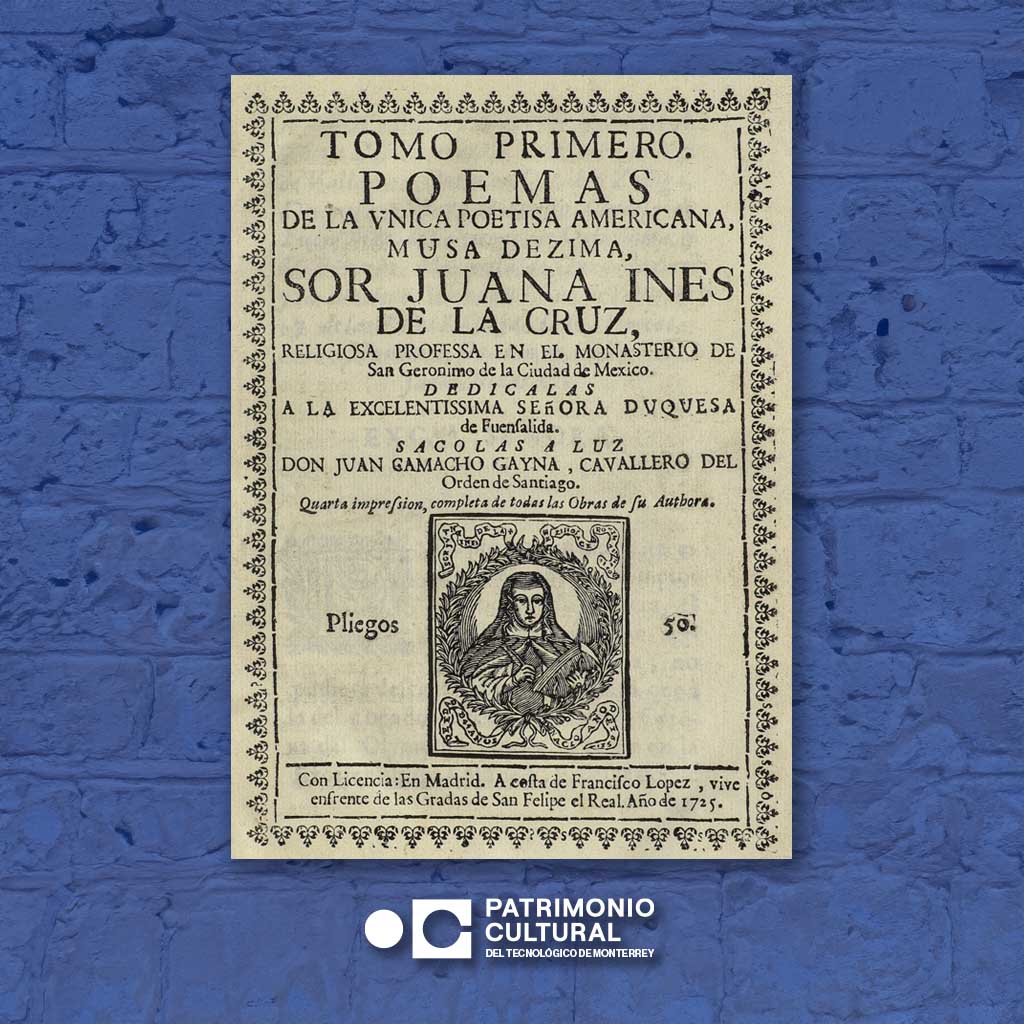
July 2025
Sor Juana Inés de la Cruz (1651-1695), Poems of the Singular American Poet: The Tenth Muse, Sor Juana Inés de la Cruz, professed religious in the convent of Saint Jerome of Mexico City, 1725. Sor Juana Inés de la Cruz Collection. Méndez Plancarte Fund. "Miguel de Cervantes Saavedra" Special Collection Library. Campus Monterrey. Cultural Heritage of Tecnológico de Monterrey©.
The book Poems of the Singular American Poet is the first of two preceding volumes by the Hieronymite nun and was likely used by the humanist religious scholar and great scholar of New Spain poetry and the works of Sor Juan Inés de la Cruz, Alfonso Méndez Plancarte. This copy is part of the collection of the same name and has been housed at the Tecnológico de Monterrey since 1955.
This edition recovers some of the engravings that were made in Fame and posthumous works of Sor Juana Inés de la Cruz published in Madrid by Manuel Ruiz de Murga in 1700. An example of this is the cover of this first volume entitled Poems of the Singular American Poet, in which the image of the Hieronymite nun highlights the entrance to the reading of Sor Juana poems.
This year marks 330 years since the death of the Hieronymite nun Sor Juana Inés de la Cruz, one of the most emblematic figures of New Spain literature and the Golden Age. In honor of her invaluable intellectual and literary legacy, the Cultural Heritage of Tecnológico de Monterrey pays tribute to her work, safeguarding and disseminating her written production, testimony to her genius and her tireless pursuit of Knowledge.
This work is also available for consultation in the Institutional Repository of Tecnológico de Monterrey through the forllowing link: https://hdl.handle.net/11285/657114
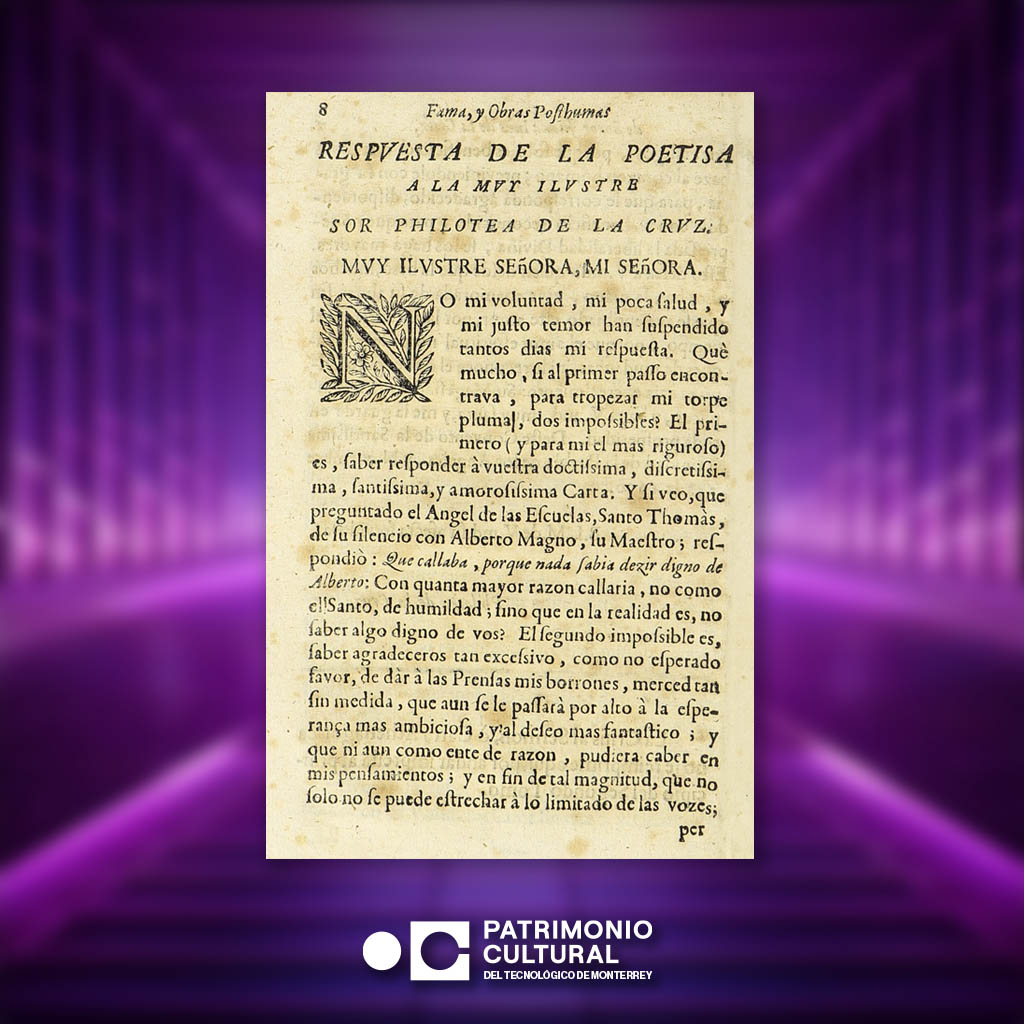
June 2025
Sor Juana Inés de la Cruz (1651-1695), "Reply to Sor Philotez of the Cross" Fame and Posthumous Works of the Mexican Fenix and tenth muse, America's poet, Sor Juana Inés de la Cruz, professed nun in the monastery of Saint Jerome of the Imperial City of Mexico, 1701. First Barcelonian edition. Sor Juana Inés de la Cruz Collection. G.R.G. Conway Fund. "Miguel de Cervantes Saavedra" Special Collection Library. Campus Monterrey. Cultural Heritage of Tecnológico de Monterrey©.
This letter is an answer to the one signed by Sister Filotea of the Cross, pseudonym of Manuel Fernández of the Holy Cross and it precedes the Letter Worthy of Athena from 1690.
Sister Juana Inés of the Cross narrates some autobiographic experiences, related to her intelligence and love for knowledge, at the same time she argues in favor of women´s freedom to learn.
This text, written in March 1691, is paradigmatic of Women´s Rights, of the knowledge of Sor Juana´s life and in the lineage of intelligent women in the History of humankind. Commemorating the 330th anniversary of her death, this work is still a current approach from the Hieronymite nun.
This work is also available for consultation in the Institutional Repository of Tecnológico de Monterrey through the forllowing link: https://hdl.handle.net/11285/657467
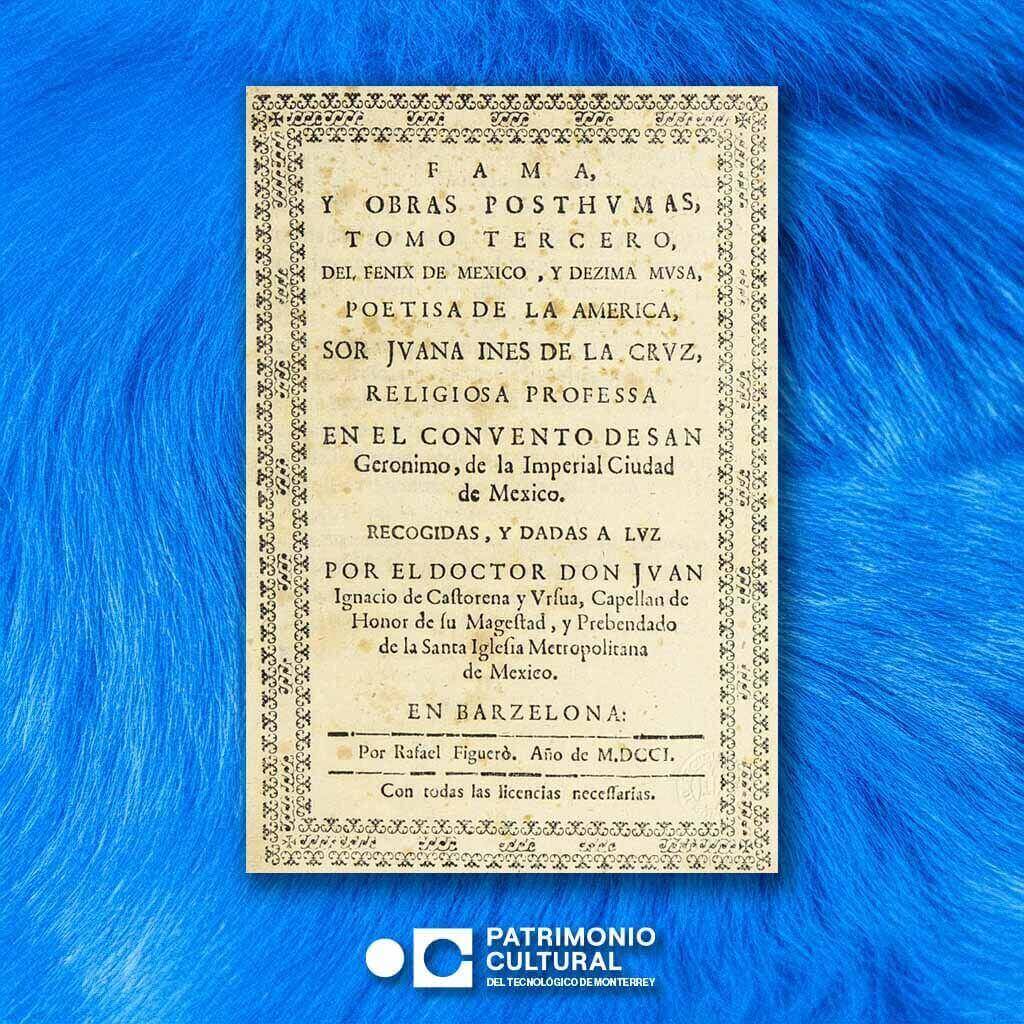
May 2025
Sor Juana Inés de la Cruz (1651-1695), Fame and Posthumous Works of the Mexican Fenix and tenth muse, America's poet, Sor Juana Inés de la Cruz, professed nun in the monastery of Saint Jerome of the Imperial City of Mexico, 1701. First Barcelonian edition. Sor Juana Inés de la Cruz Collection. G.R.G. Conway Fund. "Miguel de Cervantes Saavedra" Special Collection Library. Campus Monterrey. Cultural Heritage of Tecnológico de Monterrey©.
This book compiles, posthumously, the known Complete Works by Sor Juana Inés de la Cruz in 1700, it was first published in Madrid.
This copy consists in the 3rd edition of Fame and Posthumous Works and the first printed in Barcelona en 1701, which shows the importance and impact of the Hieronymite nun in Spain.
In this book was published the "Response to Sor Filotea de la Cruz", which includes valuable biographical information of Sor Juana. Commemorating the 330th anniversary of her death, this work is the featured item of the month.
This work is also available for consultation in the Institutional Repository of Tecnológico de Monterrey through the forllowing link: https://hdl.handle.net/11285/657467
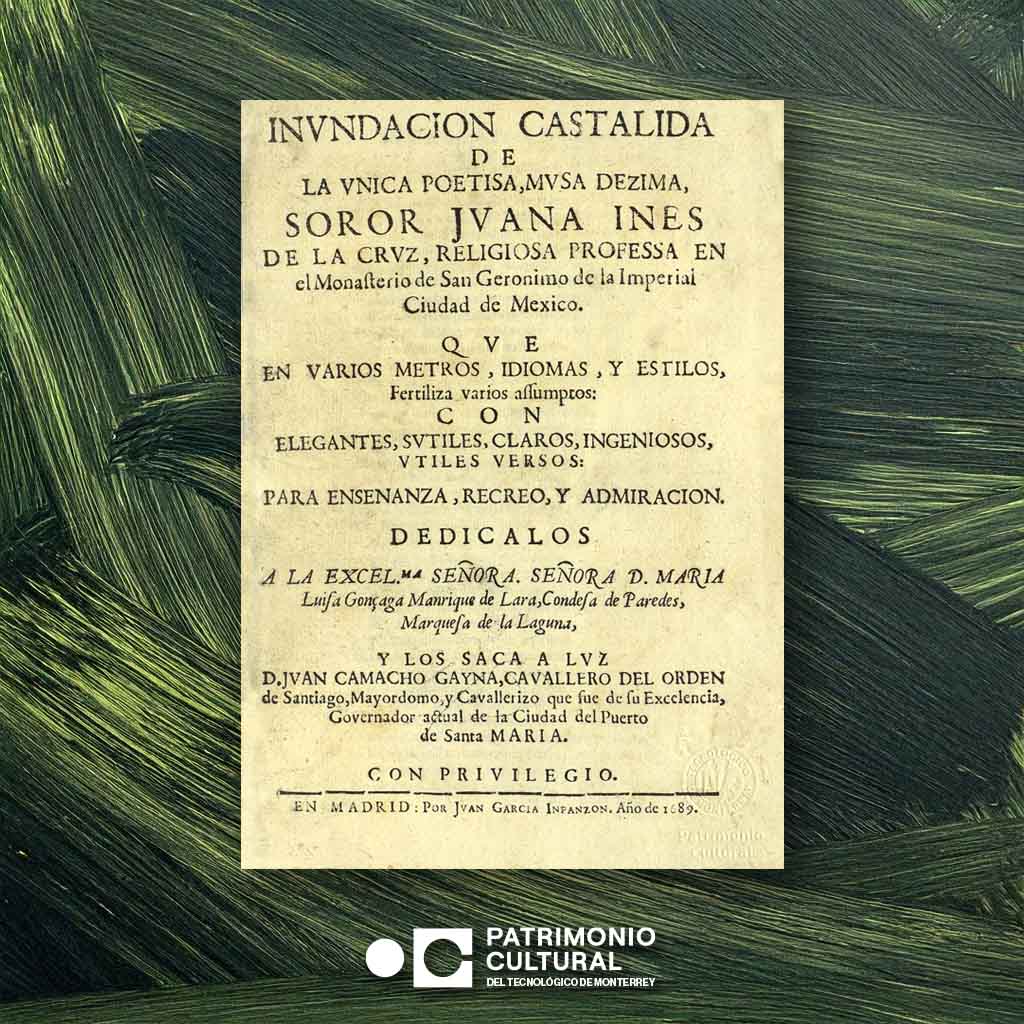
April 2025
Sor Juana Inés de la Cruz (1651-1695), The Castalian Flood of the unique poet, tenth muse, Sor Juana Inés de la Cruz, professed nun in the monastery of Saint Jerome of the Imperial City of México, 1689. First edition. Sor Juana Inés de la Cruz Collection. Méndez Plancarte Fund. "Miguel de Cervantes Saavedra" Special Collection Library. Campus Monterrey. Cultural Heritage of Tecnológico de Monterrey©.
Castalian Flood is the first publication to compile Sor Juana's work in a single volume. It was published in 1689 in Madrid, thanks to the support of her friend and protector, Viceroy María Luisa Manrique de Lara y Gonzaga, Countess of Paredes and Marchioness of La Laguna.
The title is based on the myth of nymph Castalia, who lived in the fountain of the same name, consecrated to the Muses. This fountain was believed to have the power to inspire poets, a reference to the Hieronymite nun's abundant creativity and inspiration.
This book became Sor Juana's calling card in Europe and was a huge success, having been reissued nine times, establishing itself as a true bestseller. In the month commemorating the 330th anniversary of her death, this work, which made her known wordwide, is the featured item of the month.
This work is also available for consultation in the Institutional Repository of Tecnológico de Monterrey through the forllowing link: https://hdl.handle.net/11285/657107
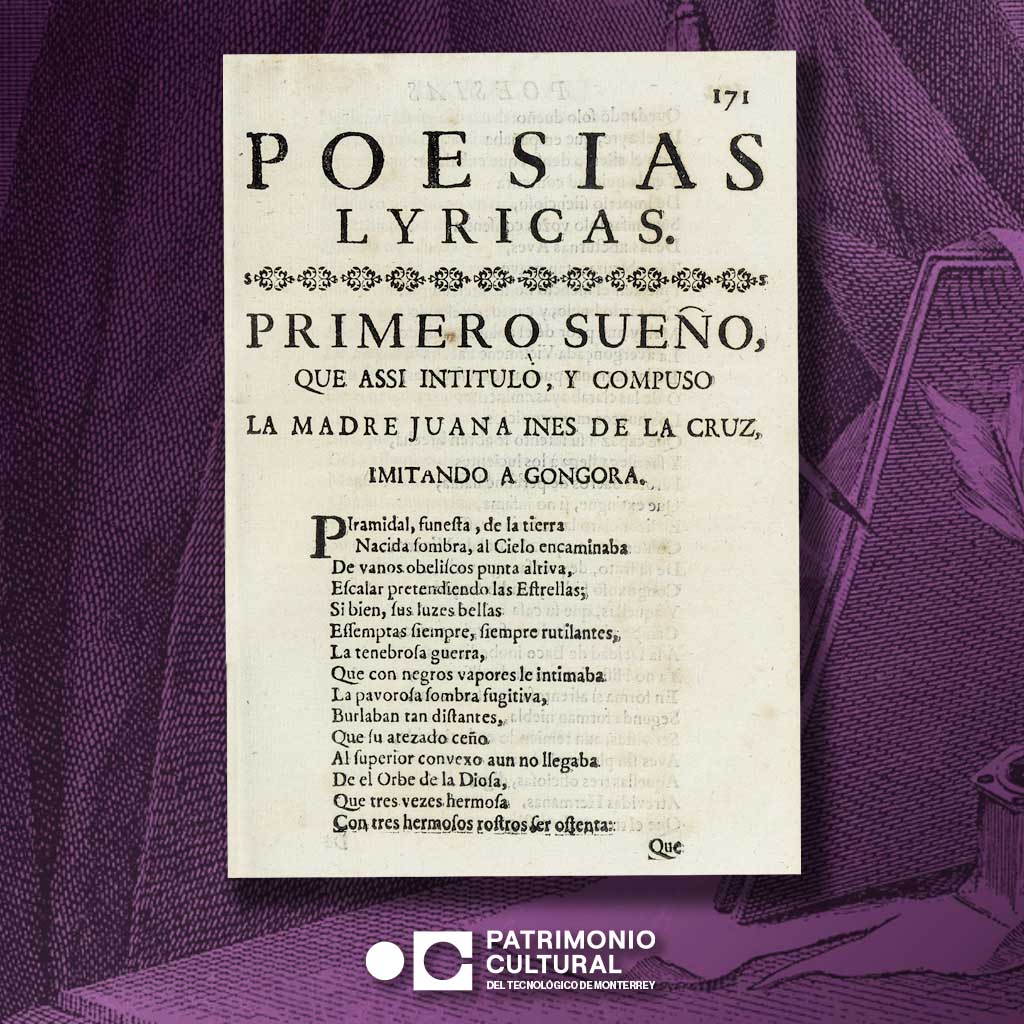
March 2025
Sor Juana Inés de la Cruz (1651-1695), "First Dream", Second Volume of the Works Sor Juana Inés de la Cruz, professed nun in the monastery of Saint Jerome of Mexico City, 1693. Sor Juana Inés de la Cruz Collection. G.RG. Conway Fund. "Miguel de Cervantes Saavedra" Special Collection Library. Campus Monterrey. Cultural Heritage of Tecnológico de Monterrey©.
The Dream, as Sor Juana Inés de la Cruz referred to in her poem, became known in 1690. It explores the soul´s journey towards knowledge in 975 verses. This is the only text that the Hieronymite nun confessed writing with pleasure.
This poem was first published in the Second Volume´s Sevillian edition in 1692. A year later, Joseph Llopis printed and paid for a Barcelonian edition. This copy belonged to the Mexican bibliophile Joaquín García Icazbalceta.
2025 marks the 330 years of the deperture of Sor Juana Inés de la Cruz. Cervantes´ Library pays tribute to her by selecting this poem as March´s Monthly Showcase.
This work is also available for consultation in the Institutional Repository of Tecnológico de Monterrey through the forllowing link: https://hdl.handle.net/11285/657429
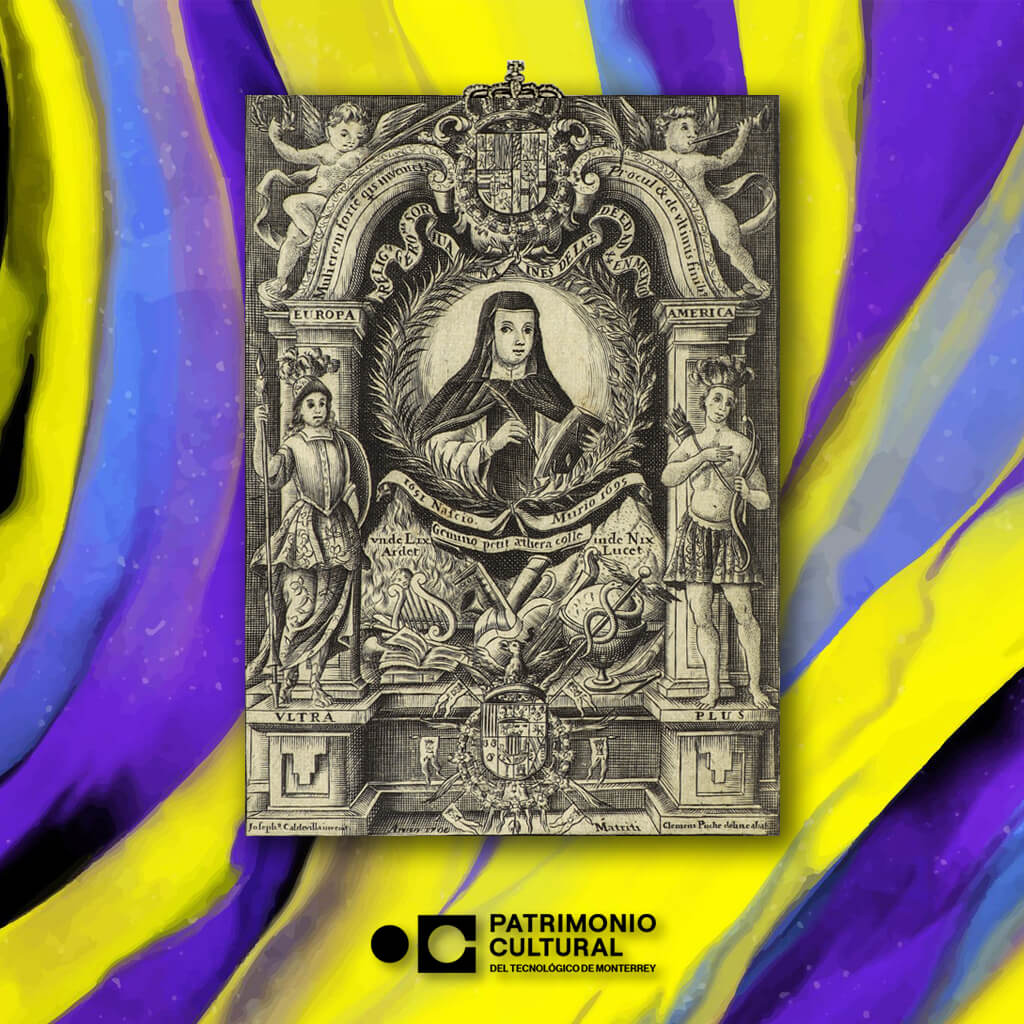
February 2025
Sor Juana Inés de la Cruz (1651-1695), Frontispiece to Poems of the Singular American Poet: The Tenth Muse, Sor Juana Inés de la Cruz, professed religious in the convent of Saint Jerome of Mexico City, 1725. Méndez Plancarte Fund. "Miguel de Cervantes Saavedra" Special Collection Library. Campus Monterrey. Cultural Heritage of Tecnológico de Monterrey©.
The frontispiece is a reproduction of the engraving that appeared in the first edition of Fame and Posthumous Works, published in Madrid by Manuel Ruiz de Murga in 1700. In the field of ilustration, a frontispiece is an image that functions as a cover, as the initial facade of a book.
The engraving was made by Joseph Caldevilla based on a drawing by Clemente Puche and represents Sor Juan Inés de la Cruz in the center, symbolizing a bridge between Europe and America. At the top, on one of the bars on the right, the figure "44 years" can be seen, referring to the age at which he died. This edition, published in Madrid in 1725, consists of three volumes and belonged to Alfonso Méndez Plancarte, who directed the project of the complete works of Sor Juana Inés de la Cruz for the Fondo de Cultura Económica.
This year marks 330 years since the death of the Hieronymite nun Sor Juana Inés de la Cruz, one of the most emblematic figures of New Spain literature and the Golden Age. In honor of her inavaluable intellectual and literary legacy, the Cervantina Library of the Tecnológico de Monterrey pays tribute to her work, safeguarding and disseminating her written production, testimony to her genius and her tireless pursuit of Knowledge.
This work is also available for consultation in the Institutional Repository of Tecnológico de Monterrey through the forllowing link: https://hdl.handle.net/11285/657114
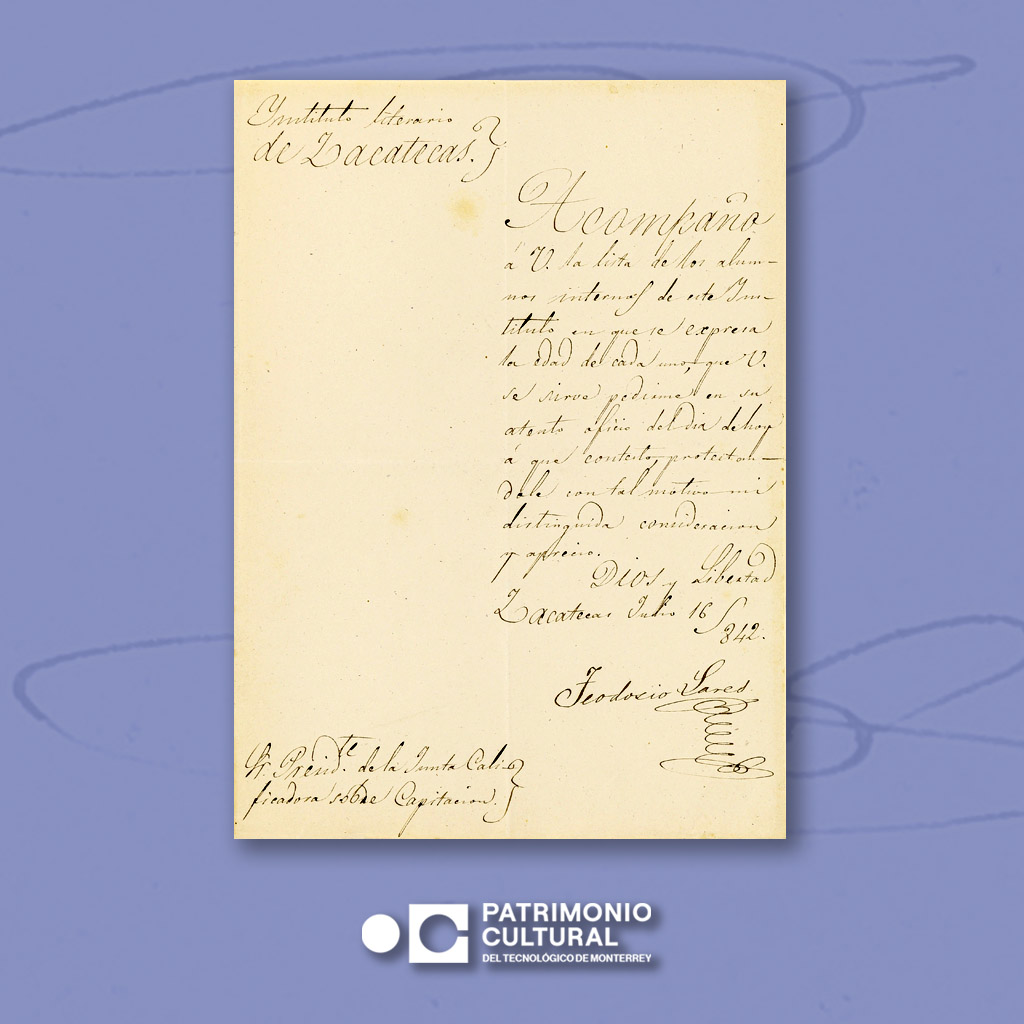
January 2025
Teodosio Lares, Letter to the Board of Directors of the Public Treasury of the State of Zacatecas, 1842. Historical Archive Fund of Real Caja de Zacatecas 1576-1936. Collection of the Society of Friends of Zacatecas, A.C. on loan to Tecnológico de Monterrey©. Memory of the World Registry of Mexico, UNESCO, 2021. Cultural Heritage of Tecnológico de Monterrey©.
Teodosio Lares (1806-1870) was a prominent lawyer, politician, writer, humanist and prominent member of the Mexican Athenaeum, who wrote this letter to inform the treasury authorities about the number of students accepted at the Literary Institute of Zacatecas (1837-1867).
Lares was the director of the institute from 1834 to January 1848 and taught Civil and Canon Law at the same school. The Literary Institute of Zacatecas was established as a public education center, financed with state revenues, run by a lay director where the teaching for students ranged from secondary to professional studies. His participation in this institute is relevant, since it created the different levels of public education from the first letters to professional.
155 years after his death, we remember Teodosio Lares for his great contributions to the country's public education, for his contribution in the administrative field in the Bankruptcy Bill and in the Organization of Contentious Justice.
Past years
January, 2019
Yvonne Domenge, Clytia, 2000, Steel. Campus Estado de México. Cultural Heritage of Tecnológico de Monterrey©.
The sculptor invites us to look at that crossroads that would seem to not exist between science and art. Clytia is a monumental sculpture that is located halfway between the professional and high school areas of the Tecnológico de Monterrey at “Estado de México”, next to the tunnel that leads to the parking lots is the geographic center of the campus. Clytia in Greek mythology was a nymph of the sea who had fallen in love with Helios, realizing that he did not love her Leucótoe, took revenge. The gods, knowing it, turned it into a heliotrope. The title of the work adduces a sea creature that is ethereal, and its ungraspable love.
-Carlos A. Molina
February, 2019
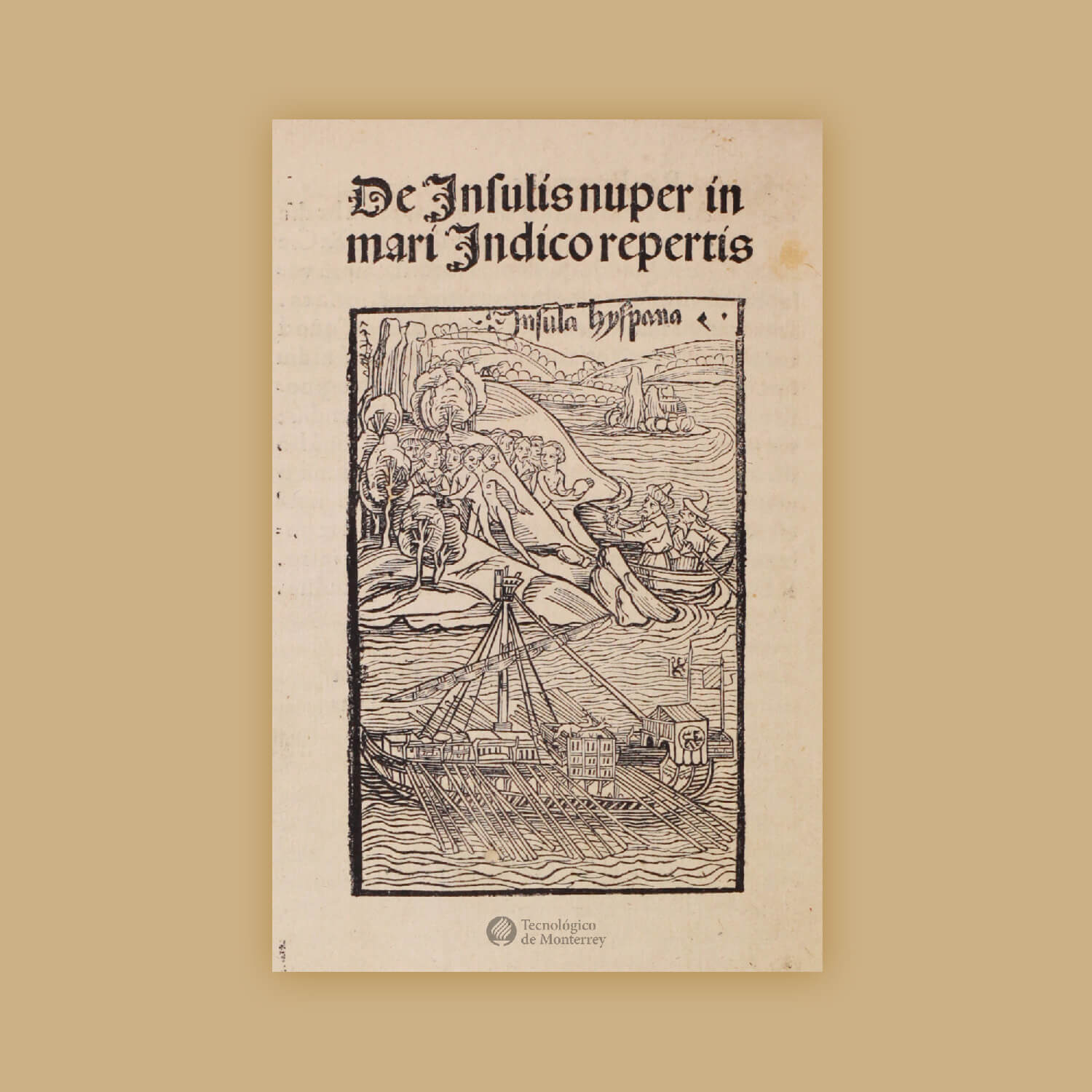
Christopher Columbus, De Insulis nuper in Mari Indico repertis (Columbus' Second Letter), 1494. Salvador Ugarte Fund, "Miguel de Cervantes Saavedra" Special Collections Library. Campus Monterrey. Cultural Heritage of Tecnológico de Monterrey©.
The document “De Insulis nuper in mari Indico repertis” consists of the second letter of Christopher Columbus. Its title translates to “The islands have been recently discovered in the Indian Sea”. This letter is addressed to King Ferdinand and Gabriel Sánchez, and is a Latin translation of the first letter describing what happened on the voyage of discovery. The letter was printed in several copies in Basel, Switzerland. This safeguarded copy in the Library of Special Collections “Miguel de Cervantes Saavedra” is preceded by the “Baetic History” of Carlos Veradi, whose printing date is April 21st, 1494. The importance of this material lies in being one of the first best-sellers of the time, through which the news of the discovery of the New World could spread, since the Latin version was the most circulated document across Europe as of its publication.
March, 2019
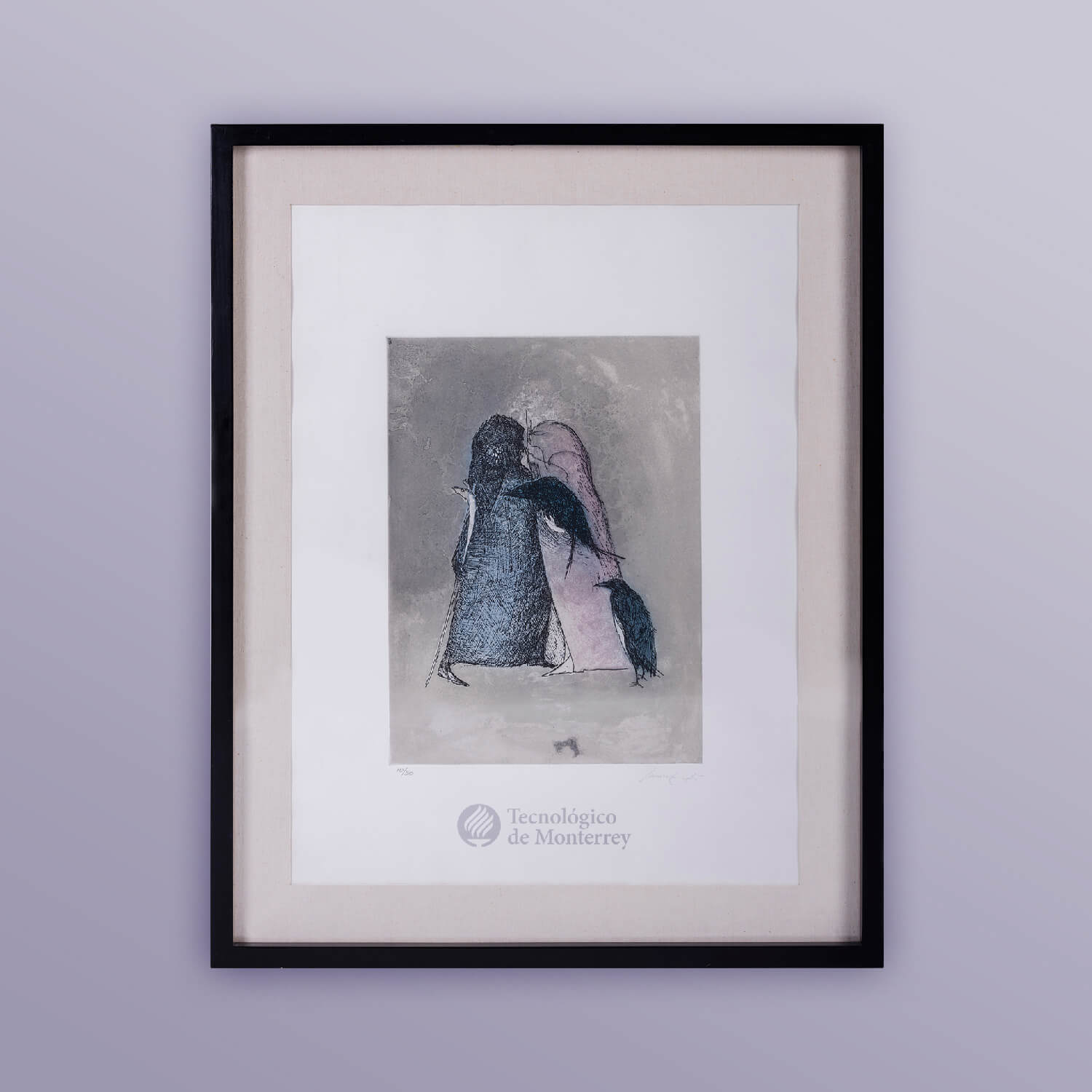
Leonora Carrington (1917-2011), Two figures with crows, n/d, Lithography 62cm x 47 cm GRA / 273. Campus Estado de México. D.R.© Leonora Carrington/ARSNY/SOMAAP/México/2023. Cultural Heritage of Tecnológico de Monterrey©.
Leonora Carrington was a descendant of a wealthy English family. Fleeing the terrible situation experienced after the capture of his partner, the surrealist painter Max Ernst, in World War II, she arrived in Mexico in 1942. Her work, considered surrealist, is loaded with the iconography of the Celtic tradition, modern literature English, and the indigenous folklore that she met in Mexico. This lithography portrays two figures that converse with crows that accompany them. The contrasting colors, from the nebula to the background, suggest a cave or a covered forest, and have an emblematic charge: both peculiarities of the painting are not incidental or decorative. Her work is committed not to reveal the keys to decipher and freely associate figures, motives, memories, and colors.
April, 2019
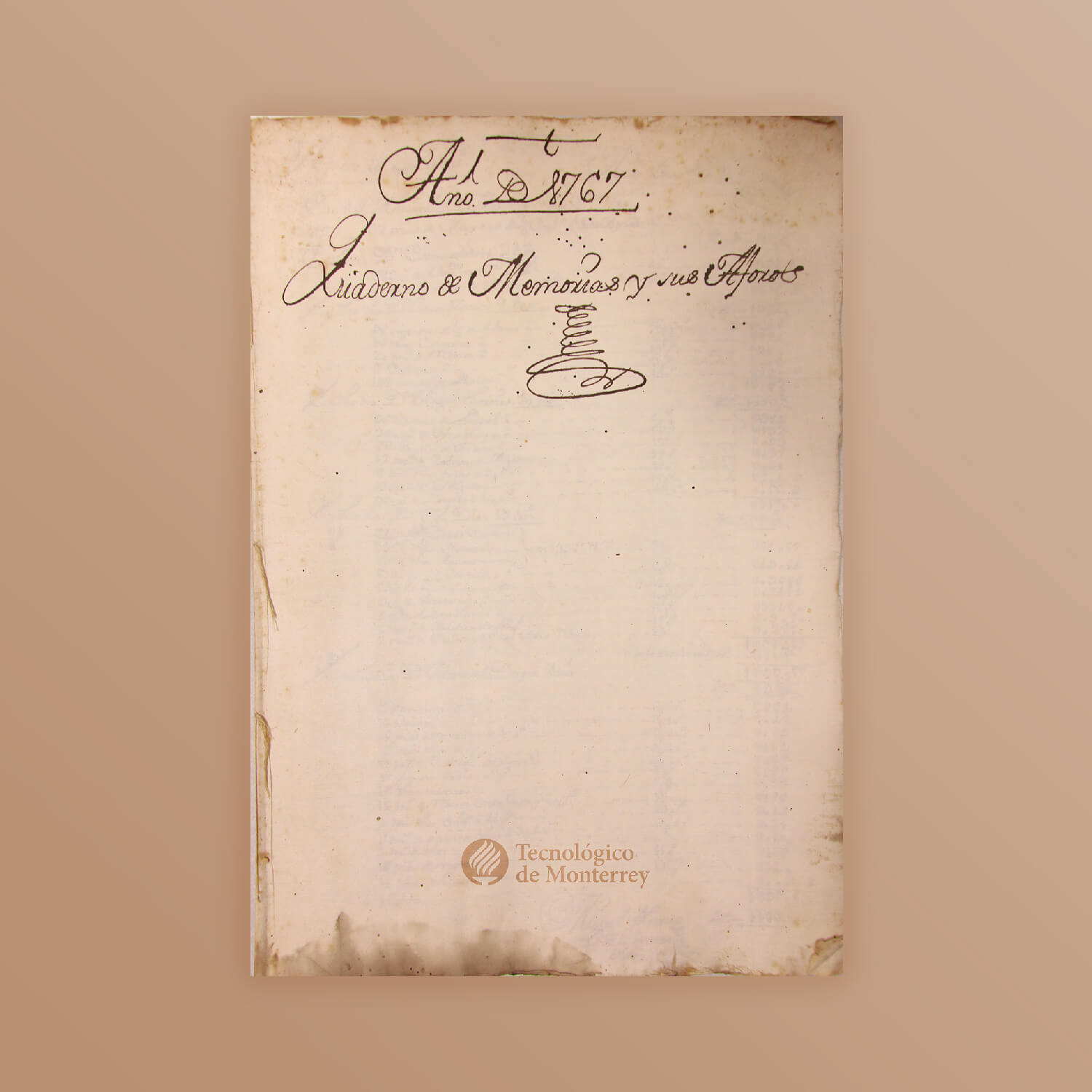
Cuaderno de Memorias y sus aforos (manuscript), 1767. Historical Archive Fund of Real Caja de Zacatecas, 1576-1936. Collection of the Society of Friends of Zacatecas, A.C. on loan to Tecnológico de Monterrey©. Memory of the World Registry of Mexico, UNESCO, 2021. Cultural Heritage of Tecnológico de Monterrey©.
The value of a good for the payment of rights was a tax that was charged to the merchants for the products and merchandise that they brought into the cities, in this case Zacatecas. In the “Cuaderno de Memorias y sus Aforos” of 1767, the products and merchandise that entered to the city during that year, were registered. The annotations drawn up by the royal officers for the collection of the alcabala (tax for any product, merchandise, rent or trading in a city), were very prompt, since they append: day, month, merchant, quantity of products or merchandise per registration, price, the total of the product or merchandise and by last, the tax that had to be paid. All the sheets of the “Cuaderno de Memorias” are initialed or signed by the royal officer.
This document is available for consultation in the Institutional Repository of Tecnológico de Monterrey through the following link: https://hdl.handle.net/11285/638080
May, 2019
Irma Palacios, Memoria en bronce, 1995. Bronze cast by lost-wax (110 x 90 cm diameter). Campus Estado de México. Cultural Heritage of Tecnológico de Monterrey©.
The artist from Guerrero was born in 1943, from a young age was part of the group of creators after the rupture, who were interested in a more lyrical and international type of art, and sought to eliminate the pretensions of the movements or groups of the 60s and 70s. The work of this artist, belonging to the collection of the Tecnológico de Monterrey, Memory in bronze, is interwoven with touches of lyricism and architectural structures, which force her to see almost hidden. The work presents a large body that appears to be stone, and two small masts that simulate branches of a tree. Her work has been cataloged as part of lyrical abstractionism, where the most notable precedent in our country was the artist Lilia Carrillo.
June, 2019
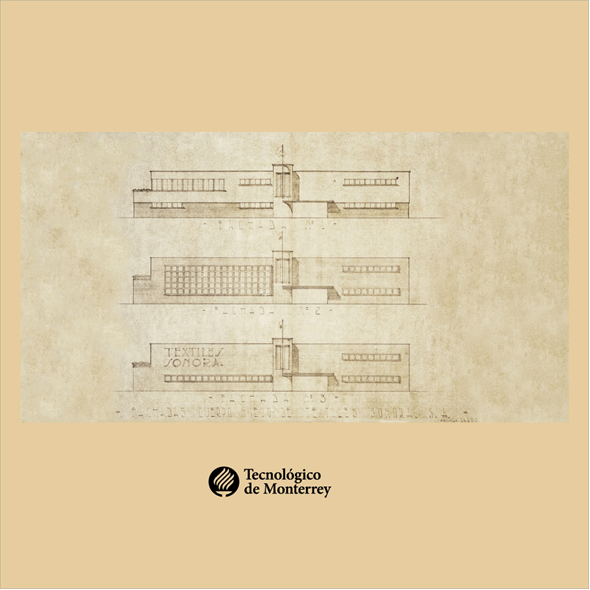
Gustavo Aguilar Beltrán, Fachadas de Textiles de Sonora, S.A., 1945. Gustavo Aguilar Beltrán Archive. Campus Sonora Norte. Cultural Heritage of Tecnológico de Monterrey©.
Textiles Sonora was a project promoted by the Rivero Solano brothers and designed by the architect Gustavo Aguilar Beltrán in Hermosillo, Sonora in 1945. This would become one of the most important cotton manufacturing factories in the country and would open many opportunities for economic growth in the region through the manufacture of local textiles. This image is part of the Fund of Arch. Aguilar Beltrán.
August, 2019
Yolanda Andrade, El niño y el infierno, 1985, Gelatin Silver, 22 x 30 cm. Campus Estado de México. Cultural Heritage of Tecnológico de Monterrey©.
The rate at which Mexico City and Metropolitan zone grew up after the 70's and until the earthquake in 1985, date this photo was taken, was absolutely unexpected. The little boy which challenging look imprecate us since “El niño y el infierno”, taken by Yolanda Andrade (n. 1950), is one of those Mexicans of that apparent underworld. Her practice has always taken place at the streets, portraying the everyday life, teaching her students to look at bias, to see again what happens unnoticed daily. Andrade was a photography teacher at the Tecnológico de Monterrey. There, she taught to look and match statements about challenging conditions in the present with the construction of possibilities for the future. This work is in shelter at the Tecnológico de Monterrey in the State of Mexico - Carlos Molina
-Carlos A. Molina
September, 2019
Manuel Maples Arce (illustrated by Jean Charlot), Vrbe. Super-poema bolchevique en 5 cantos, Mexico City, 1924: Andrés Bota and Sons Publishers. Porfirio Martínez Peñalosa Fund. Campus Querétaro. Cultural Heritage of Tecnológico de Monterrey©.
Vrbe, written in 1924 by Manuel Maples Arce, is the most representative work of stridentism – leading avant-garde artistic movement in Mexico. This literary work adopts ideas of soviet socialism in the early 20th century and, at the same time, an aesthetic expression related to European avant-garde. It first edition was published in Mexico City and it has illustrations made by the French painter Jean Chariot. A copy of this edition is part of the Porfirio Martínez Peñalosa Archive, which is protected by the library of Queretaro campus.
October, 2019
Arnaldo Coen, El sonido que disgrega, n/d, oil on canvas, 80 x 100 cm. Campus Estado de México. Cultural Heritage of Tecnológico de Monterrey©.
Arnaldo José Coen Ávila (n. 1940) has worked diverse disciplines, wondering how are they distinguished from each other. He innovates in the media by adding technology to the practice of painting, making graphic descriptions about he structure of musical pieces, creating sculptures and making interventions in various museographies. El sonido se disgrega (The Sound Breaks Up), speaks of light beams that come and go from the surface of the painting to our eyes, decompose in a myriad of colors and remind us that the images we relate to music work in a very similar way: causing our perception to sharpen by noticing three dimensions.
-Carlos A. Molina
November, 2019
José Guadalupe Posada (1852-1913), Skulls from the heap no. 8, 1910. Zincography, 36 x 26 cm. Campus Estado de México. Cultural Heritage of Tecnológico de Monterrey©.
José Guadalupe Posada (1852-1913) was an engraver, draftsman and illustrator of the late nineteenth and early twentieth centuries whose practically anonymous work has become part of the imaginary of "the Mexican." He was born in Aguascalientes, studied drawing at the Municipal Academy of Drawing in Aguascalientes and at sixteen years old he entered as an apprentice to the lithographic workshop of Trinidad Pedroza. At the end of 1888 he moved to Mexico City, to collaborate in the newspaper La Patria Ilustrada de México, where he learned the techniques of lead and zinc engraving. He worked in other workshops, however, his collaboration with the printing press of Vanegas Arroyo, with which he made the Calaveras del heap. These were loose sheets that portrayed the famous calaveritas written in verse, with which allusion is made to death in a wry and mocking way, taking advantage of historical or recent situations. In this image we appreciate a skull of a peasant and revolutionary, who holds a bottle of brandy, and who carries a serape. The verses tell the different situations of local people, the baker, the butcher, the pulquero, the shoemaker, however, the mention in two stanzas of Francisco I. Madero stands out.
December, 2019
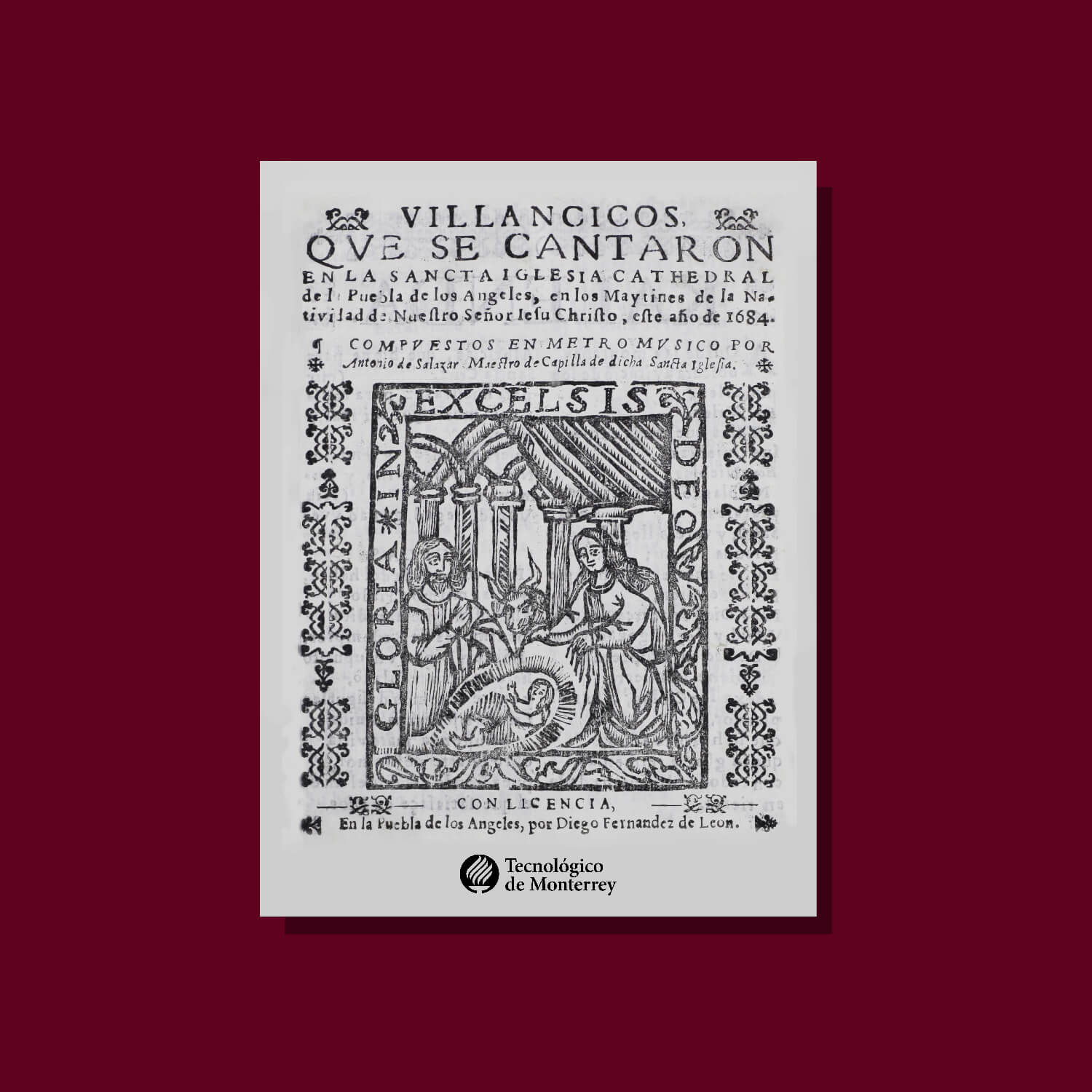
Antonio de Salazar, Villancicos que se cantaron en la Sancta Iglesia Cathedral de la Puebla de los Angeles, en los Maytines de la Natividad de Nuestro Señor Iesu Christo, este año de 1684. Conde Zambrano Fund. "Miguel de Cervantes Saavedra" Special Collections Library. Campus Monterrey. Cultural Heritage of Tecnológico de Monterrey©.
This work dates back to 1684, it consists of an eight-page booklet in eight major formats and is probably the first edition of The villancicos of the Nativity. This specimen is pasted in miscellany of 16 villancicos from Puebla and has fire mars on the three edges. The cover consists of a baroque deign that represents the birth of Christ with the main elements: the presence of Joseph, Mary, Jesus, an ox that witnesses the birth, and the manger along with the Latin words “Gloria in Excelsis Deo”, words that according to Christian tradition, angels used to inform the shepherds of the new news. These villancicos were sung between midnight and dawn on December 25 of that year.
January, 2020
Jorge González Camarena, El Quijote en Monterrey (1954), oil on wood. "Miguel de Cervantes Saavedra" Special Collections Library. Campus Monterrey. Cultural Heritage of Tecnológico de Monterrey®.
This artwork, presented in a wide, landscape format, shows an image of Don Quixote besides the Cerro de la Silla and La Huasteca, two of the most representative mountains of the city of Monterrey. Other highlights in this work include the characters of Cervantes’ classic novel: Rocinante (Don Quixote’s horse), Sancho Panza, and the Donkey. An image of a balance, as a symbol of justice, also appears in this painting.
Febrero, 2020
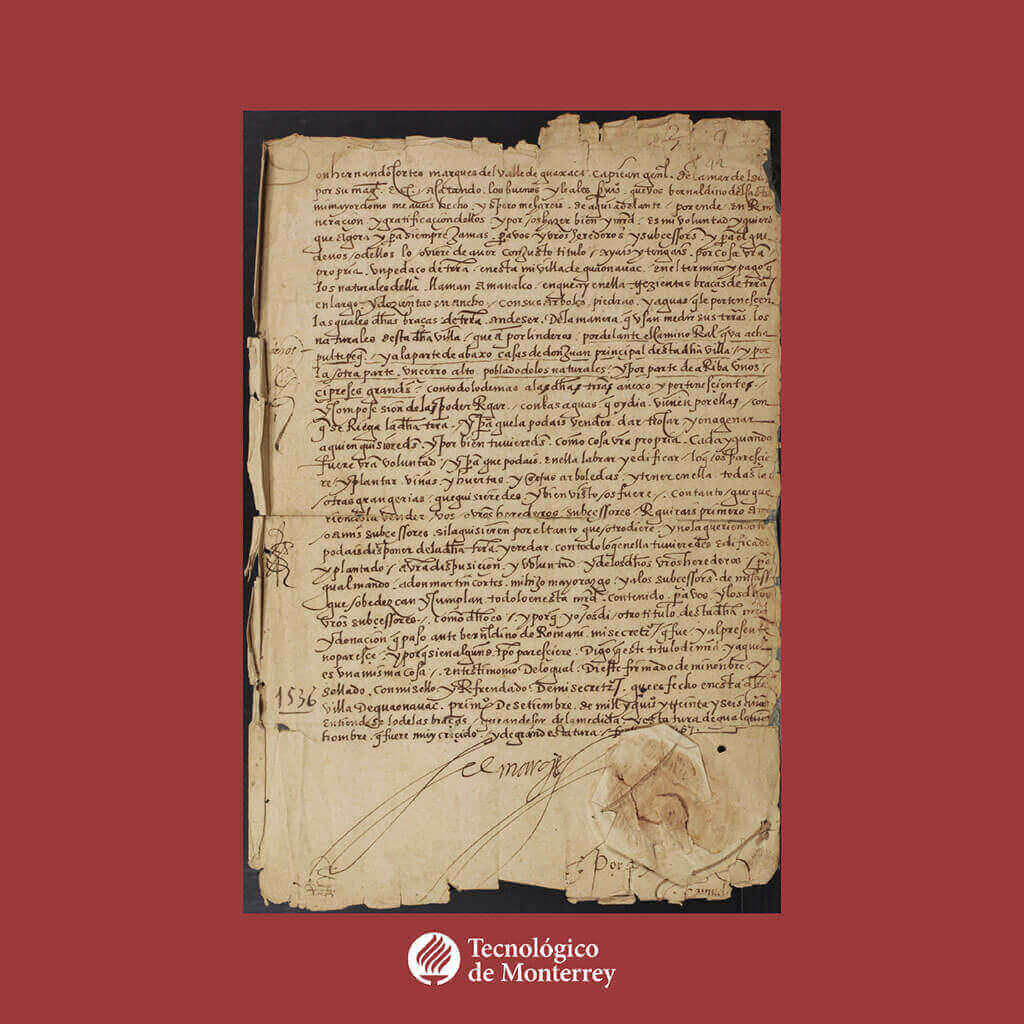
Hernán Cortés, Title of a land concession, made by Hernán Cortés to Bernardino del Castillo, his servant (manuscript), Cuernavaca, 1536. G.R.G Conway Fund. "Miguel de Cervantes Saavedra" Special Collections Library. Campus Monterrey. Cultural Heritage of Tecnológico de Monterrey®.
A document dating from the sixteenth century where Hernán Cortés gave a portion of his land to Bernardino del Castillo. In this paper, we can appreciate the autograph signature of the Marqués del Valle de Oaxaca (Hernán Cortés), title which was given by Carlos V on July 6, 1529, as a reward for Cortes' services to the crown. This work is part of the G.R.G. Conway Fund, which includes several historical documents from this period and was collected by the engineer and historian George Robert Graham Conway.
This document is available for consultation in the Institutional Repository of Tecnológico de Monterrey through the following link: http://hdl.handle.net/11285/622402
April, 2020
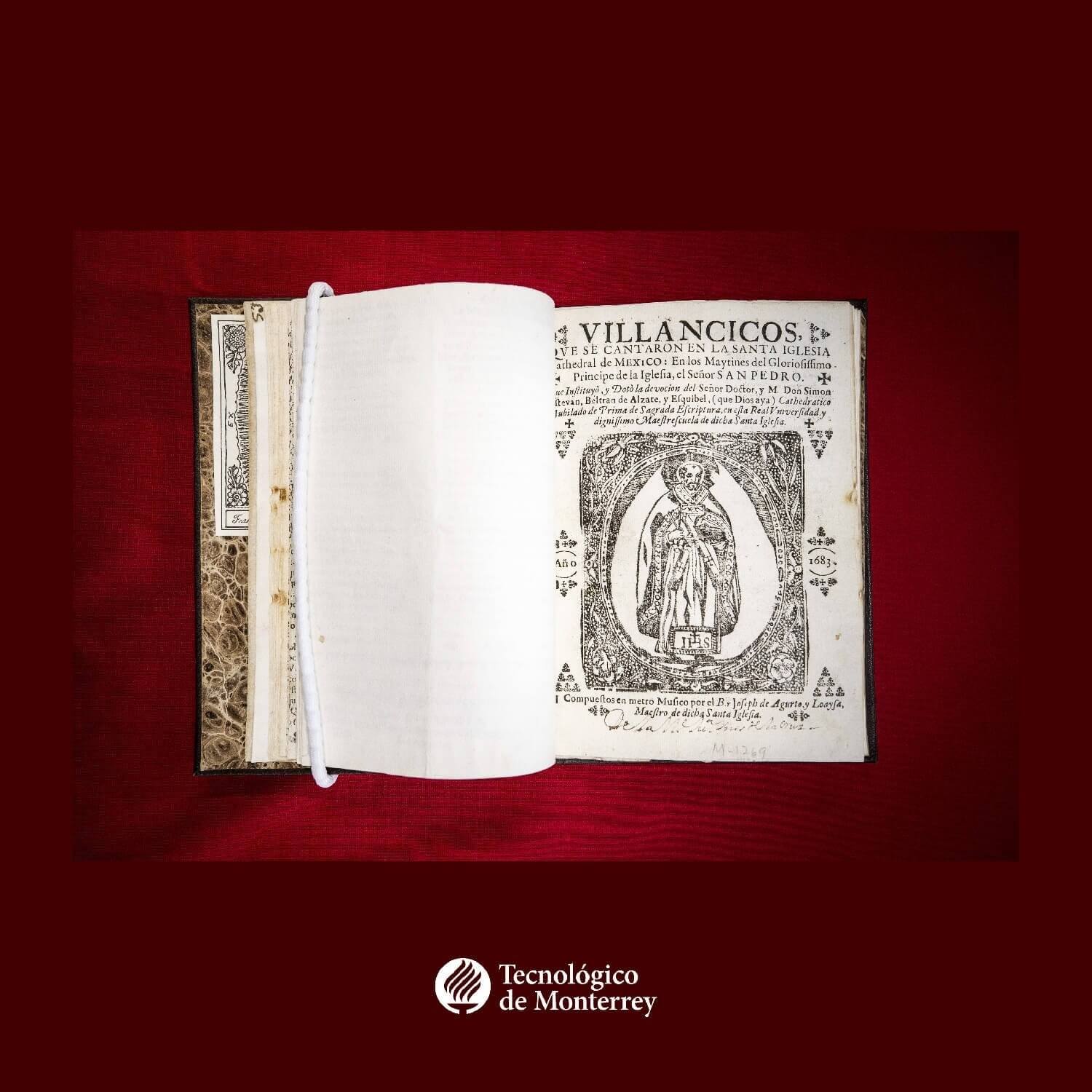
Sor Juana Inés de la Cruz, Villancicos a San Pedro Nolasco, 1677. Salvador Ugarte Fund. "Miguel de Cervantes Saavedra" Special Collections Library. Campus Monterrey. Cultural Heritage of Tecnológico de Monterrey®.
This work dates from 1677 and consists of an eight-page booklet which is probably the first edition of the Villancicos to San Pedro Nolasco. This issue has a special interest, as it includes some corrections and comments in the margins and on the text written in ink by Sister Juana herself, as well as her name on the cover.
May, 2020
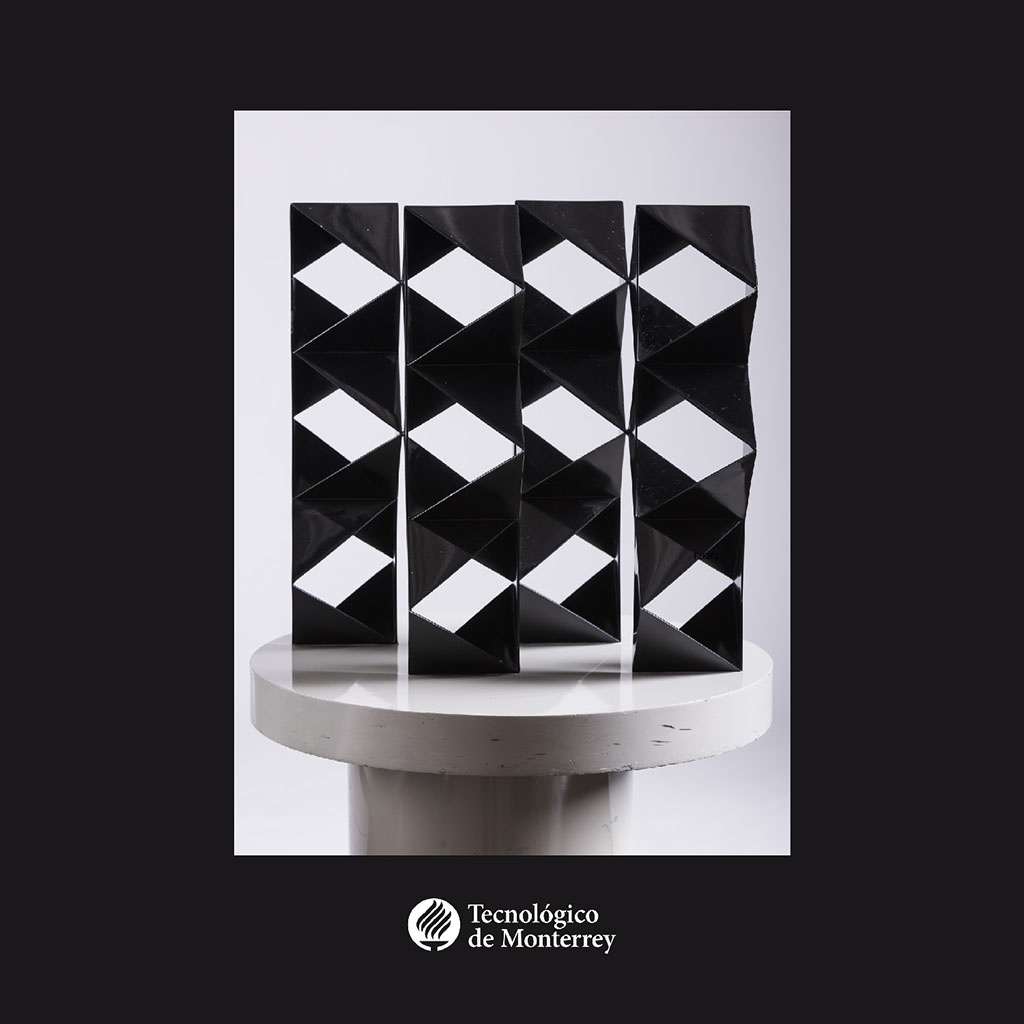
Jesús Mayagoitia (b. 1948), Four Towers, 1991, painted iron. Campus Estado de México. Cultural Heritage of Tecnológico de Monterrey®.
Photo: Luis Enrique Sandoval
Jesús Mayagoitia is a world-renowned artist whose interest has always been quality in sculpture production and aesthetic education for all. He has always been interested in the various functions that geometric bodies project onto a plane, the way in which we perceive them in space, and how we relate with it. Cuatro Torres is a revolving sculpture whose pedestal has a motor inside that forces you to perceive from different angles the shapes and spaces it creates. Winner of the Henry Moore Prize in 1987, Mayagoitia is not only a creator but a promoter and teacher in Mexico since the 1970s at the National School of Plastic Arts, now the Faculty of Arts and Design at UNAM.
June, 2020

Ramusio Giovanni Battista (1556), Terzo volume delle navigationi et viaggi..., 1556. Salvador Ugarte Fund. "Miguel de Cervantes Saavedra" Special Collections Library. Cultural Heritage of Teconológico de Monterrey®.
Ramusio, Giovanni Battista (1485-1557) was an Italian diplomat, geographer, and humanist of the Republic of Venice and is known as the author of the first geographical treatise of the modern era. He was part of the court of the French King Louis XII, where he served in french exploration in North America since the Republic of Venice at that time was very interested in sea routes to America. Delle Naviagationi et Viaggi is known as his most important work since it is the first modern geographical layout, published between 1550 and 1606. This work complies with various accounts of travel and exploration dating from explorations in classical antiquity to the 16th century. The copy shown is the first edition of the third volume. A facsimile copy was included in the exhibition Visión de Anáhuac. Alfonso Reyes, held at the National Museum of Anthropology between December 2019 and March 2020.
July, 2020
José Reyes Meza (1924-2011), History of medicine, 1969, murals. Medical school, CITES. Cultural Heritage of Tecnológico de Monterrey®.
This mural was originally designed for the lobby at the headquarters of Farmacia Benavides in Monterrey. It was bought in 2001 by the Tecnológico de Monterrey; it represents the synthesis of the history of medicine from prehispanic to our modern times. In February of 2019, due to the demolitions for the remodeling of the campus, efforts were made to rescue the piece and relocate it to the medical school, CITES. Jorge Reyes Meza is considered among the last greatest muralists of the Mexican avant-garde. His work can be found in public and private collections in Mexico and the United States such as the National History Museum and the Phoenix Art Museum.
In the Revista Institucional Campus Cultural an article was published about the author and mural.
August, 2020
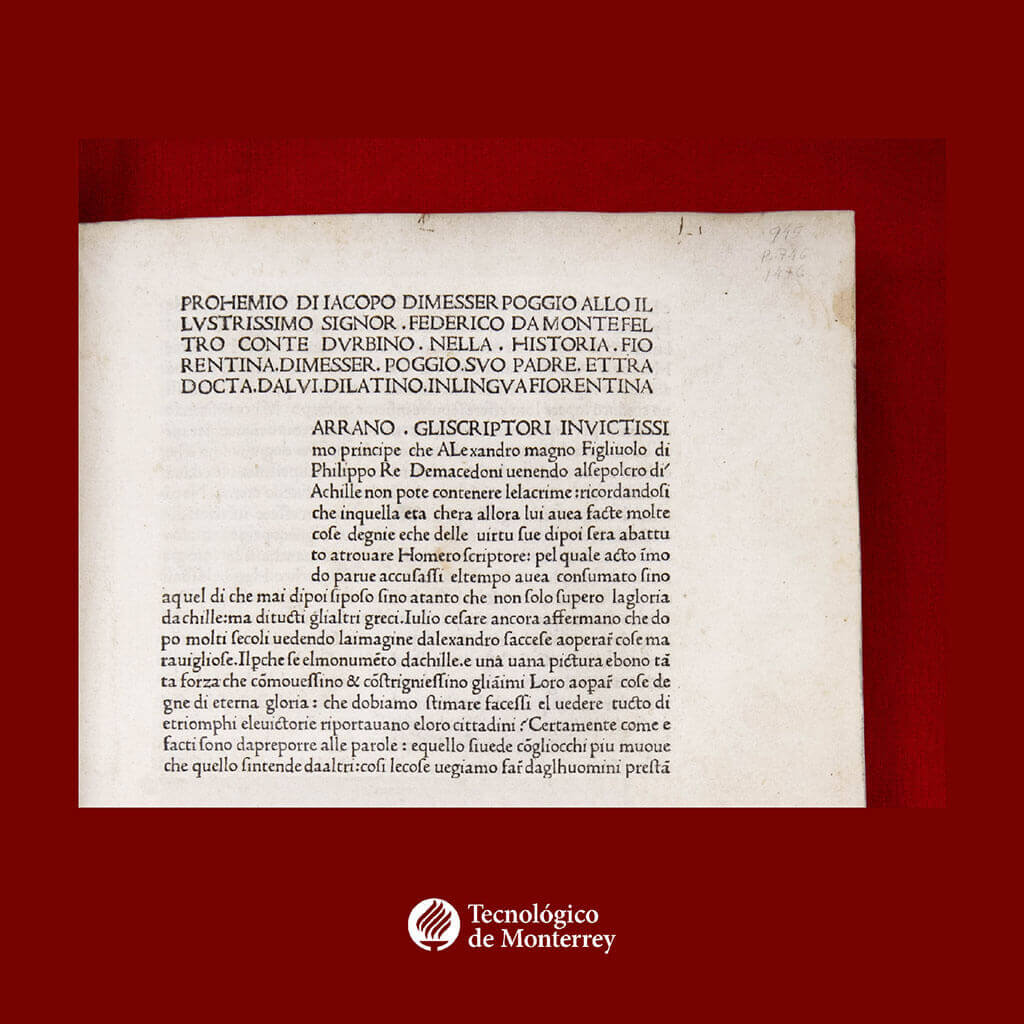
Bracciolini, Poggio (1476), Historia Fiorentina, 1476. Salvador Ugarte Fund. "Miguel de Cervantes Saavedra" Special Collections Library. Campus Monterrey. Cultural Heritage of Tecnológico de Monterrey®.
Bracciolini, Poggio (1380-1459) is known as one of the most eminent humanists and calligraphers during the early Renaissance. This author created the humanistic manuscripts which served as the prototype for Roman fonts for the new art of printing. Florentine History, published in 1476, arises from this author's interest in studying and compiling Greek and Latin manuscripts as well as the buildings and sculptures that led him to inquire more in his later years about the history of Florence. This particular book is part of the Incunabula collection of the Tecnológico de Monterrey.
September, 2020
Jorge González Camarena (1908-1980), Microcosmos, lobby of the Rectory Building. Campus Monterrey. Cultural Heritage of Tecnológico de Monterrey®.
Microcosmos is one of the murals made as a diptych in the lobby of the current rectory. Both address the origin of life and the universe. The left side, Microcosmos, describes from the base of the mosaic the emergence of life from the earth and culminates in a human figure interconnected with the trunk and roots. The character's posture reminds us of the Vitruvian man of Leonardo da Vinci's study of ideal proportions. The arms of this figure, unlike the trunk, seem artificially designed and could be interpreted as the human tool for the construction of civilization. They frame the figure on the one hand with the representation of fire and on the other of water, which participate in the cycle of life together with the animal, plant, and mineral kingdom in the lower left.
October, 2020
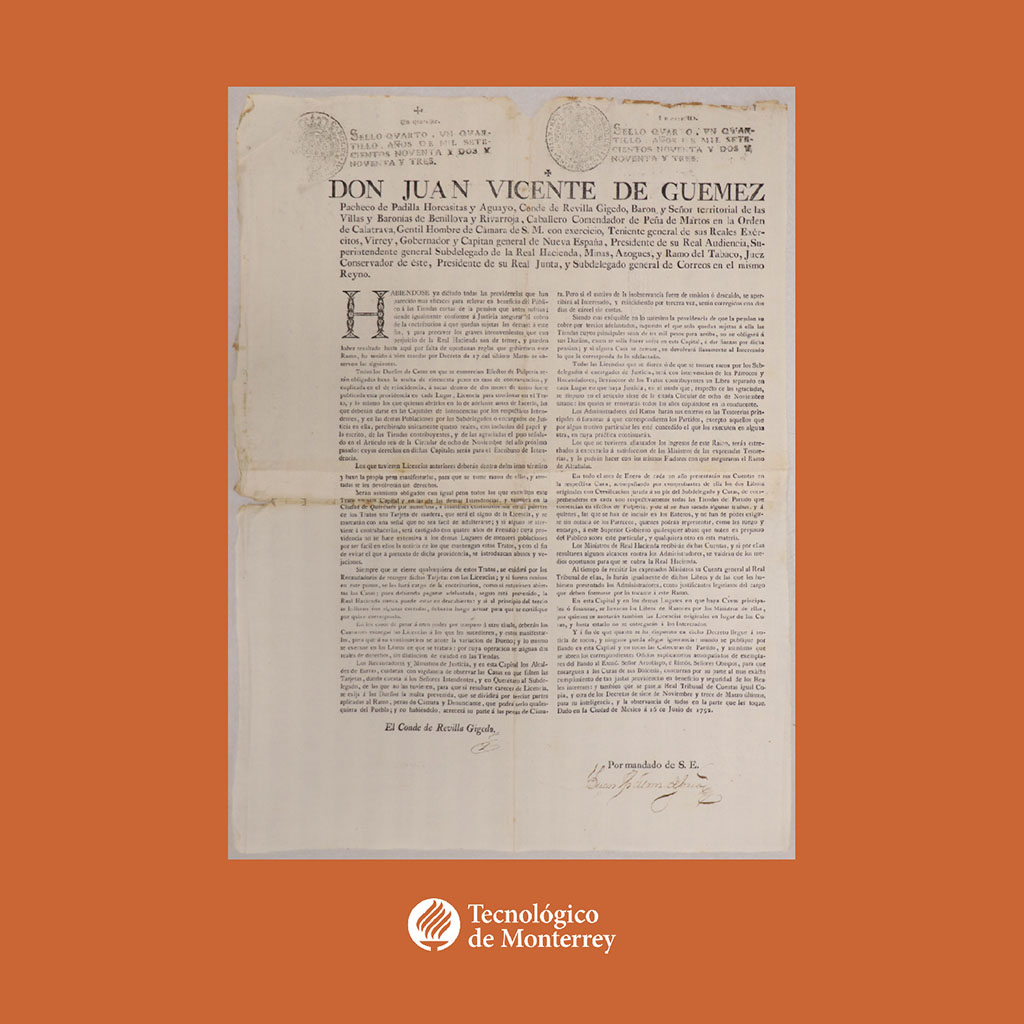
Don Juan Vicente de Güemes Pacheco de Padilla Horcasitas y Aguayo, count of Revillagigedo ..., viceroy, governor and captain-general of New Spain ... Having already dictated all the measures that have seemed most effective to relieve the short shops of the pension they previously suffered ... (printed decree), 1792. Historical Archive Fund of Real Caja de Zacatecas 1576-1936, Collection of the Society of Friends of Zacatecas, A.C. on loan to Tecnológico de Monterrey®. Memory of the World Registry of México, UNESCO, 2021. Cultural Heritage of Tecnológico de Monterrey®.
Juan Vicente de Güemes Pacheco de Padilla Horcasitas y Aguayo, count of Revillagigedo, was viceroy of New Spain from 1789 to 1794. During this period he dictated different ordinances, the purpose of the viceroy was to restructure New Spain. To do this, he ordered a detailed study on the income that occurred in the viceroyalty. One of the branches that were regularized were the pulperías or grocery stores, and with this decree of 1792, all the owners of these businesses had to have valid licenses, keep records of their sales and present them annually to the authorities. This site in Zacatecas gave rise to the generation of censuses on the number of stores in the city and in the localities of its jurisdiction.
This work is available for consultation in the Institutional Repository of Tecnológico de Monterrey through the following link: https://hdl.handle.net/11285/644474
November, 2020

Adolfo Mexiac, (1927-2019), Atrapando estrellas (Catching Stars), 1990. Resins and acrylics over wood and fabric. 100 x 100 cm. Campus Estado de México. D.R.® Adolfo Mexiac/SOMAAP/México/2023. Cultural Heritage of Tecnológico de Monterrey®.
Mexiac was an engraver and painter from Michoacan, whose work is associated with the Mexican School of Painting and the Popular Graphics Workshop, as he was a member of both groups. He dedicated his work to represent the time in Mexico in which he had lived, and whom he unquestionably loved. The composition of Catching Stars is given in two main planes: the background and the character that holds diagonally some networks. It is a typical scene of popular look with a palette of cold colors which predominates in two-thirds of the piece (grayish ocher) and the lower third in blue, representing water. The nets supported by the main character stand out, the action of which reminds us of a fisherman from Lake Pátzcuaro, who emulates the sky. The reflections of the lights of the day of the dead could be the stars, which we do not see properly in the painting, nevertheless, we imagine with the transparencies of the water at the feet of the fisherman.
December, 2020
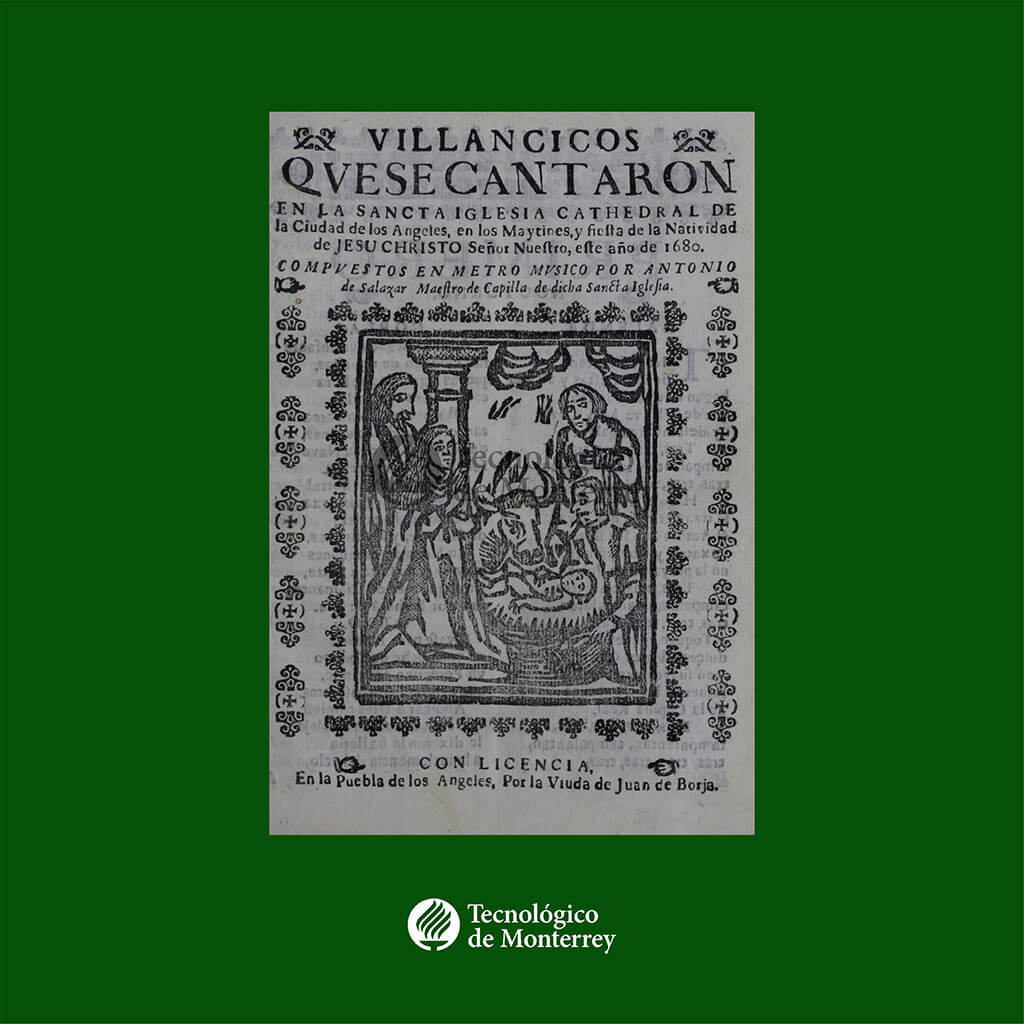
Antonio de Salazar (1680),Christmas carols that were sung in the holy cathedral church of the city of los angeles, in the maytines, and festivities of the Nativity of Jesu Christo Señor Nuestro, this year 1680. Widow of Juan Borja. Conde Zambrano Fund. "Miguel de Cervantes Saavedra" Special Collections Library. Cultural Heritage of Tecnológico de Monterrey®.
Christmas carols are compositions used in the ecclesiastical sphere which meaning comes to life through the conjugation of music, poetry, and representation. In New Spain, these works played an important role due to their contribution to the dissemination of Christian doctrine. The works shown here were composed by Antonio de Salazar (1650-1715), who was appointed Master of the Chapel of the Puebla Cathedral in 1679. Salazar dedicated himself to composing sacred music and set various written Christmas carols to music., including some written by Sor Juana Inés de la Cruz for different festivities. His works were recognized throughout New Spain and he is considered an innovator since he introduced songs in various literary-musical forms that were not common in America. The Tecnológico de Monterrey guards various Christmas carols, by Antonio de Salazar and other authors, including those that were sung in the Puebla Cathedral at Christmas 1680.
January 2021
Francisco de Alvarado, Vocabulary in the Misteca language, made by the Fathers of the Order of Preachers, who reside in it, and lately compiled, and finished by Father Fray Francisco de Aluarado, vicar of Tamaçulapa, of the same Order, 1593. Printer: Pedro Balli. Salvador Ugarte Fund. "Miguel de Cervantes Saavedra" Special Collections Library. Campus Monterrey. Cultural Heritage of Tecnológico de Monterrey®.
Brief glossary made from the work of Antonio de los Reyes and other Dominicans. It contains information on the cultural material, social organization and the religion of pre-colonial times, as well as demonstrating how translations were forged for the ideas and technologies introduced by the Spaniards. This work collects thousands of words and is presented alphabetically with 18 of the 28 letters of our alphabet. The sample shown comes from the Salvador Ugarte Fund and is part of the 16th century Mexican Printed Collection, which has the Memory of the World Register, Latin America and the Caribbean Region granted by UNESCO to the Tecnológico de Monterrey in conjunction with the National Library of Mexico.
This work is available for consultation in the Institutional Repository of Tecnológico de Monterrey through the following link: https://hdl.handle.net/11285/638981
February 2021
Thomas Harriot (with engravings by Theodor de Bry, 1590), Admiranda narratio fida tamen, de commodis et incolarvm ritibvs Virginiae. Salvador Ugarte Fund. Special Collections Library. Campus Monterrey. Cultural Heritage of Tecnológico de Monterrey®.
This work is an exemplary case that portrays how printed matter becomes relevant not only for the historical testimony offered by its texts but also for its artistic contribution as graphic work. The text shares as a report, the experiences that the English astronomer and mathematician Thomas Harriot lived off the coast of North Carolina during an expedition to the Americas organized by Sir Walter Raleigh. Harriot describes the social organization and customs of the native peoples as well as the natural and mineral resources found in those lands. The narrative was first published in English in 1588 with illustrations by the watercolorist John White; later in 1590, the celebrated engraver Theodor de Bry collaborated to edit a version translated into four languages that included engravings inspired by White's illustrations. The sample shown here is the Latin version with engravings by Theodor de Bry.
March 2021
Alonso de Molina, Senior, confessional, in Mexican and Spanish language, 1565. Salvador Ugarte Fund. "Miguel de Cervantes Saavedra" Special Collections Library. Campus Monterrey. Cultural Heritage of Tecnológico de Monterrey®.
The author of this work is the renowned lexicographer Fray Alonso de Molina, who came to New Spain from an early age, where he quickly learned the Nahuatl language; this facilitated their coexistence with the natives and made him a recognized Nahuatl teacher, despite not being a native speaker. This major confessional focuses on teaching doctrine to penitents. It was a manual for priests in New Spain in the original language with translation in Spanish and they used it to perform the sacrament of confession. This work dates back to 1565 and was printed by Antonio de Espinosa.
April 2021
Francisco López de Gómara (1554), Historia General de las Indias, 1554. Pedro Robredo Fund. "Miguel de Cervantes Saavedra" Special Collections Library. Campus Monterrey. Cultural Heritage of Tecnológico de Monterrey®.
In his book Historia General de las Indias, Francisco López de Gómara, who was never in America, narrated from a Eurocentric perspective, the discovery and conquest of the new continent. The publication of this book ld the author to have several discursive confrontiations with Bernal Díaz del Castillo and Fray Bartolomé de las Casas. In 1556, by Royal Decree, its printing was prohibited in Spain largely because it magnified the figure of Hernán Cortés or because of the criticism directed towards the Catholic Monarchs.
May 2021
Girolamo Benzoni, America pars qvarta..., 1594, (with engravings by Theodor de Bry). Salvador Ugarte Fund. "Miguel de Cervantes Saavedra" Special Collections Library. Campus Monterrey. Cultural Heritage of Tecnológico de Monterrey®.
Girolamo Benzoni was an explorer, merchant and traveler, who was in America for fifteen years (1541-1555). Upon his return to Milan he wroteAmericae pars quarta: sive insignis et admiranda historia de reperta primum Occidentali India a Christophoro Columbo. Benzoni narrates the process of evangelization and the attitude that the natives had towards the conquerors, as well as expressing his disagreement with the conquest of Spain over America, considering it an act of blood, death and destruction, but also shows horror at the anthropophagy of the natives. The first edition was published in 1565 and several translations were made of it in European languages, including editions in Latin, but not in Spanish. The first edition in Spanish was carried out until 1967 in Venezuela, then another published in Spain with an introduction and notes by Manuel Carrera Díaz would appear. The relevance of the work of Girolamo Benzoni was the introduction of the engravings made by Theodor de Bry.
June 2021
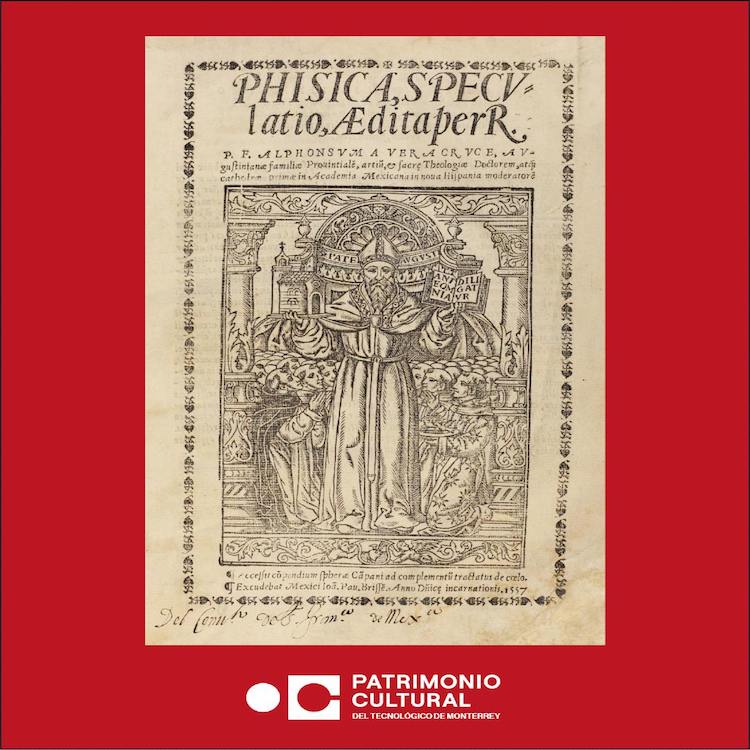
Alonso de la Vera Cruz, Phisica, specvlatio (1557). Salvador Ugarte Fund. "Miguel de Cervantes Saavedra" Special Collections Library. Campus Monterrey. Cultural Heritage of Tecnológico de Monterrey®.
Considered as the first physics book written in America, Phisica, specvlatio was published in 1557. Its author, Fray Alonso de la Vera Cruz, was one of the most recognized New Spain philosophers and was in charge of the first chair of philosophy created during the viceroyalty at the Royal and Pontifical University of Mexico. The purpose of this work was to introduce the main concepts of physics to the "New World'', covering the themes elaborated by Aristotle. This piece comes from the Salvador Ugarte Fund and is part of the 16th century Mexican Impressions collection, which has a Memory of the World Regional Register granted by UNESCO to the Tecnológico de Monterrey in conjunction with the National Library of Mexico.
The complete document can be consulted in the Institutional Repository through the following link: https://hdl.handle.net/11285/637161
July 2021

Diego García Palacio, Instrucion nauthica, para el buen uso, y regimiento de las Naos, su traça, y y gouierno conforme a la altura de Mexico (1587). Salvador Ugarte Fund. "Miguel de Cervantes Saavedra" Special Collections Library. Campus Monterrey. Cultural Heritage of Tecnológico de Monterrey®️.
Wrtten by Diego Garcia Palacio in 1587, this work was intended to apply the theories described in it. It is divided into four books or sections. The first covers the celestial and terrestrial spheres and studies navigation tools such as the nautical compass, the dial and the bastille, as well as the calculation of the hours of the day. In the second chapter the astronomical phenomena are narrated and the movement of the sun and the moon is studied, as well as the movements of the tides; It should be noted that the data was adapted according to the latitude of Mexico City. The third section focuses on the movements of the stars and how they affect humans. In the fourth and last section the construction of ships is discussed, considering the characteristics of the Pacific Ocean.
This work is available for consultation in the Institutional Repository of Tecnológico de Monterrey through the following link: https://hdl.handle.net/11285/637299
August 2021
Jean Gerson, Tripartito del Christianissimo y consolatorio doctor Juan Gerson de doctrina Christiana (1544). Salvador Ugarte Fund. "Miguel de Cervantes Saavedra" Special Collection Library. Campus Monterrey. Cultural Heritage of Tecnológico de Monterrey®️.
The Tripartito… aimed to facilitate the preaching of chistian doctrine during the evangelization process. It contained a series of practical advices which adressed not only priests but also the secular community and even children. This work was originally written in latin by the French theologist and chancellor Jean Gerson (1363-1429). The edition of this spanish translation was ordered by Friar Juan de Zumárraga to Juan Cromberger, and was printed in Mexico in 1544. It is considered the first printed work in America containing wood engravings.
This work is available for consultation in the Institutional Repository of Tecnológico de Monterrey through the following link: https://hdl.handle.net/11285/637123
September 2021
Guillermo Ceniceros, Conmemorativo 2000 (2000), Steel sculpture, 22 x 4 x 4 m. Campus Estado de México. Cultural Heritage of Tecnológico de Monterrey®️.
This monumental obelisk was made by Guillermo Ceniceros Reyes, author of important public pieces in Mexcio, Canada and the United States. In the work, the artist chose to use the representation of faces seen in profile as an allusion to the students and teachers. It becomes emblematic as it has witnessed the passage from one century to another. This work was carried out at Campus Estado de Mexico as part of the construction project of the building that houses the theater, the Art and Culture workshops and the pool locater next to it. Recently an important restoration work was used based on the proposal of its creator, who emphasized color and contrast of the forms, the background and the context where the work is located.
October 2021
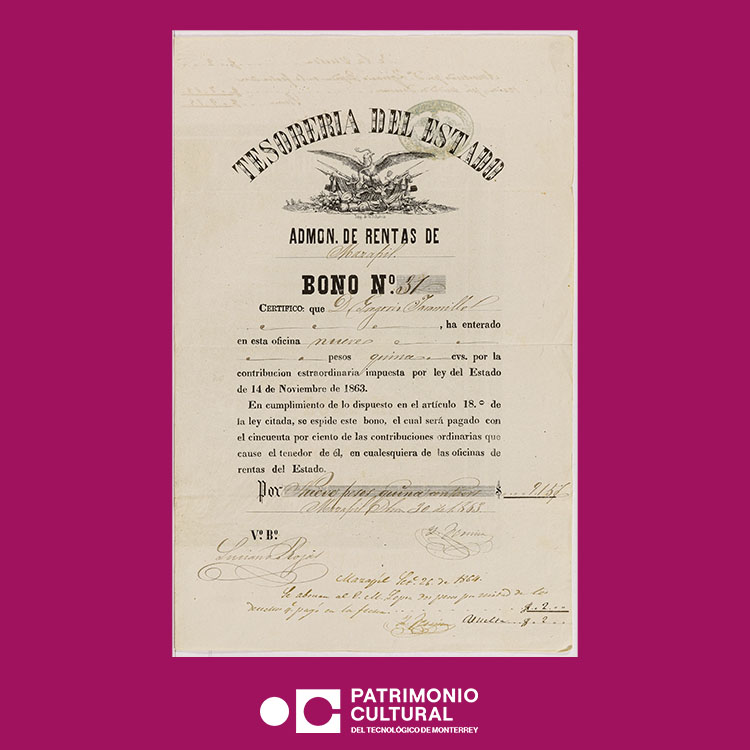
Bono No. 31, Treasury of the State of Zacatecas, 1864. Historical Archive Fund of Real Caja de Zacatecas 1576-1936. Collection of the Society of Friends of Zacatecas, A.C. on loan to Tecnológico de Monterrey®️. Memory of the World Registry of México, UNESCO, 2021. Cultural Heritage of Tecnológico de Monterrey®️.
The extraordinary contributions were a resource that the Mexican governments used to cover the needs of the treasury, in this case, the war expenses that were generated before and during the Second Empire headed by Maximilian of Habsburg. This implied, among citizens, an extra share of the taxes that were charged for real estate, businesses or money orders, transactions and others in which the Public Treasury of the country was immersed.
This document is available for consultation in the Institutional Repository of Tecnológico de Monterrey through the following link: https://repositorio.tec.mx/handle/11285/637852
November 2021
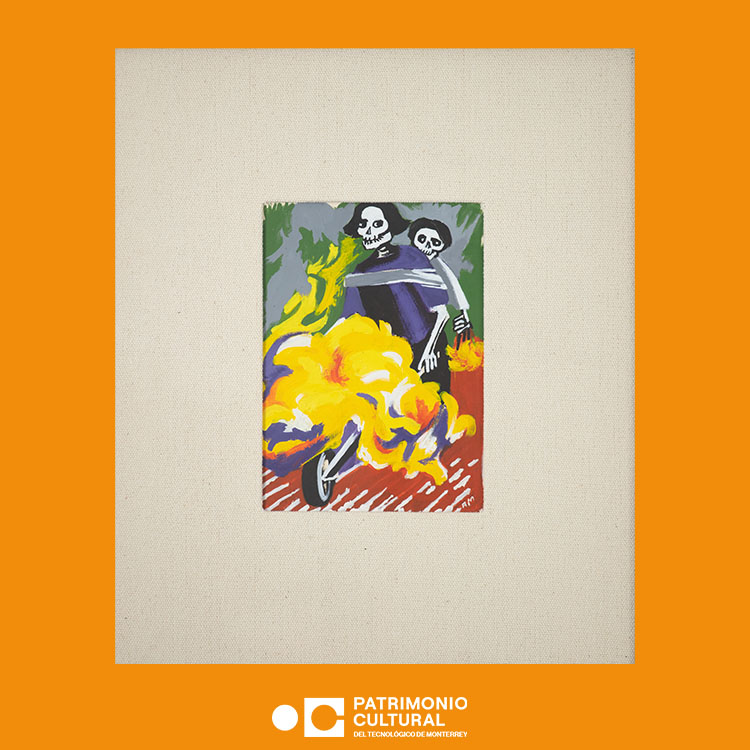
Adolfo Mexiac, Acarreando cempasúchil, (1993), Serigraphy, No. 280/500, 39.2 x 33.8 cm. Campus Estado de México. D.R.© Adolfo Mexiac /SOMAAP/México/2023. Cultural Heritage of Tecnológico de Monterrey®.
This piece is the silkscreen reproduction of an acrylic painting of the same name. A skull is portrayed as a mother and her son, whom she carries on her back with a shawl, while carrying a cart with marigold flowers, an important flower on the altars of the Day of the Dead. Mexiac was an artist who was part of the Taller de la Gráfica Popular, where he profusely developed the different engraving techniques, especially with the intention of making his artistic imagination available to the people. Carrying cempasúchil, is part of a portfolio of engravings published by the Tecnológico de Monterrey, Campus Estado de México in 1993, to celebrate this important Mexican holiday.
December 2021
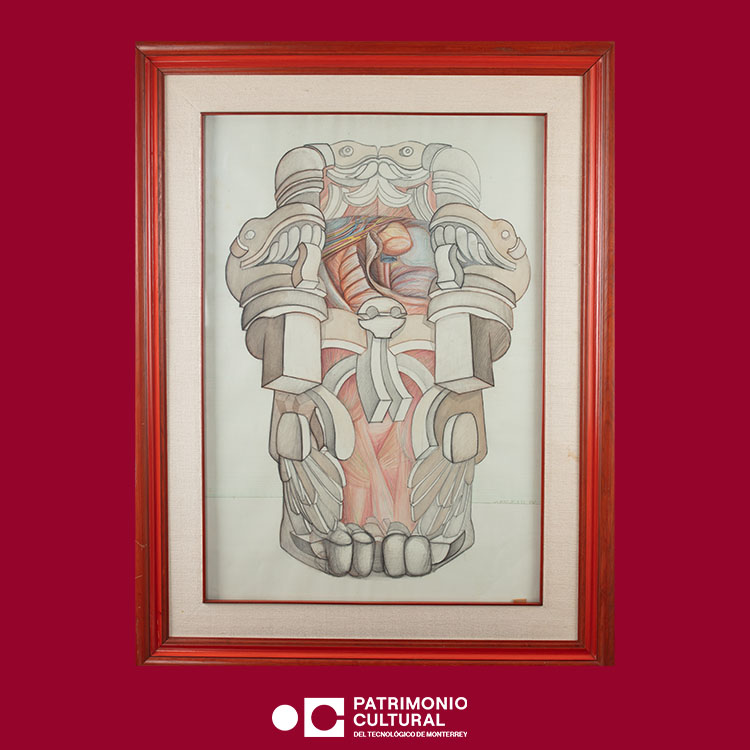
Arnold Belkin, Coatlicue, (1980), Mixed media, watercolor and colored pencils on cotton paper, 8.3 x 129 x 3.2 cm. Campus Estado de México. D.R.© Arnold Belkin/SOMAAP/México/2023. Cultural Heritage of Tecnológico de Monterrey®.
Canadian artist, who inspired by Mexican art, decided to move to Mexico in 1948. He studied at the "La Esmeralda" School of Painting and Sculpture in the context of the Cuban Revolution, due to his inclination towards social art, in the early sixties, he became part of the artistic movement of rupture, Nueva Presencia. Coaticue, which in Nahuatl means "the one with her skirt of snakes", is a drawing made in mixed media technique that represents the goddess of fertility, life and death. This skirt is usually configured with a row of snakes, associated with the meaning of its name, however, in this work a network of internal muscles covered by wings that descend towards the feet is appreciated. In the center of the image there is a belt with a human skull that connects with both sides of the character, towards two stone serpents. In pre-Hispanic representations, two naked breasts are commonly added to symbolize fertility, in this case the artist presents an open throat, exposing the heart and its arteries, a symbol of life and reflection on the human condition.
January 2022
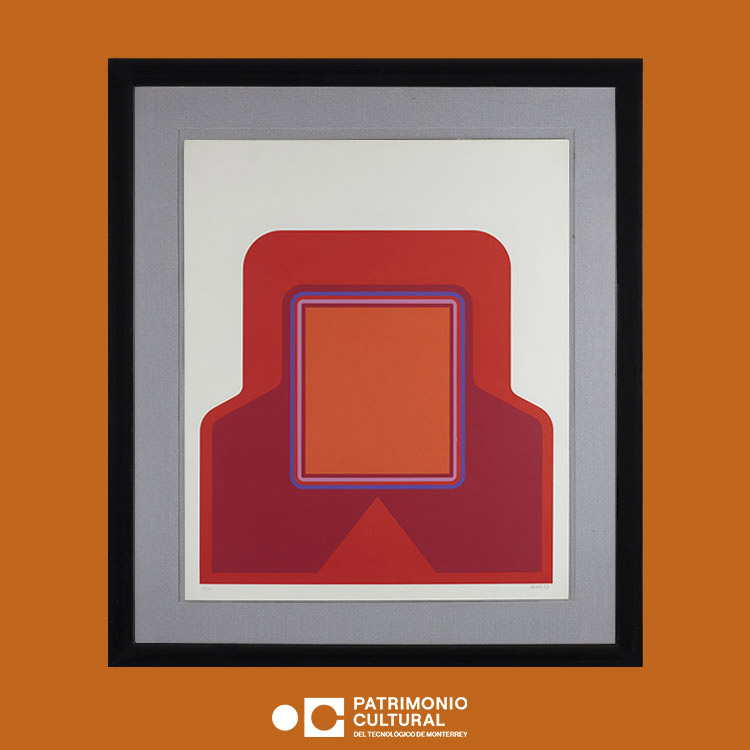
Vicente Rojo (1932-2021), Untitled, 1973, Serigraphy, 57 x 50 cm. Campus Estado de México. D.R.® Vicente Rojo/SOMAAP/México/2023. Cultural Heritage Collection of Tecnológico de Monterrey®.
Vicente Rojo Almazán, was an artist born in Barcelona who emigrated to Mexico in 1949 where he studied painting, and for more than fifty years he developed as a graphic designer, painter and sculptor. He is considered one of the founders of graphic design in Mexico who collaborated and founded editorials, cultural supplements and various publications. Rojo is associated with the group of artists known as the rupture, however his most relevant contribution was in the development of graphic design in the Mexican publishing industry. This piece is an abstract four-ink silkscreen which belongs to one of the main series identified as Signs. In it, he explores the basic geometric shapes with a warm color range, clearly symmetrical and balanced with the central shape outlined by a blue stripe.
February 2022
Guillermo Meza, Óxido de plata (1989), Oil on canvas, 88.8 x 87.7 x 6 cm. Campus Estado de México. Cultural Heritage of Tecnológico de Monterrey®.
Guillermo Meza made Óxido de plata (Silver Oxide) in 1989, an exemplary work of his, it has that peculiar atmosphere of something dreamed and half-explained. Meza paints mysteries and the human figure, but negated. There the characters are faceless, their identity is obliterated and that apparent blindness suggests to us a possibility to see beyond. Tinted with a certain surrealism, art critics in Mexico have called him "painter of the impossible". Silver oxide is the pictorial technique that decorates or adds a metallic effect, here necessary for the armor of our character. Guillermo Meza is remembered as a very shy man, reluctant to show off his talent, sullen when exhibiting his work. He was first discovered as a young talent by Diego Rivera in the early forties, the renowned muralist sent him to the gallery owner Inés Amor and while exhibiting in her store Igor Stravinsky, a Russian musician of international fame, asked him to illustrate one of his ballets. There he also met Santos Balmori, an important Mexican architect who hired him to work on his urban projects.
Dr. Carlos Molina Posadas, 2016.
March 2022
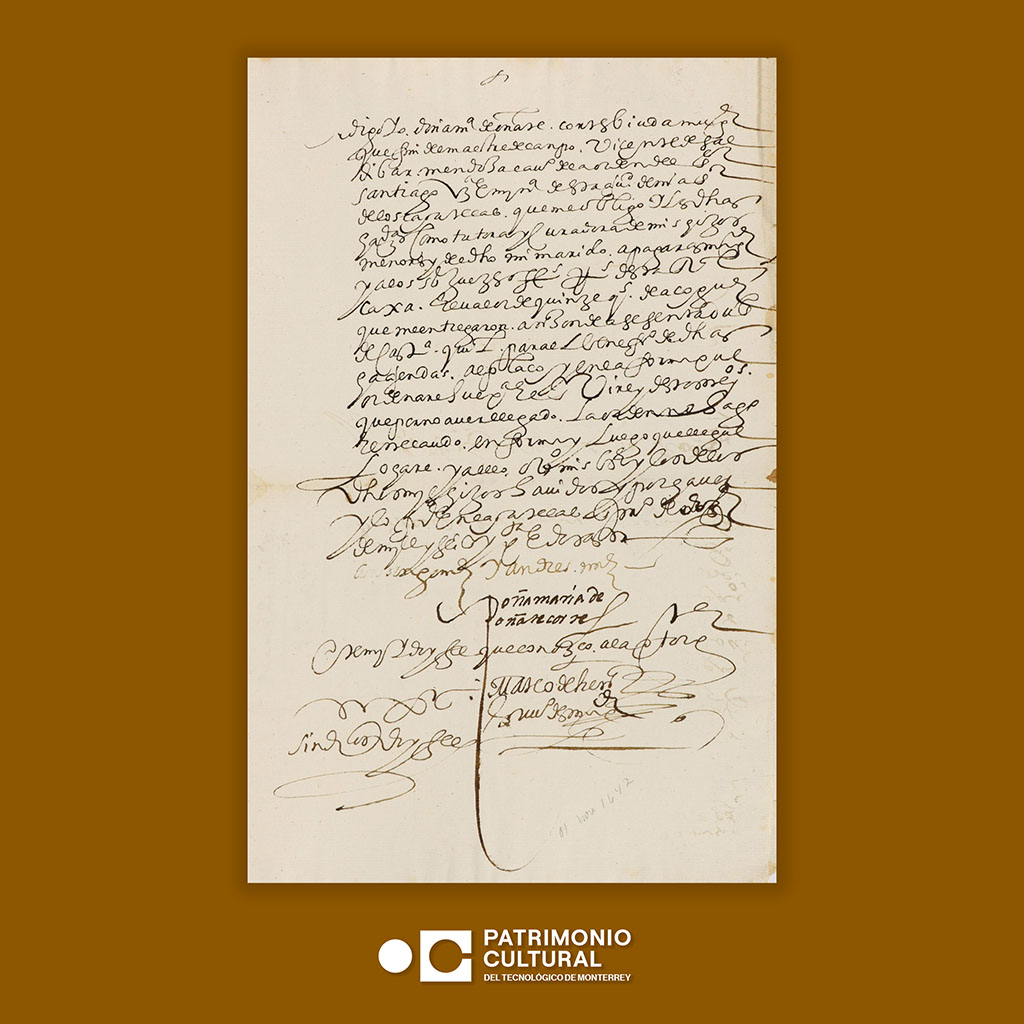
I say doña María de Oñate Cortés, widow, women who was the field master Vicente de Zaldivar, Knight of the order of San Santiago, neighbor and miner of this city of Our Lady of Zacatecas, 1642. Historical Archive Fund of Real Caja de Zacatecas, 1576-1936. Collection of the Society of Friends of Zacatecas A.C. on loan to Tecnológico de Monterrey®. Memory of the World Registry of Mexico, UNESCO, 2021. Cultural Heritage of the Tecnológico de Monterrey©
Maria de Oñate Cortés belonged to one of the most important families in the city of Zacatecas, she was the daughter of Juan de Oñate El adelantado, conqueror and governor of New Mexico, and Isabel Cortés Moctezuma. On both sides she descended directly from the founders of the city, on her father's side she was the granddaughter of Cristóbal of Oñate and on her mother's side of Juanes de Tolosa. When Vicente de Zaldívar Mendoza, her husband, died, María de Oñate became the curator and guardian of the possessions that her children would inherit, she as known in the city and in the Real Caja, as a miner. The importance of this document lies in the signature of this 17th-century mining and Zacatecan woman.
This work is available for consultation in the Institutional Repository of Tecnológico de Monterrey through the following link: https://hdl.handle.net/11285/639903
April 2022
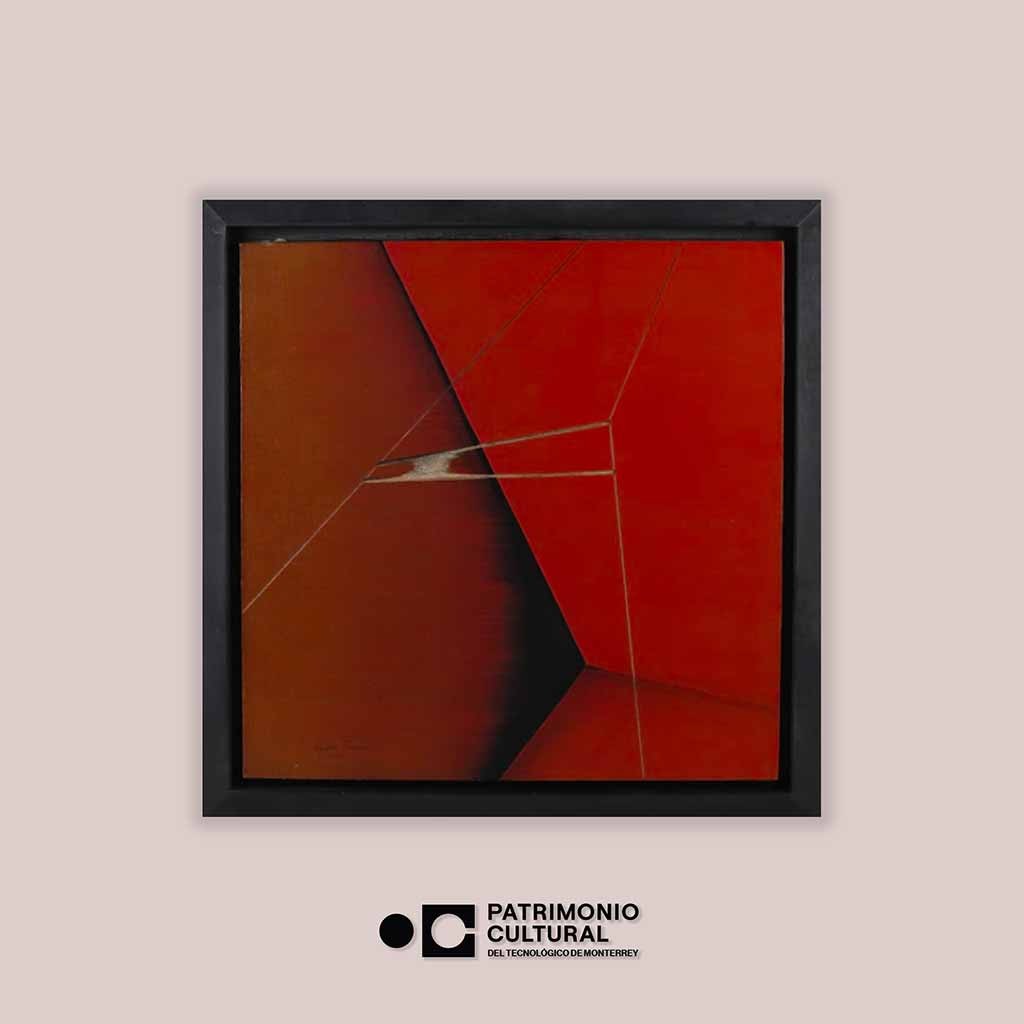
Águeda Lozano (1944). No. 48-85, 1985. Acrylic paint on canvas, 116.8 x 116.8 cm. Campus Estado de México. D.R.® Águeda Lozano/ARS/SOMAAP/México/2023. Cultural Heritage of Tecnológico de Monterrey®.
Originally from Chihuahua, she studied in Monterrey at the Plastic Arts Workshop of the Autonomoua University of Nuevo León between 1960 and 1964. Lozano moved to París in 1971 and began her interest in abstraction in the Art-Explora-Cité Internacionale des Arts. In 2016, she installed a sculpture in Plaza México in the 16th District of París, thus becoming the first Mexican artist to exhibit on that site. Águeda Lozano's main concern is the representation of geometric spaces integrating organic elements such as curves, stains and textures. In this work made up of three red parallelepipeds, Águeda constructs, together with diagonals in sepia tones an organic shape that seems to tense the main lines that cross the image, a harmonic game that, associated with the title of the work, reminds us of musical compositions or perhaps in a veiled way a range of the whose limit seems to be, the year of creation of this work or art.
May 2022
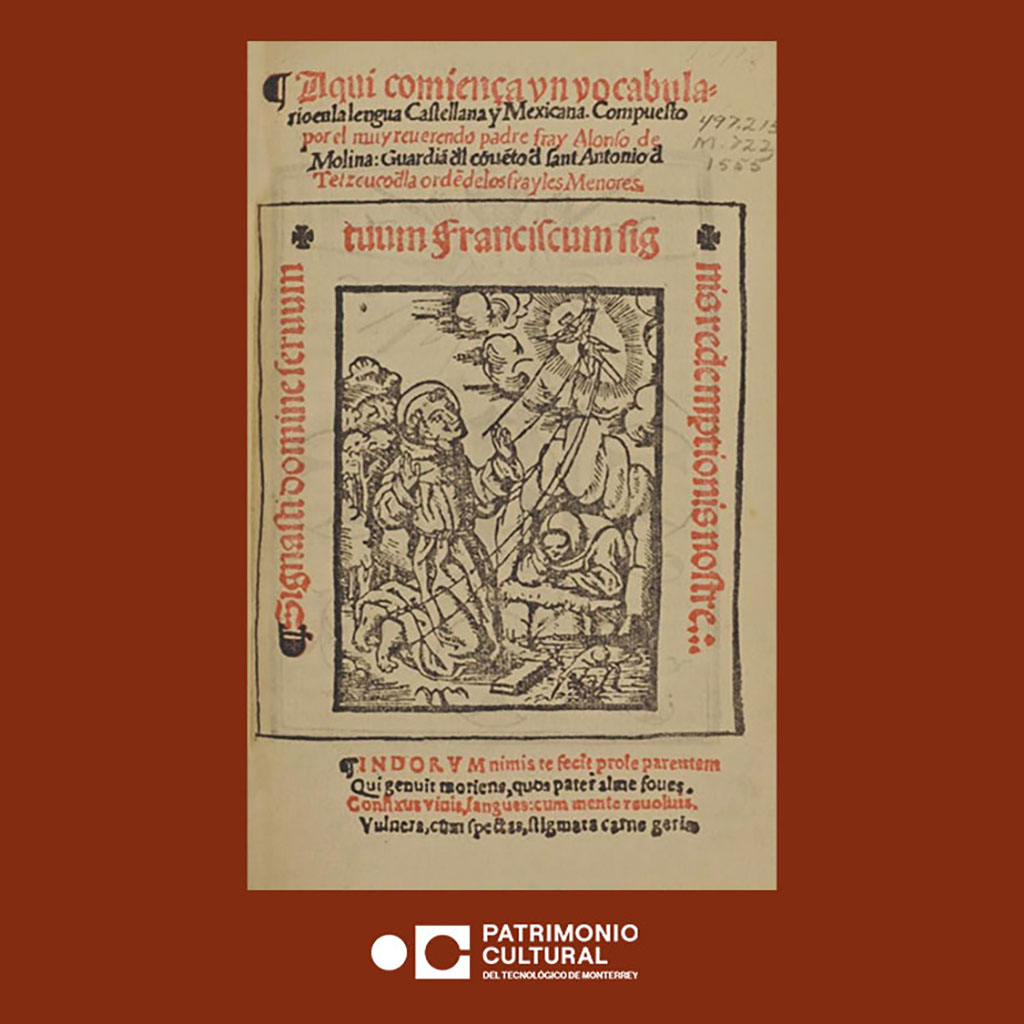
Alonso de Molina (1514-1585), Here begins a vocabulary in the Spanish and Mexican languages, 1555. GRG Conway Fund. "Miguel de Cervantes Saavedra" Special Collections Library. Campus Monterrey. Cultural Heritage of Tecnológico de Monterrey®.
Fray Alonso de Molina was born in Spain around 1514, arrived in Mexico as a child, and died there in 1585. He was the first ordained Catholic priest in New Spain and the first non-indigenous Nahuatl teacher. As a Franciscan linguist, he worked as an interpreter, in the elaboration of grammars, vocabularies, doctrines and in translations of works into the Mexican language. This book is the first vocabulary of indigenous languages printed in America, in the house of Juan Pablos and with licenses from the Viceroy Luis de Velasco and Archbishop Alonso de Montúfar, who were the second to occupy these positions, respectively. The work was revised by Fray Bernardino de Sahagún. This text includes metaphors, diversity of words from the different provinces and details of concepts that the indigenous people had and were unknown to the Spanish or vice versa. In addition, the text is completed with notices to facilitate its consultation, it explains about numbers and how to count. The printing of this work finished on May 4, 1555.
This work is available for consultation in the Institutional Repository of Tecnológico de Monterrey through the following link: https://hdl.handle.net/11285/639187
June 2022
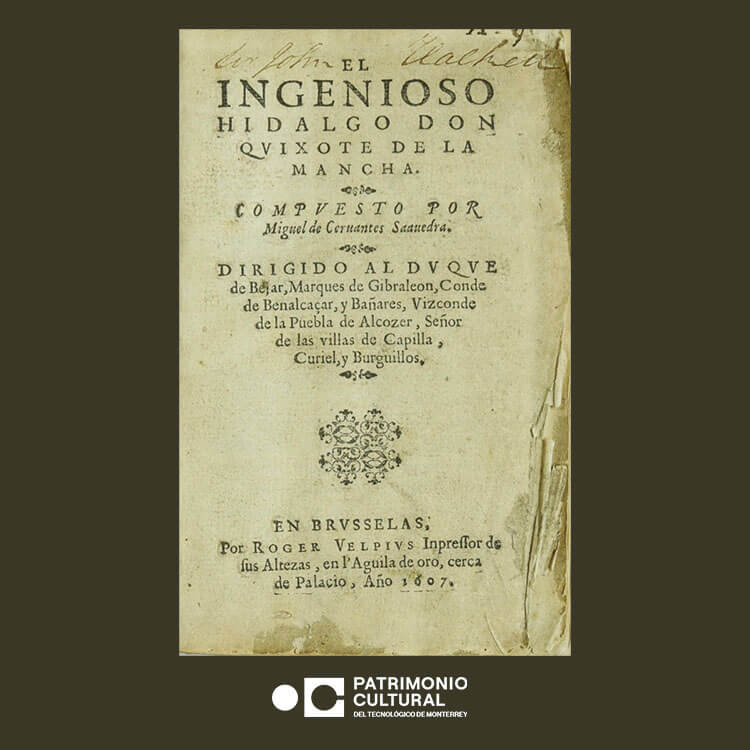
Miguel de Cervantes Saavedra (1547-1616) The Ingenious Hidalgo Don Qvixote de la Manche, 1607, Roger Velpivs edition. Carlos Prieto Fund. “Cervantina Collection”, Special Collections Library “Miguel de Cervantes Saavedra”. Cultural Heritage of Tecnológico de Monterrey®️.
This work by Miguel de Cervantes Saavedra was published in Brussels in 1607 and has been taken as a partial or total basis in subsequent translations and editions. This copy is the oldest Quijote preserved in the Cervantes Library of the Tecnológico de Monterrey, which was donated to the university in 1954 by Carlos Prieto. The arrival of the Cervantes Collection at our institution led to the founding of the “Miguel de Cervantes Saavedra” Special Collections Library.
This edition is the eight size, it retains its original parchment binding and contains dedication, privilege, claims and signatures, as well as Pitfirrane’s ExLibris. Roger Velpius prepared this edition with great care as it was based on the second printing by Juan de la Cuesta and corrected several of its misprints and inaccuracies. It consists of 52 chapters divided into four parts and includes, like all editions prior to 1615, only the first part of the novel. The importance of Don Quixote as the first modern novel in Spanish goes beyond a parody of chivalric novels, since it inaugurates the use of various narrative techniques such as recapitulation, the use of digressions and meta discourse, in addition to the introduction of other literary genres in the text and the construction of its characters, making it an endearing story for all humanity
This work is available for consultation in the Institutional Repository of the Tecnológico de Monterrey through the following link: https://repositorio.tec.mx/handle/11285/648309
July 2022
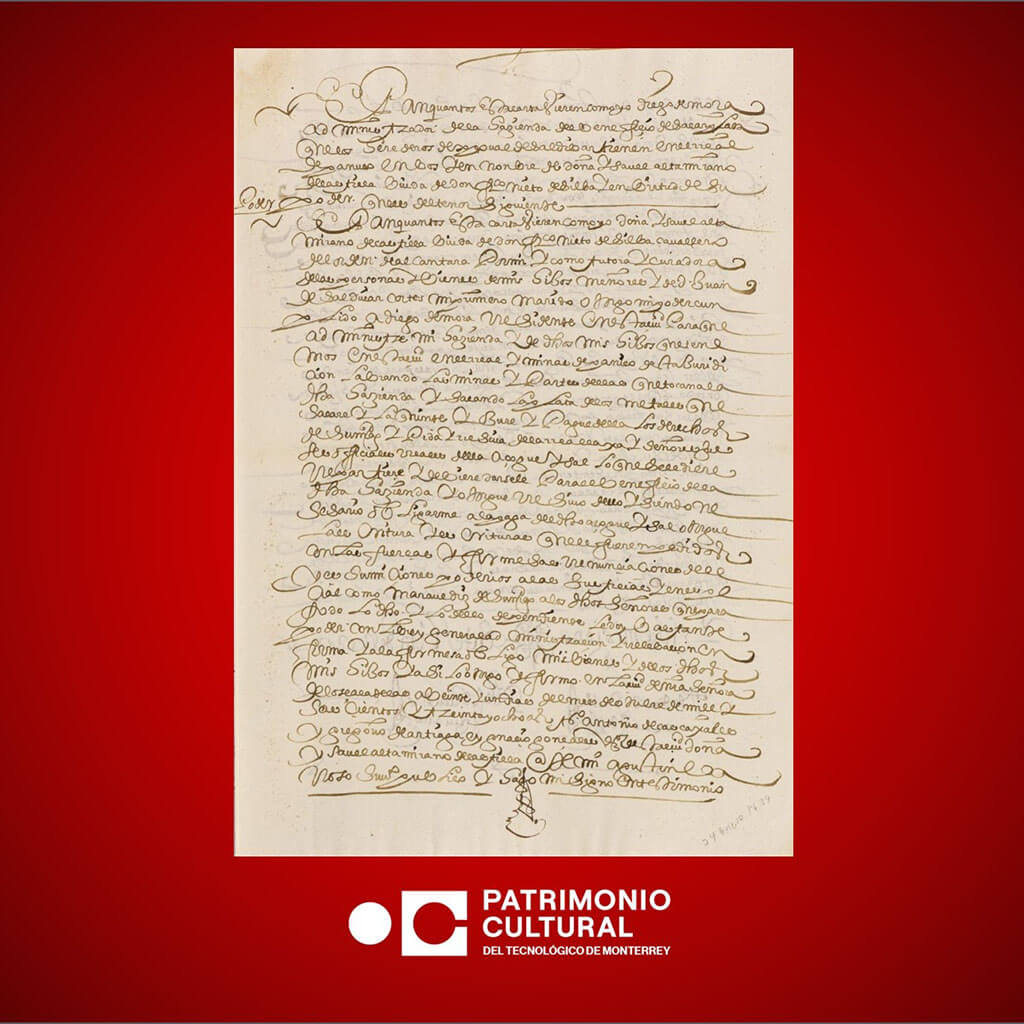
Royal Treasury against Doña Isabel de Castilla Altamirano for 827 pesos 1 tomín 7 grains worth 10 quintals of quicksilver, 1639. Historical Archive Fund of Real Caja de Zacatecas, 1576-1936. Collection of the Society of Friends of Zacatecas, A.C. on loan to Tecnológico de Monterrey®️. Memory of the World Registry of Mexico, UNESCO, 2021. Cultural Heritage of Tecnológico de Monterrey©.
The distribution of quicksilver or mercury to clean the silver that was extracted from the mines, was in charge of the royal officers of the Royal Treasury and Caja of the city of Zacatecas. They, in their capacity as officials, received the quicksilver that arrived from Spain or Peru and distributed it to the miners. Some owners of mines had administrators who took charge of them, for this, they gave them a power of attorney so that in their name they could request and pay the quicksilver that was required in their haciendas for the benefit of extracting silver. As in this case, the one granted by Doña Isabel de Castilla Altamirano, widow of Juan de Zaldívar Cortés, was granted to Diego de Mora. The debt that was acquired by the quicksilver did not fall on the administrator, but on the owner of the mine, for that reason the obligation to pay for the quicksilver belonged to Doña Isabel de Castilla Altamirano.
This work is available for consultation in the Institutional Repository of Tecnológico de Monterrey through the following link: https://hdl.handle.net/11285/639822
Likewise, we invite you to consult this and other documents in the exhibition "De la A a la Z. La Real Caja de Zacatecas" at: https://tinyurl.com/exposiciones-virtuales
August 2022

Carlos Mérida Americanism and Abstraction, 1978. Serigraphy. Campus Estado de México. D.R.© Carlos Merida/SOMAAP/Mexico/2023. Cultural Heritage of Tecnológico de Monterrey©.
Carlos Mérida was a Guatemalan artist who came to the post-revolutionary Mexican art scene where he explored the possibilities of geometric abstraction; his works interpret Latin American identity. He criticized the dominant ideals of nationalism and proposed extolling indigenous models through a geometric purism, focused on the aesthetic values of line, shape and color. In this work, the contrast between ocher and blue in the background, highlights the simplification of forms. Mérida places us in a timeless space without spatial references, meanwhile, the figures are reminiscence of pre-Hispanic sculptures. Americanism and Abstraction, is featured by the geometrizing character of the shapes and strokes that compose it. Within the work, two silhouettes represent the modern man and his indigenous counterpart, projecting a connection between both realities of contemporary Mexico at that time.
September 2022
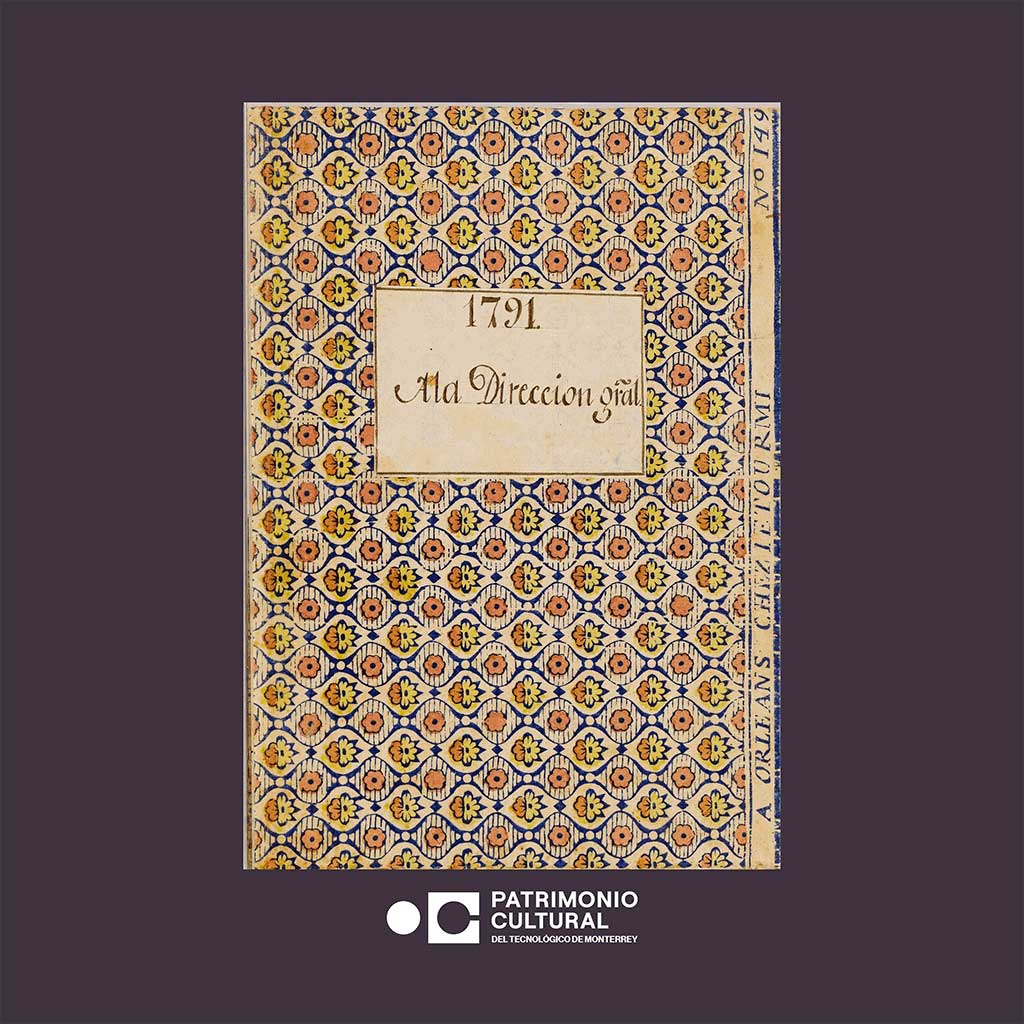
1791. A la Dirección General. Historical Archive Fund of Real Caja de Zacatecas, 1576-1936, Collection of the Society of Friends of Zacatecas, A.C. on loan to Tecnológico de Monterrey®️. Memory of the World Registry of México, UNESCO, 2021. Cultural Heritage of Tecnológico de Monterrey©.
Document 1791. A la Dirección General is a beautiful example of binding on xylograghic paper, in which the undulating pattern dominates the front and back covers; Within one of these curvatures there are floral details in shades of yellow, blue and pale pink, separated at their narrowest part by small diamonds in a blue tone. In the other, flowers with six pale pink petals, surrounded by parallel lines and at the end of each undulation, a white circle. These types of notebooks were not common in the Real Caja de Zacatecas, since the royal officials generally used simpler ones, that is, a couple of sheets of simple paper, without stamps, sewn, to which they were called files. However, in this copy the income and expenses of the alcabalas branch were recorded, a tax that was applied to products and merchandise that entered or passed through the city.
This work is available for consultation in the Institutional Repository of Tecnológico de Monterrey through the following link: https://hdl.handle.net/11285/638189
Likewise, we invite you to consult this and other documents in the exhibition "De la A a la Z. La Real Caja de Zacatecas" at: https://tinyurl.com/exposiciones-virtuales
October 2022

Gilberto Aceves Navarro, Self-portraits, 1998. Acrilic on drywall Campus Estado de México. D. R.© Gilberto Aceves Navarro/SOMAAP/México/2023. Cultural Heritage of Tecnológico de Monterrey©.
Gilberto Aceves Navarro is one of the most important representatives of Mexican painting, commonly associated with the artists of the so-called "rupture". This series of self-portraits is a set of 98 panels he donated to the Tecnológico de Monterrey Estado de México Campus in 1998. The characteristic of this polyptych is the repetition of a self-portrait painted on two panels, which are later separated and mixed indistinctly, forming multiple works of art expressing its dynamism through the undulating and gestural line of the artist.
November 2022
Juan Carlos Breceda. De la serie: La muerte regresa, s/f, xilography. Campus Estado de México. Cultural Heritage of Tecnológico de Monterrey©.
This xilography is part De la serie: La muerte regresa from thirteen pieces printed in black ink. Three skulls can be seen: one wears a wide-brimmed hat and appears playing the double bass, while the second accompanies it with a guitar; the third skull with black hair observes them, highlighting the pattern of its floral dress. The figures are elongated, and the bowls of the skull retain the eyes, an element that the artist used to give greater strength to the expression of the characters. This piece is by Juan Carlos Breceda, a sinaloense painter who recovers the Mexican visual imagination, following the artists' interest in portraying syncretism in our traditions.
December 2022

Mestrovic, Ivan. Seasons Greetings Postcard for Mr. Basave, n/d, 13.8 x 8.6 cm. Agustín Basave Fund. Photolibrary of Tecnologico de Monterrey "Miguel de Cervantes Saavedra" Special Collections Library. Cultural Heritage of Tecnológico de Monterrey©.
The Agustín Basave's Fund gathers very important testimonies that identify the most outstanding 20th Century people, in a wide scope. Collected by Architect Agustín Basave del Castillo Negrete, who was "El Norte" Newspaper Director and Adviser to Tecnologico de Monterrey, the testimonies include business cards, autographed photographs, letters, biographies and newspaper articles. This Monthly showcase is a postcard, possibly from 1949, sent by Yugoslav sculptor Ivan Mestrovic to Agustín Basave, in which he wrote "Warmest good wishes for a Merry Christmas and all of the best in the New Year!" The image on the postcard is a low relief with religious motif, one of this artist's specialties. In the institutional repository you may find Iván Meštrović’s personal photo, his biography, a newspaper article about his work as a great sculptor, a letter from his brother Petar to Mr. Basave, a picture of one of his sculptures, this postcard, signed by him next to the message.
This work is available for consultation in the Institutional Repository of Tecnológico de Monterrey through the following link: http://hdl.handle.net/11285/623702
January 2023
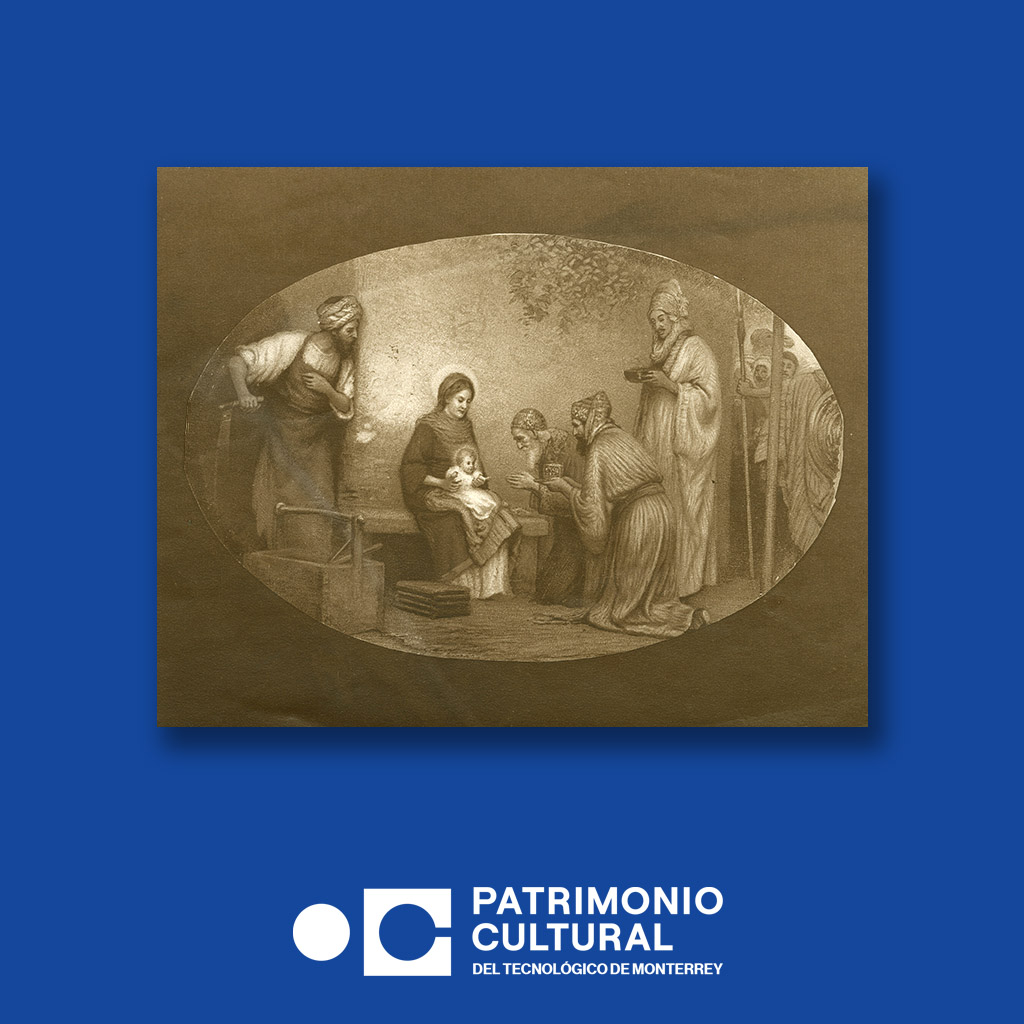
Unidentified. Gifts for Baby Jesus, Monterrey, N.L., 1940. Printed in duotone, 14.8 x 11.7 cm. Code 2697. Alberto Flores Varela Fund. Photolibrary of Tecnologico de Monterrey "Miguel de Cervantes Saavedra" Special Collections Library. Cultural Heritage of Tecnologico de Monterrey©.
The image is a photography of a religious print which represents the Epiphany or The Adoration of the Magi. In the image, Jesus is in his mother's lap and two of the three kings kneeling. Melchior is the one closer to Baby Jesus, generally represented with a white beard, delivering gold. Gaspar is in second place, offering frankincense, according to tradition. Balthasar or Balthazar appears standing, holding a box with myrrh. At the left, leaning towards a wall, is Saint Joseph with the carpenter's tools. It is a card printed in sepia duotone and it might be a reproduction as a holiday gift for the photo studio clients.
This card belongs to Alberto Flores Varela Fund, who was a professional photographer born in 1906. He began as an apprentice in 1919 and later directed the photo studio called Foto Selecta. This Fund guards photographs shot between 1929 and 1996 and it reviews the liturgical life, churches and some characters of the Catholic cult from Monterrey. The photographic archive was donated to the institution by the author himself.
This work is available for consultation in the Institutional Repository of Tecnológico de Monterrey through the following link: http://hdl.handle.net/11285/586816
February 2023
2nd Zacatecas Lancers Corps, 1863. Historical Archive Fund of Real Caja de Zacatecas 1576-1936. Collection of the Society of Friends of Zacatecas, A.C. on loan to Tecnológico de Monterrey©. Memory of the World Registry of Mexico, UNESCO, 2021. Cultural Heritage of Tecnologico de Monterrey©.
The 19th century was marked by continuous armed confrontations in the national territory in Mexico, between liberals and conservatives, but also by the invasions and interventions of foreign countries such as the United States and France. Because of this, the states of the Mexican Republic kept the national guard and permanent regiments in their main cities, and later these state divisions would be grouped into the so-called Army of the East, created by Benito Juárez in 1861.
The 2nd Corps of Lancers of Zacatecas was an elite cavalry unit, as its name mentions, they were soldiers who were devoid of firearms, but that did not mean they were no longer accurate when fighting the enemy. These squads were in force in the Mexican army until the period in which Porfirio Díaz ruled.
The relevance of this document lies in the beauty of the print with the eagle on the cactus devouring the sanke, which is flanked by laurel and oak leaves. In the same way, the leaves are joined with beautiful red, white and green ribbons, the same that represent tha flag of Mexico.
This document is available for consultation in the Institutional Repository of Tecnológico de Monterrey through the following link: https://hdl.handle.net/11285/645354
March 2023
Juana Inés de la Cruz, Sor. Carta Athenagórica de la madre Juan Ynes de la Cruz religiosa profesa de Velo, y Choro en el muy Religioso Convento de San Geronimo de la ciudad de México cabeza de la Nueva España. Qve imprime y, dedica a la misma Sor, Philotea de la Cruz su estudiosa aficionada en el Convento de la Santissima Trinidad de la Puebla de los Angeles. Printing House of Diego Fernández de León, 1690. Salvador Ugarte Fund. "Miguel de Cervantes Saavedra" Special Collections Library. Cultural Heritage of Tecnológico de Monterrey©.
The In her Text Crisis de un sermón, Sor Juana Inés de la Cruz explored Maundy Thursday's Sermon from 1650 by Father Antonio Vieira, in wich he argued that God's greatest gift was His love to us, against Saint Augustine, Saint Thomas and Saint John Chrysostom, all of them recognized as Doctors of the Church. In her rebuttal, Sor Juana argued that all Doctors were right and Vieira was wrong. This letter was published on November 25th, 1690 but the title was changed to The Letter Worthy of Athena, as it is Known now. The publication was allowed by Puebla's bishop, Manuel Fernández de Santa Cruz and included the Letter from Sister Philotea, as a preface. Sister Filotea is a pseudonym and her letter stated that Sor Juana should not be writing about theological issues, being a woman and a nun. This publication created a lot of problems for Sor Juana, because it seemed that her text was an affront directed to Archbishop of Mexico, Francisco Aguiar y Seijas, whose favorite thinker was nonetheless Antonio de Vieira. Several months later, on March 1st, 1691, Respuesta de la poetisa a la muy ilustre Sor Filotea de la Cruz, a response letter was published. As a personal testimony, Sor Juana defends women's right to studdy and learn.
This small work consists of 35 pages, it is 19 cm long and holds a beautiful cover with golden details, as well as Salvador Ugarte's ExLibris, stating the documentary fund to which it belongs. There can be noticed the paper punches and corondels. It has license, pressmarks and colophon, as well as printed marginal notes.
April 2023
Prieto. Compañía Eléctrica de Tampico, Tampico, Tamaulipas, 1920. Printed in duotone, 9.5 x 7.5 inches. Sandoval-Lagrange Fund. Photolibrary of Tecnológico de Monterrey. "Miguel de Cervantes Saavedra" Special Collections Library. Cultural Heritage of Tecnológico de Monterrey©.
The One of the main constructions that are located in the city of Tampico, Tamaulipas, is the building of the old light company, a beautiful engineering masterpiece, in which cast iron frames were imported from England and terracotta-colored concrete blocks from India. The building was erected between 1918 and 1924, a period of Mexican splendor that converged with the commercial and oil boom of the nation. The property belonged to the English electricity company called Electric Light, Power and Tramways of Tampico, in charge of supplying electricity and driving force for the old collective transport known as trams. Between 1960 and 1970 the building was occupied by various customs agency offices, later it would become the headquarters of the offices of Instituto Mexicano del Seguro Social (IMSS) and from 1993 to the present it is occupied by the Secretaría de Hacienda y Crédito Público (SHCP). This printed in duotone from 1920 is a photographic testimony of the city of Tampico, wich will celebrate its 200th anniversary on April 12, 2023.
This work is available for consultation in the Institutional Repository of Tecnológico de Monterrey through the following link: http://hdl.handle.net/11285/587143
May 2023
Jesús Mayagoitia. Encuentro de aniversario XX. 1996. Painted steel, 12 x 4 x 2 m, 12 tons. Photographer: Luis Enrique Sandoval. Campus Estado de México. Cultural Heritage of Tecnológico de Monterrey©.
The artwork commemorates the two decades of existence of the Campus Estado de México. The shapes and lines intersect to form from a perspective the two "xes" that represent the number twenty. The "Red Thing" is the colloquial name, the reference of daily transit, with which the students baptized for many years this monumental sculpture by Jesús Mayagoitia. Its title is that of the occasion that gave rise to it two decades ago now, Encuentro de aniversario XX. This is the transit and communication node for those who are part of the campus community. Jesús Mayagoitia is recognized worldwide and his interest has always been quality in sculptural production and aesthetic education for all. This is a Mexican sculptor interested in the different configurations thet geometric bodies take projected onto a plane, how we perceive them in space and, of course, the way in which we relate to each other from there. Winner of the Henry Moore Award in 1987, Mayagoitia is not only a world-renowned creator, but also a promoter and teacher in Mexico since the 1970s.
This artwork is available for consultation in the Institutional Repository of Tecnológico de Monterrey through the following link: https://hdl.handle.net/11285/640095
June 2023
David Alfaro Siqueiros. Sketch of a Girl. c. 1960. Ink on paper, 24.5 x 16.5 cm. Campus Estado de México. D.R© David Alfaro Siqueiros/SOMAAP/México/2023. Cultural Heritage of Tecnológico de de Monterrey®️.
David Alfaro Siqueiros (1895-1974), was a member of the "Mexican School of Painting", and defended the democratization of art aimed at politically charged nationalist themes. The piece corresponds to a late stage in this artistic production, in which he experimented with simple materials, such as paper, gauche and inks.
This drawing in black was made with a loose line thet shows the synthetic features of a girl's face. It is considered a pictorial exercise or sketch due ti its simplicity and is part of the fourteen pieces acquired by the Tecnológico de Monterrey, Campus Estado de México in 2002.
It is currently on diplay at the Siqueiros: Art and Legacy exhibition at the Art Gallery in the same campus from May 4 to August 11, 2023.
This work is available for consultation in the Institutional Repository of the Tecnológico de Monterrey through the following link: https://hdl.handle.net/11285/638398
July 2023
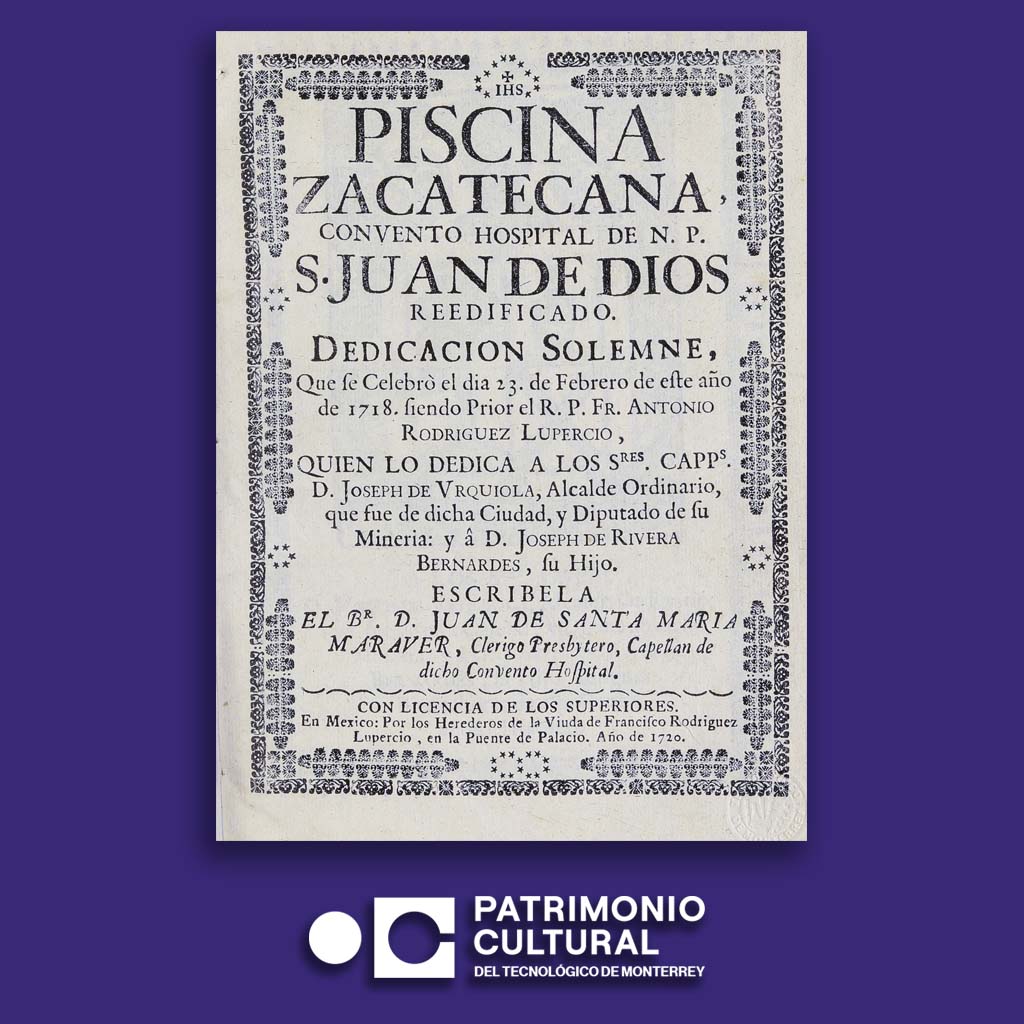
Santa María Maravaer, Juan de. Piscina zacatecana, convento hospital de N.P.S. Juan de Dios reedificado, 1720. Salvador Ugarte Fund. "Miguel de Cervantes Saavedra" Special Collections Library. Cultural Heritage of Tecnológico de Monterrey©.
Piscina zacatecana is a book dedicated to the rebuilding of the Convent Hospital of Saint John of God, which was celebrated during three whole days, from February 23rd, to the 25th of 1718. The author was Juan de Santa María Maraver. This printed book was sponsored and dedicated to the judicial magistrate José de Urquiola and his son José Rivera de Bernárdez.
This is one of the most important books in Zacatecas, during its colonial period. It describes the city of Zacatecas and writes down the biography oy Friar Ambrosio of Leoz. It also tells the story of the Convent Hospital of Sant John of Good, the celebrations, the participants, the Triumphal Arch, and the literary contest in honor of the rebuilding, as well as the winners of said contest, titled Palestra ingeniosa, que a la Dedicación del Convento Hospital de N.P. San Juan de Dios Celebraron los ingenios zacatecanos.
Piscina zacatecana is a text of great importance for the study of the city's History and of the Brothers Hospitallers Order.
This work is available for consultation in the Institutional Repository of Tecnológico de Monterrey through the following link: https://hdl.handle.net/11285/649831
August 2023

Mexiac, Adolfo, XX Aniversario VI, 1996. Serigraphy, 28 x 21 cm. D.R.© Adolfo Mexiac/SOMAAP/México/2023. Cultural Heritage of Tecnológico de Monterrey©.
Adolfo Mexiac (1927-2019) was a prominent Michoacan engraver and painter dedicated to expressing in his works the most significant moments of Mexico that he lived through. Mexiac was trained in the main academic institutions such as the Morelia National School of Arts, the San Carlos Academy and the "La Esmeralda" National School of Painting, Sculpture and Engraving.
Mexiac in XX Aniversario VI depicts in descending order the letters that give this work its name and ends it with the dates that commemorate the 20th anniversary of the Tecnológico de Monterrey, Campus Estado de México, 1976-1996. This graphic work is a serigraphy that Mexiac made with 6 inks on a paper and that concludes with the signature of the same author.
This work is available for consultation in the Institutional Repository of Tecnológico de Monterrey through the following link: https://hdl.handle.net/11285/638818
September 2023

Feminine title by the Tecnológico de Monterrey, 1978. Facsimile print on Fabriano paper, 22 x 28 cm, courtesy of Elsa Virginia Gutiérrez González.
Before 1978, the academic degrees of women were issued in the male form. The Tecnológico de Monterrey was the first institution in Latin America to do it for women. This milestone was possible thanks to the management of Professor Rosaura Barahona.
We invite you to visit the temporary exhibition in conmemoration of the 80th anniversary of our institution "When the Thread Becomes a Net. A Living Memory of Women at Tecnológico de Monterrey" on the Monterrey campus (as of August 31), Querétaro (September 27), Mexico City (October 19) and Guadalajara (November 9).
October 2023
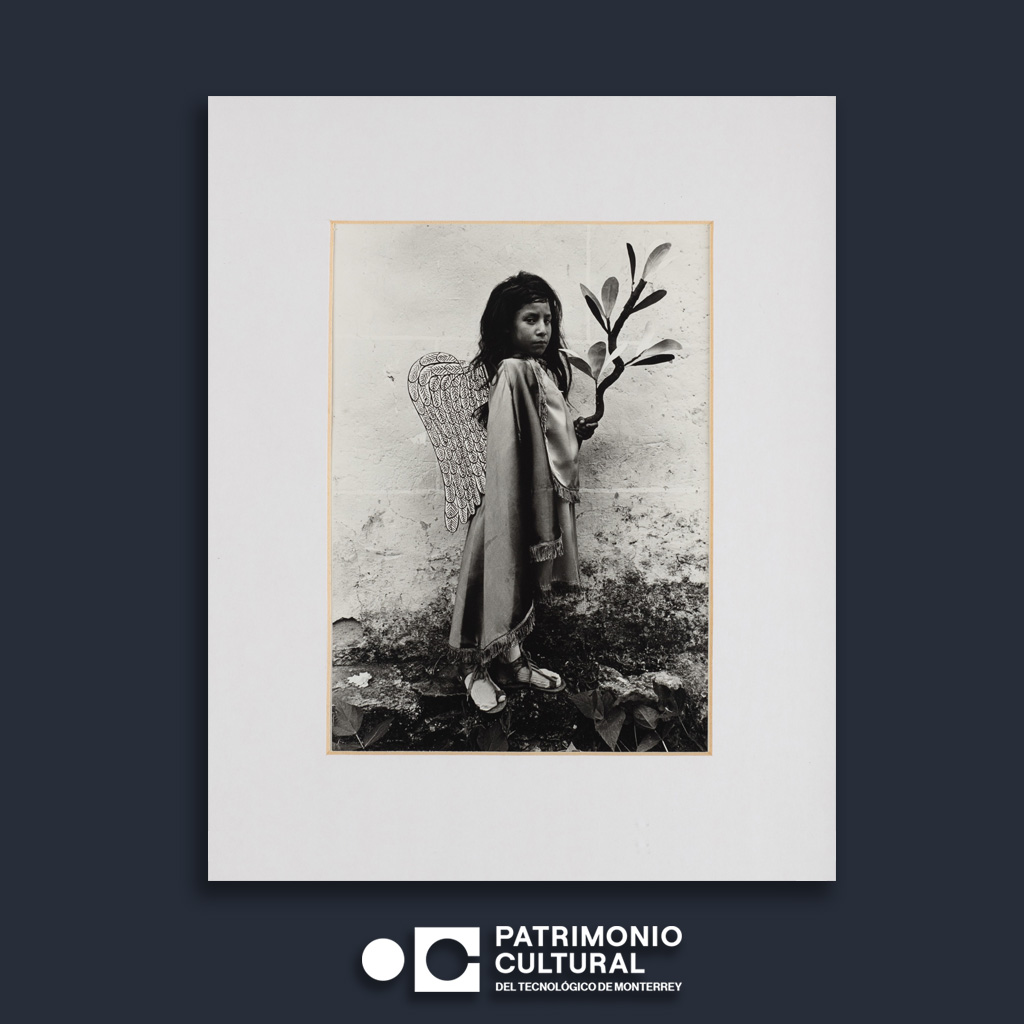
Iturbide, Graciela, Angelito mexicano, 1984. Gelatine silver, 39 x 46 cm. Campus Estado de México. Cultural Heritage of Tecnológico de Monterrey©.
This image was taken by the renowned Mexican photographer Graciela Iturbide (1942) during a Holy Week representation of in Chalma, State of Mexico. The central character wears a ritual costume and a Palm Sunday palm, which makes him a symbol of the cultural and religious wealth of Mexico. Graciela Itirbide is recognized for her sensitive approach to the domestic, political and religious life of women in the indigenous peoples of our country. Its framing pays special attention to local traditions. The gaze of the person portrayed invites us to reflect on the various conditions that influence their life, including social, gender, cultural and ethnic conditions. This leads us to consider the intersectionality present in Mexican culture, that is, how various identities and factors intertwine and affect a person's experience.
To learn more about the role of women in the production, transmission and experience of culture, we invite you to visit the temporary exhibition in conmemoration of the 80th anniversary of our institution "When the Thread Becomes a Net. A Living Memory of Women at Tecnológico de Monterrey" on the Monterrey campus (already inaugurated), Querétaro (already inaugurated), Mexico City (since October 19) and Guadalajara (since November 9).
November 2023

Zamora, Guillermo, Centro Urbano Presidente Miguel Alemán, 1949. Printed in duotone, 4 x 5 inches. Personal Archive of Architect Mario Pani Darqui Fund. Photolibrary of Tecnológico de Monterrey "Miguel de Cervantes Saavedra" Special Collections Library. Memory of the World Registry of Mexico, UNESCO, 2016. Campus Monterrey. Cultural Heritage of Tecnológico de Monterrey©.
Guillermo Zamora (1915-2002) was a pioneer of photography as a documentary record of works of art and architecture. He studied art at the San Carlos Academy, whose training contributed to esthetic capturing architectural forms. Zamora established himself as one of the best go-to photographers for modern Mexican architects, especially in projects in Mexico City.
The photograph highlights a group of women and children in a garden, in front of one of the administrative buildings of the Presidente Miguel Alemán Urban Center. In the background you can see the multi-family housing complex that marked a change in the conception of spaces for modern families in Mexico City. Mario Pani's architectural vision, influenced by the principles of Le Carbusier, focused on optimizing space, providing functionality and recreation areas for its residents.
We invite you to visit the temporary exhibition in conmemoration of the 80th anniversary of our institution "When the Thread Becomes a Net. A Living Memory of Women at Tecnológico de Monterrey" at Mexico City Campus where you can see the reproduction of this and other photographs by Guillermo Zamora from the Personal Archive of Architect Mario Pani Darqui Fund.
This work is also available for consultation in the Institutional Repository of the Tecnológico de Monterrey through the following link: http://hdl.handle.net/11285/591741
December 2023
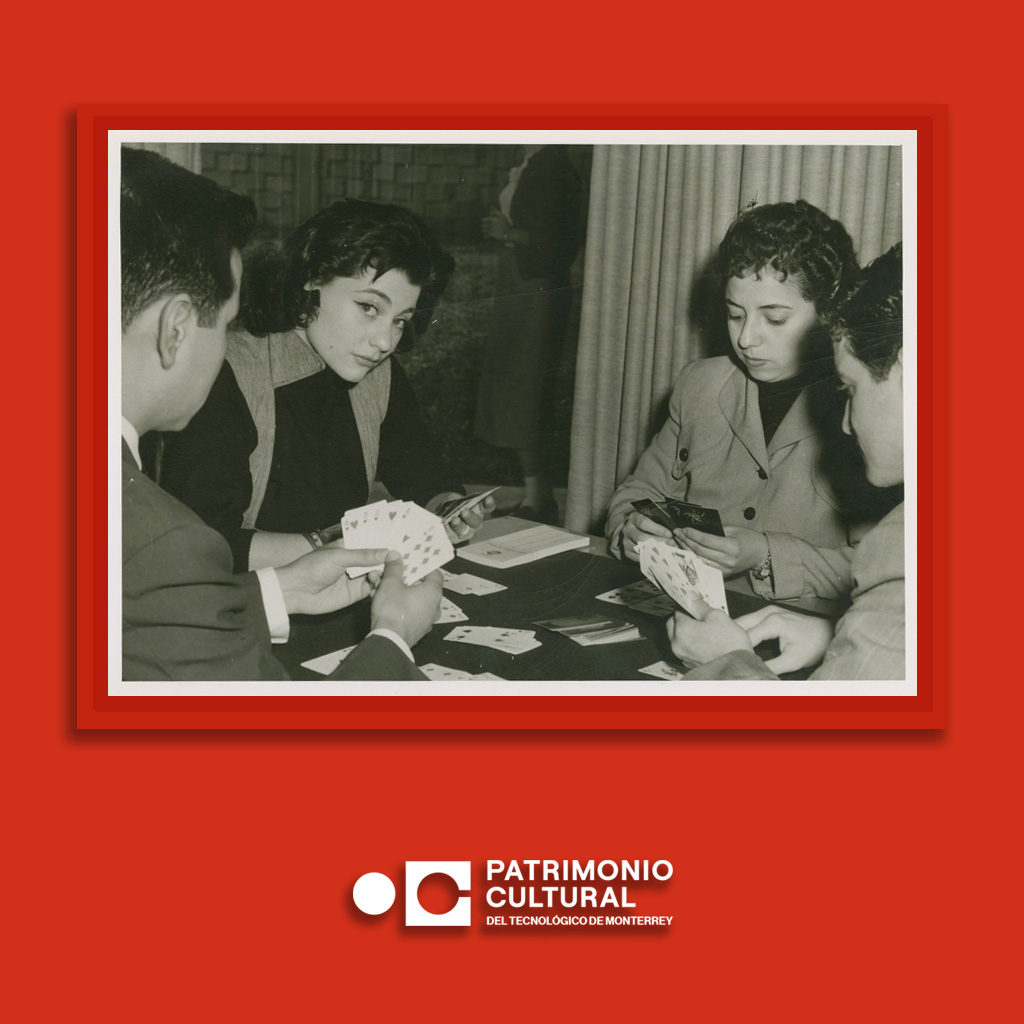
Unidentified. Playing cards, 1950. Printed in duotone, 5 x 7 inches. Memoria Tec Fund. Photolibrary of Tecnológico de Monterrey "Miguel de Cervantes Saavedra" Special Collections Library. Campus Monterrey. Cultural Heritage of Tecnológico de Monterrey©.
Photography is a window into human and social complexity that preserves moments and narratives that we can reinterpret and invite reflection from our current context.
Playing Cards is a snapshot that captures a unique moment in time, revealing the social dynamics of a group of young people immersed in the card game. This visual document not only documets the playful activity, but also provides a window into the interactions and emotions present at that moment. The concentrated attention of three players contrasts with the receptive and subtly challenging expression of the girl on the left, who, by directing her gaze towards the camera, adds an additional layer of meaning, suggesting a direct connection between the observer and the photographed subjects. In this context, this photograph emerges as a valuable cultural testimony, where a direct look provides the possibility of a woman who perhaps resists from an individual perspective against the norm or gender mandates.
We invite you to visit the temporary exhibition in commemoration of the 80th anniversary "When the Thread Becomes a network. Living Memory of Women at Tecnológico de Monterrey" where it is proposed to make visible the role of women in the institution and the challenges they have faced since different angles. The exhibition is divided into four campuses: Monterrey, Urdir la trama; Querétaro, Recaudo de palabras; México City, Tejer la modernidad and Guadalajara Resistir en los retazos. The four venues will last for two semesters from their inauguration.
This work is also available for consultation in the Institutional Repository of the Tecnológico de Monterrey through the following link: http://hdl.handle.net/11285/584384
January 2024
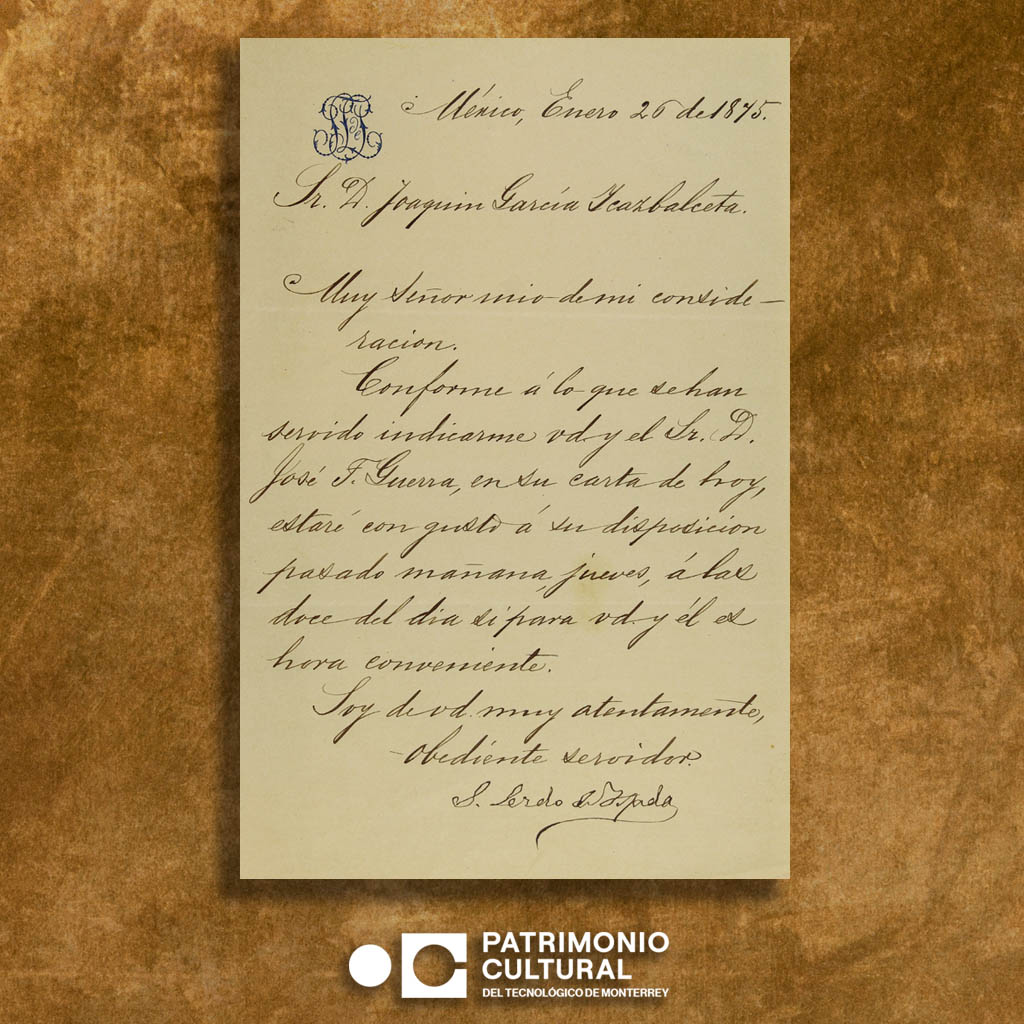
Letter from Sebastián Lerdo de Tejada to Joaquín García Icazbalceta, 1875. Historical Archive Fund of Real Caja de Zacatecas 1576-1936. Collection of the Society of Friends of Zacatecas, A.C. on loan to Tecnológico de Monterrey©. Memory of the World Registry of México, UNESCO, 2021. Cultural Heritage of Tecnologico de Monterrey©.
In this letter, two personalities from the last quarter of the 19th century stand out, Sebastián Lerdo de Tejada and Joaquín García Icazbalceta. The first, for assuming the presidency of México after the death of Benito Juárez and the second, for being secretary and later director of the Mexican Academy of Language.
The beauty of this document lies in the initials or acronym of the letterhead with Art Nouveau style floral details in blue, in which Sebastián Lerdo de Tejada responds to Joaquín García Icazbalceta, as well as the rubric of the president of México.
This work is also available for consultation in the Institutional Repository of Tecnológico de Monterrey through the following link:
February 2024
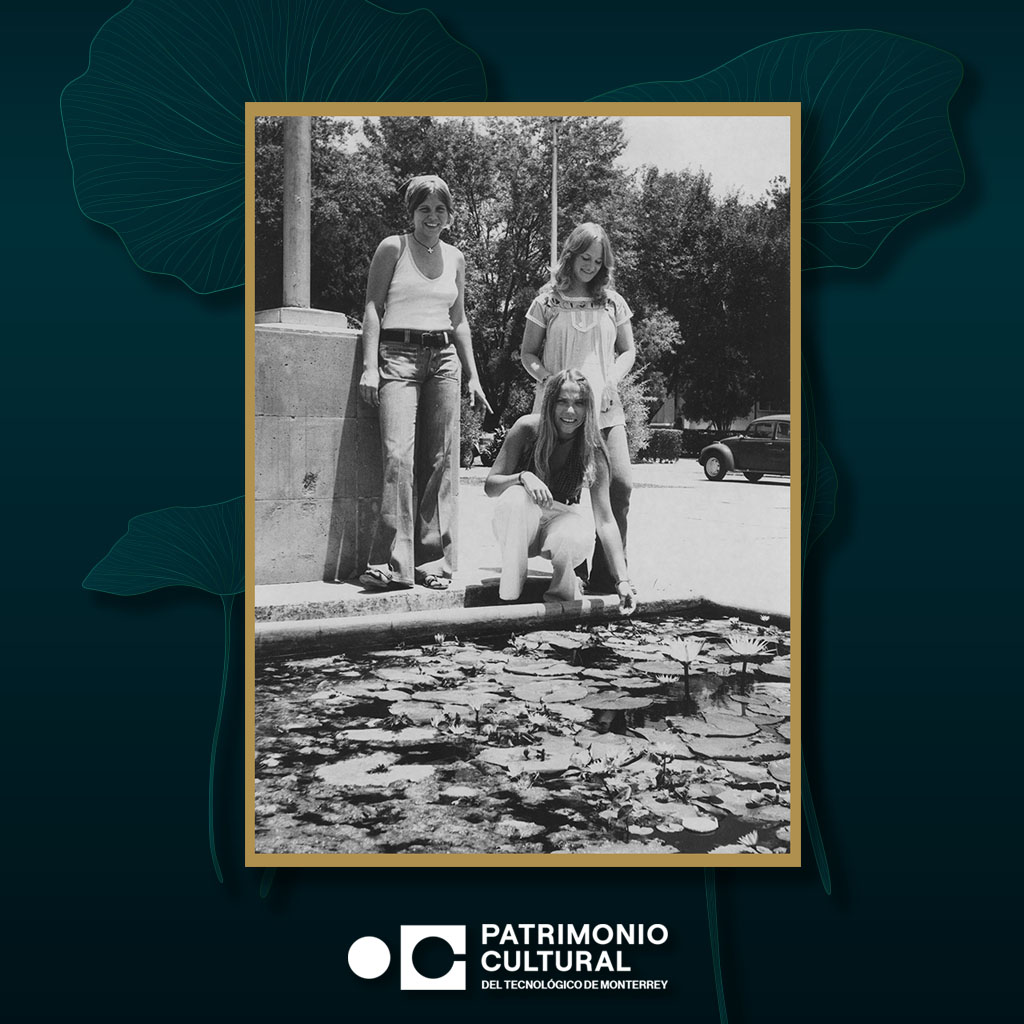
Summer School Students, 1972. Printed in duotone, 5 x 7 inches. Campus Monterrey. "Miguel de Cervantes de Saavedra" Special Collections Library. Cultural Heritage of Tecnologico de Monterrey©.
This black and white photograph portrays three schoolgirls during the 70's. The portrait shows the coexistence, recreation and style of drees of those who participated during their stay at the Summer School at Campus Monterrey.
Tec Memory Fund guards historical images that show us a window to the past in order to understand how was the students experience during that time.
This document is also available for consultation in the Institutional Repository of Tecnológico de Monterrey through the following link: http://hdl.handle.net/11285/584573
March 2024
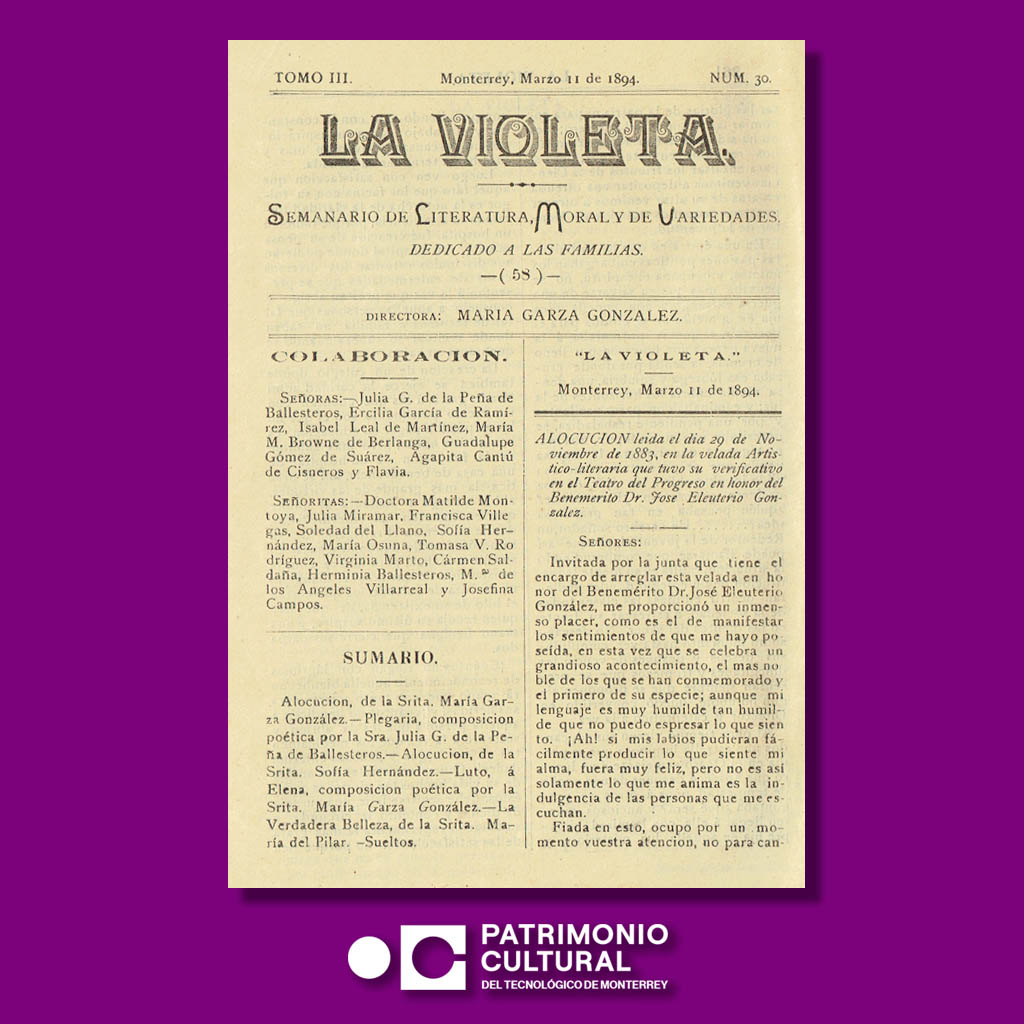
The Violet. Biweekly of Literature, Social, Moral and Variety. Monterrey, 1887-1894. Collection donated by Martha Nualart Sánchez, great-granddaughter of Josefa Cornada Eligia Jinénez García (1865-1911), collaborator of "The Violet. Biweekly of literature, social, moral and variety". Exchanges and donations Fund. "Miguel de Cervantes Saavedra" Special Collections Library. Cultural Heritage of Tecnológico de Monterrey©.
This nineteenth-century magazine is one of the first prints to be managed, written and published by women from Monterrey. So far, only three other Mexican magazines with these same characteristics have been located.
This copy of The Violet is made up of a binding that preserves three volumes of said publication. In total, it contains fifty-nine editions in newspaper paper and ink.
This publication allowed the Porfirian women of Northern Mexico to disseminate their literary writings in varius genres, express their ideas about cultural management, among other topics, which generated the interweaving of female networks of readers with content created and designed for women.
This work is also available for consultation in the Institutional Repository of the Tecnológico de Monterrey through the following link: https://hdl.handle.net/11285/650987
April 2024
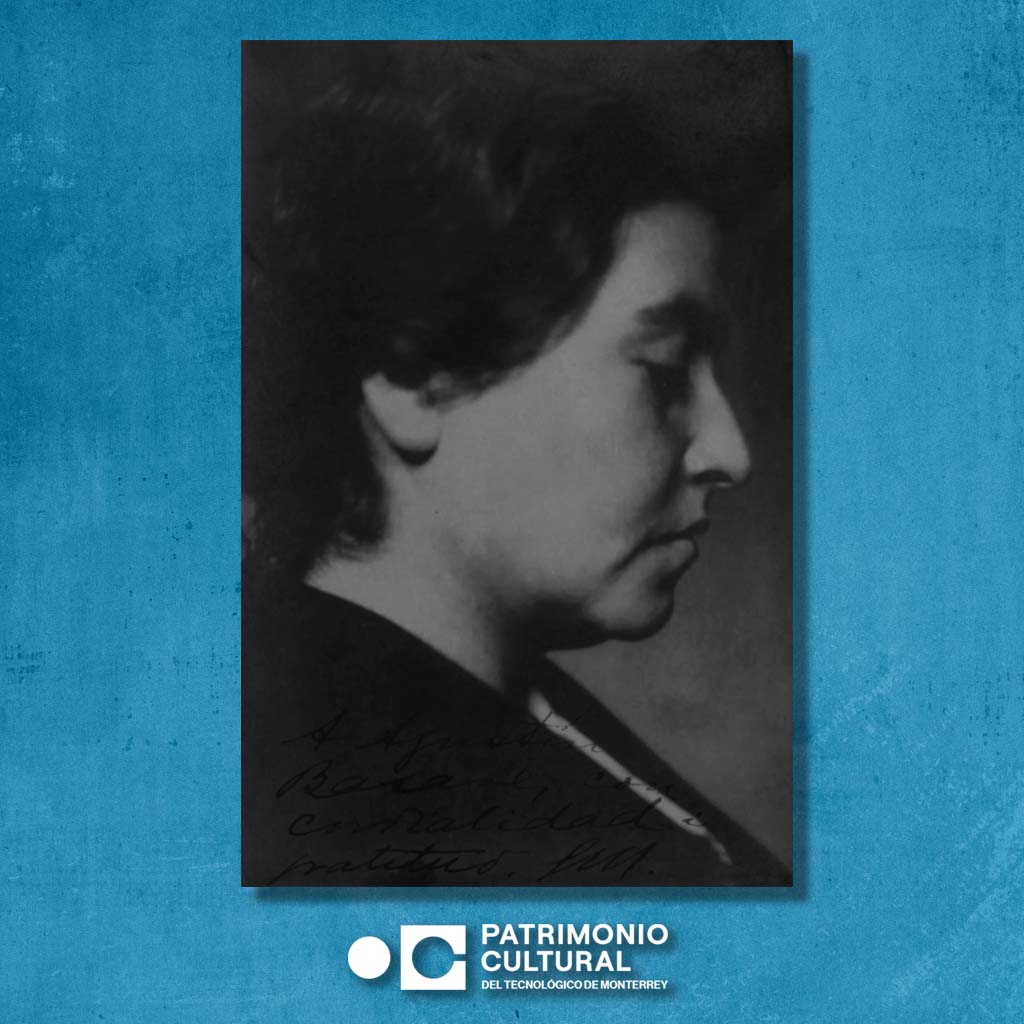
Autographed Picture of Gabriela Mistral (1889-1957). Campus Monterrey. Agustín Basave Fund. Photolibrary of Tecnológico de Monterrey. "Miguel de Cervantes Saavedra" Special Collections Library. Cultural Heritage of Tecnológico de Monterrey©.
The profile portrait of the poet Gabriela Mistral, 1945 Nobel Prize in Literature, is a meaningful testimony of her worldwide importance, as the first Latin American woman poet to obtain such Prize.
The photograph was signed and dedicated to the director of the newspaper El Norte, who made up the documentary collection that includes autographs, photographs and portraits of prominent protagonists in world history of the 20th century. Agustín Basave donated this fund to the Tecnológico de Monterrey in 1955.
Lucila de María Godoy Alcayaga, real name of Gabriela Mistral, was born in Chile on April 7th, 1889. In addition to being a diplomat, she worked as a teacher, collaborated with the Government of Mexico in the trainig of teachers and in the design of what became the Secretariat of Public Education. Her poetic work influenced great writers such as Rosario Castellanos, Pablo Neruda and Octavio Paz.
This work is also available for consultation in the Institutional Repository of Tecnológico de Monterrey through the following link: http://hdl.handle.net/11285/625062
May 2024
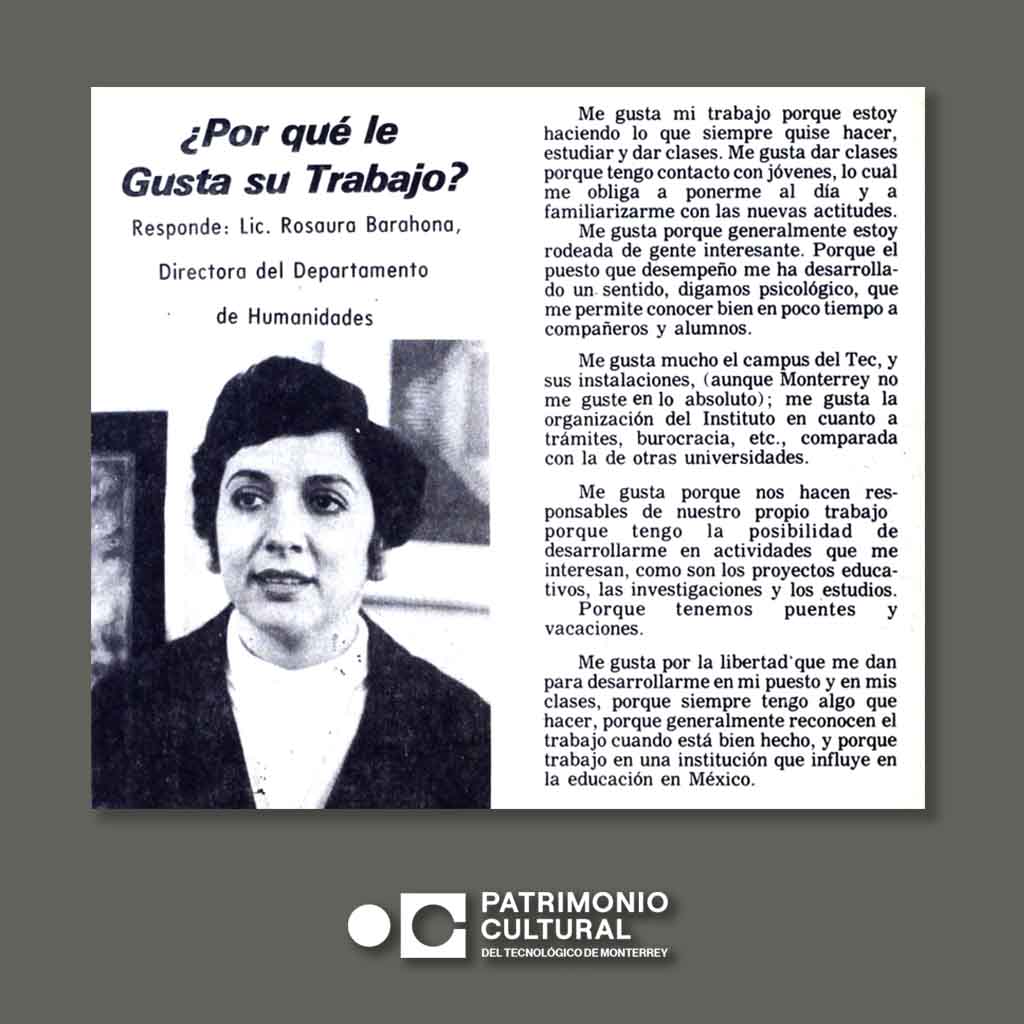
"Why do you like your job?" Interview with Rosaura Barahona published in Panorama, 1977. Tec Memory Fund. "Miguel de Cervantes de Saavedra" Special Collections Library. Cultural Heritage of Tecnológico de Monterrey©.
Panorama (1966-2017) was a weekly publication of the Monterrey Campus that reported important news to the entire community.
Interview with Rosaura Barahona Aguayo (1942-2017), journalist, writer and academic, published in the magazine Panorama (1966-2017), where she talks about the enjoyment of the work as a teacher and director of the Departament of Humanities at Tec de Monterrey.
Barahona was a promoter of gender equality at the institution, where she is renowned for her drive for Tec to be the first institution in Latin America to issue academic degrees in feminine.
June 2024
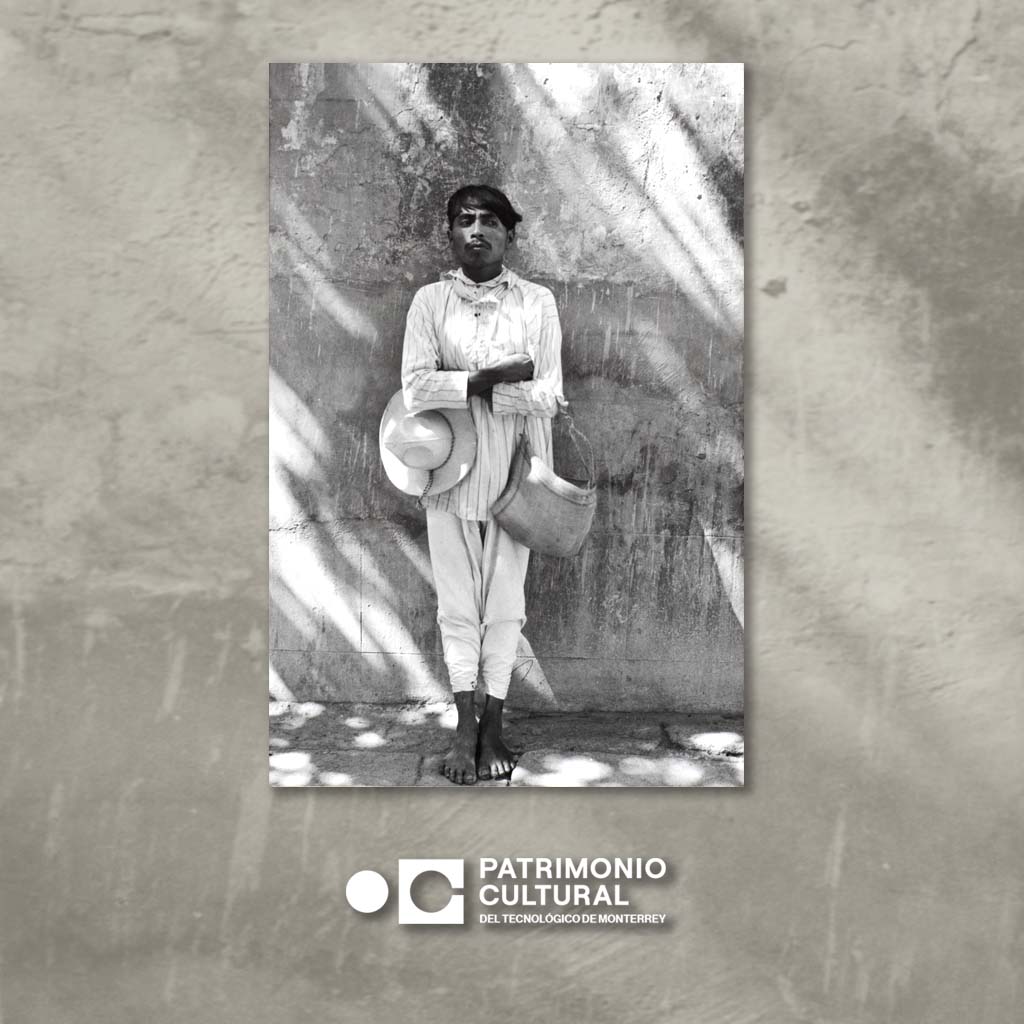
Manuel Álvarez Bravo (1902), The Man from Papantla, 1977. Gelatin silver print, 39 x 46.2 cm. Campus Estado de México. Cultural Heritage of Tecnológico de de Monterrey©.
Manuel álvarez Bravo is one of Mexico's most important photographers and a pioneer of modern photography in Latin America. His career spanned much of the 20th century, and his work is know for capturing the essence of Mexican life through his poetic and symbolic images.
The picture shows a man in rural attire posing in front of a rustic wall. The central composition is broken by the diagonals of light and shadow, which highlight the details of surroundings and the character. The title refers to Papantla, a city in the state of Veracruz, famous for its cultural traditions, such as the Voladores de Papantla, a ritual dance of this indigenous community.
This photographer's work has been fundamental to the understandig and appreciation of imagery in Mexico due to this ability to combine photographic technique with a deep sensitivity to the cultural surroundings. Photographs like this are not only visual representations, but also a testament to the cultural roots and identity of Mexico.
This work is also available for consultation in the Institutional Repository of the Tecnológico de Monterrey through the following link: https://hdl.handle.net/11285/676002
July 2024
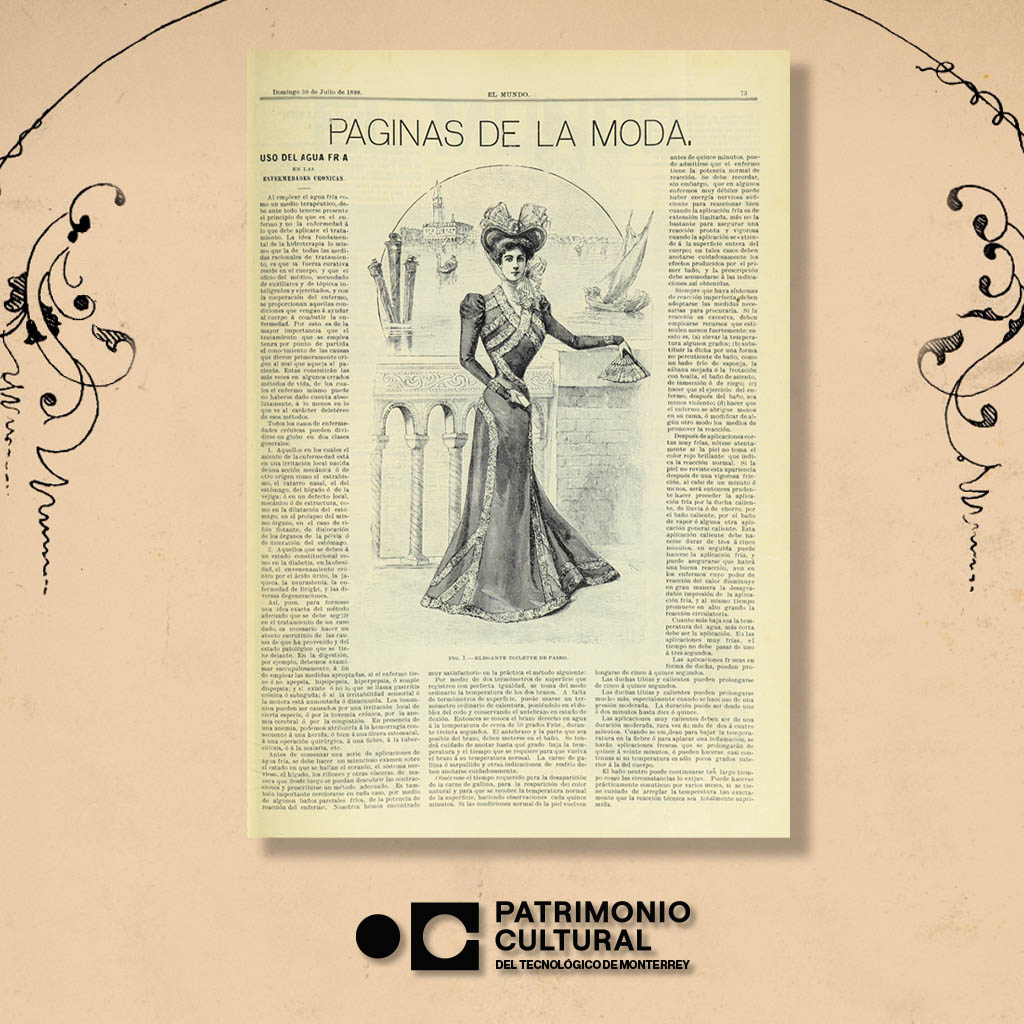
El Mundo Ilustrado, 1899, year 6, volume 2, no. 1-27. Campus Monterrey. Hemerographic Fund. "Miguel de Cervantes Saavedra" Special Collections Library. Cultural Heritage of Tecnológico de Monterrey©.
The Hemerographic fund is one of the most important holdings safeguarded by the Cervantine Library. It consists of various periodical publications from the 19th and 20th centuries, among which the weekly publication El Mundo Ilustrado stands out.
Rafael Reyes Spíndola was the creator of this weekly newspaper in October 1894, in Puebla. The main objective of this weekly publication was to recap the most important events in Europe and Mexico. Its sections included notable figures in politics, historical figures, monuments, exhibitions, and customs of Mexico and the world. It also contained sections such as: short stories, novels, recipes, science, technology, and fashion.
The relevance of this weekly newspaper lay in the engravings and photographs that were included within its contents. The Elegante toilette de paseo (Elegant promenade outfit) shown here is an example of how fashion for Porfirian ladies was disseminated; not only was the image provided, but also a descrption of the attire: "It is made of taffeta, princess style, with an application of wide, embroidered silk braid in very elegant wavy bands. Very severe triangular neckline".
This work is available for consultation in the Institutional Repository of Tecnológico de Monterrey through the following link: https://hdl.handle.net/11285/675788
August 2024
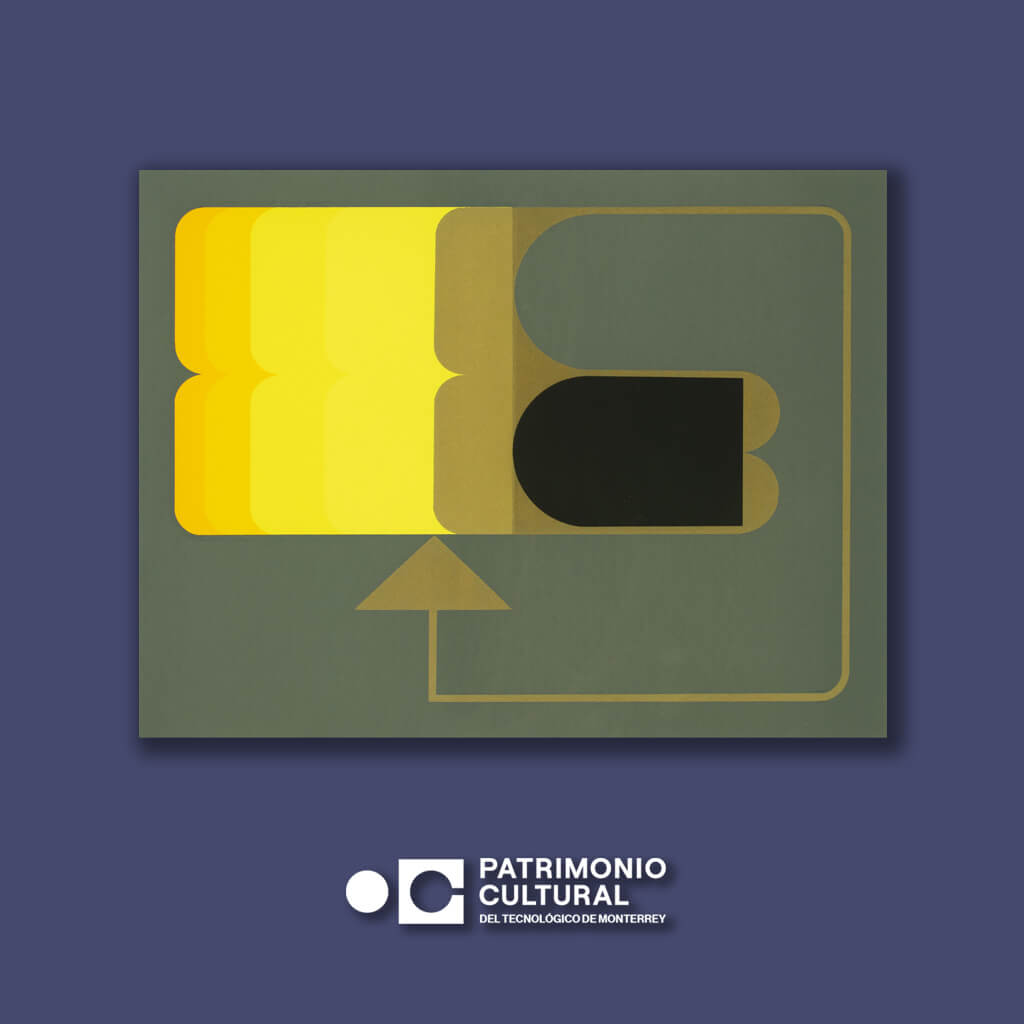
Manuel Felguérez (1928-2020), Sin título (from the project Multiple Space), ca. 1970-1980. Serigraphy, 72.5 x 82.5 cm. Campus Estado de México. Cultural Heritage of Tecnológico de Monterrey©.
Manuel Felguérez was a painter, printmaker, and sculptor from Zacatecas, México. He is recognized as one first artists to use computers as tool to approach aesthetics from a mathematical logic perspective in the search for a connection between geometry and emotion. His influence on Mexican art is of paramount importance due to his leading role in the Mexican avant-garde. He is credited with the development of a unique modern abstract language which had a great impact on the next generations of contemporary artists.
This piece dates back to the 1970's, a period in which Felguérez developed his "The Aesthetic Machine" series. With it, Felguérez explored the Theory of System Identification to investigate how computers could predict the evolution of his own visual language. Additionally, during this time he experimented with innovative printing techniques and materials as a way to show the role that technology has in the processes of artistic creation.
This work is testimony to the ideological shift in the relation ship between art and technology happening during the 1970's. It high lights the importance of innovation and technical experimentation in ways that went beyond the formal concerns of the Mexican School of Painiting.
"The artist in general, and I in particular, is always seeking constant renewal, a constant contribution, an invention, a new vision".
Manuel Felguérez
This work is available for consultation in the Institutional Repository of Tecnológico de Monterrey through the following link: https://repositorio.tec.mx/handle/11285/676071
September 2024
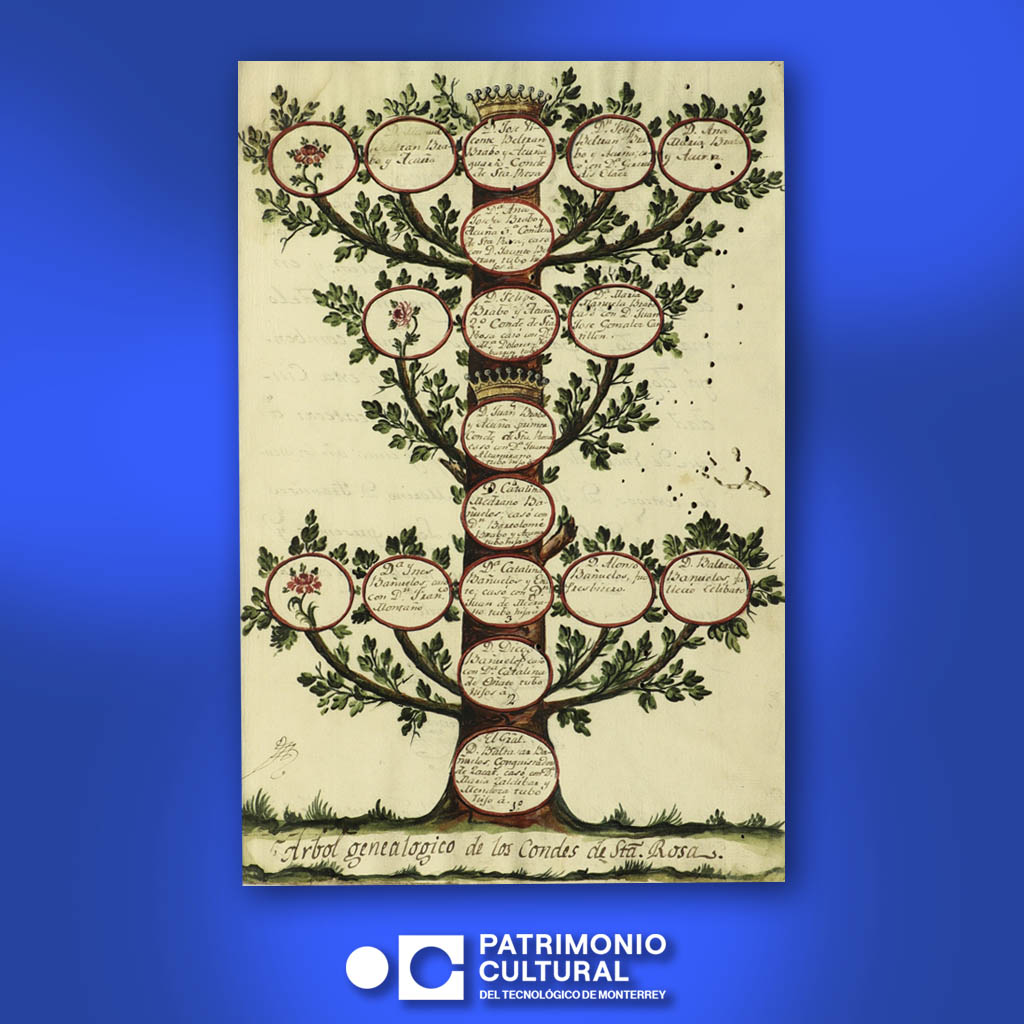
Relation of the Merits and Services of the Counts of Santa Rosa and Their Ancestors and Descendants, 1797. Campus Monterrey. Pedro Robredo Fund. "Miguel de Cervantes Saavedra" Special Collections Library" Cultural Heritage of Tecnológico de Monterrey©.
The reports of merits and services were common in New Spain to demosntrate the work done by the Spanish crow and to obtain privileges.
The "Family Tree of the Counts of Santa Rosa" is part of the Relation of the Merits and Services of the Counts of Santa Rosa and Their Ancestors and Descendants, in which Juan Bravo de Medrano, the first Count of Santa Rosa, demonstrates his Spanish ancestry and the contributions he made to the Spanish crow to obtain the title. In this tree, the trunk represents the origin, and the branches show the descendants, the bearers of this privilege. Notable features include the two crowns in the center and the top of the tree, as well as the flowers placed in the empty spaces.
This document is significant because it not only ilustrates the operation of New Spain's society through a family tree but also traces the lineage of the first nobility in Zacatecas.
This work is also available for consultation in the Institutional Repository of the Tecnológico de Monterrey through the following link: https://hdl.handle.net/11285/657139
October 2024
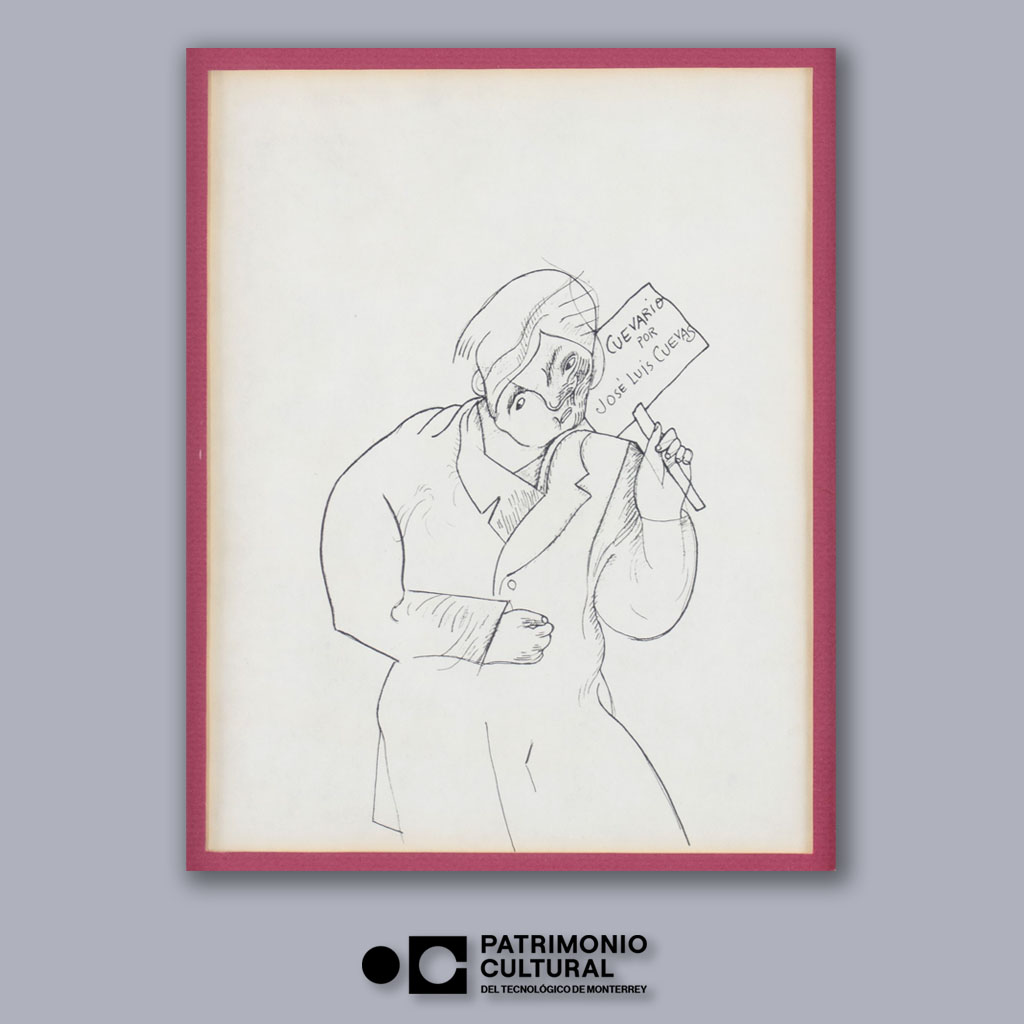
José Luis Cuevas (1934-2017), Viñeta para Cuevario/El Cuevario de José Luis Cuevas, 1989. Campus Estado de México. Cultural Heritage of Tecnológico de Monterrey©.
José Luis Cuevas (1934-2017) was a prominent Mexican artist, considered part of artists know as the "Rupture" generation. These artists rejected the precepts of Mexican muralism and proposed exploring art from a more personal way and far from the official paradigms of art. Cuevas work is deeply marked by themes of alienation, exostencial anguish, and a critique of social and political conventions. Cuevas was self-taught, which allowed him to develop a unique style that combined drawing, painting, sculpture and literature.
Cuevas created a universe that he reflected in both images and words. He was an avid reader who, due to a sicly and fragile condition, dedicated his convalescence to reading and drawing, prints paintings and sculptures, however, he was also prolific in writing. Particularly in a column in the cultural pages of El Búho of the Excélsior newspaper know as "Cuevario". For more than six years, this column was published weekly, every Monday. Later he also published in El Universal from 1999 to 2007.
Through the Cuevario, the artist established a dialogue between the individual and society, raising questions about identity politics in Mexico, madness, women and his own life. His written work was accompanied by drawings that, beyond their cartoonish appearance, invite reflection on the dark forces the inhabit each human being and society in general.
This work is also available for consultation in the Institutional Repository of the Tecnológico de Monterrey through the following link: https://hdl.handle.net/11285/675920
November 2024
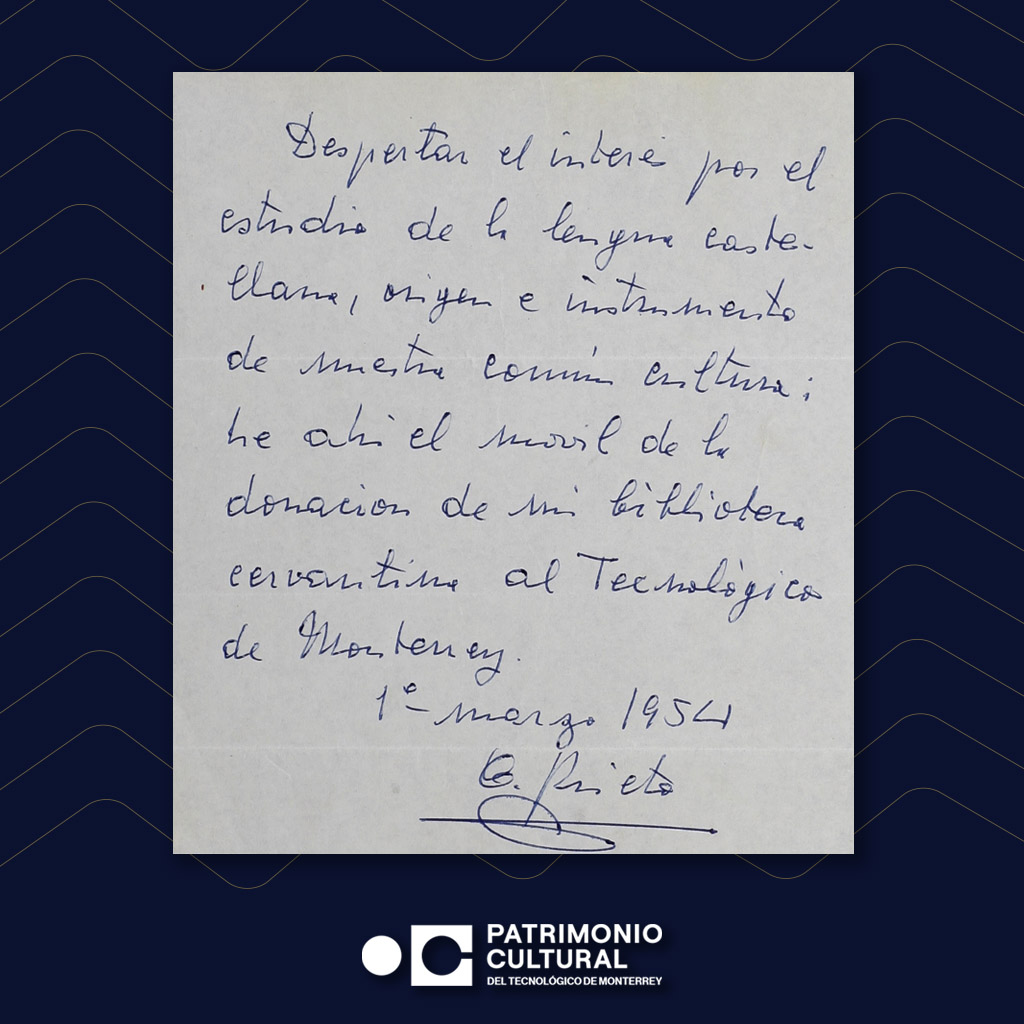
Carlos Prieto, Note explainig the donation of the Cervantina, 1954. Campus Monterrey. Agustín Basave Fund. Photolibrary of Tecnológico de Monterrey. "Miguel de Cervantes Saavedra" Special Collections Library. Cultural Heritage of Tecnológico de Monterrey©.
In this document Carlos Prieto explains the reasons behind the donation of his collection of books of The Ingenious Hidalgo Don Quijote de la Manche by Miguel de Cervantes Saavedra, in editions from different periods and languages, considered the crowning work of the Spanish language. Prieto points out that this donation seeks to enrich the cultural value of Spanish and this great literary work. Furthermore, he expresses that his gesure is a sign of gratitude towards Monterrey, a city that has been fundamental in his life and to which he wishes to contribute a lasting cultural legacy.
Thanks to this donation from the Monterrey businessman Carlos Prieto, the "Miguel de Cervantes Saavedra" Special Collection Library or the "Cervantina" as it is affectionately know, there would be added others over the years, all focused on the study the humanities. Currently, the Cervantina has 28 documentary funds.
This year the "Miguel de Cervantes Saavedra" Special Collections Library celebrates its 70th anniversary, for this, it prepared the Second Congress of the Mexican Association of Cervantes that will take place from November 4 to 6 on the third floor of the Rectory bulding, Monterrey Campus.
This work is also available for consultation in the Institutional Repository of the Tecnológico de Monterrey through the following link: http://hdl.handle.net/11285/622726
December 2024
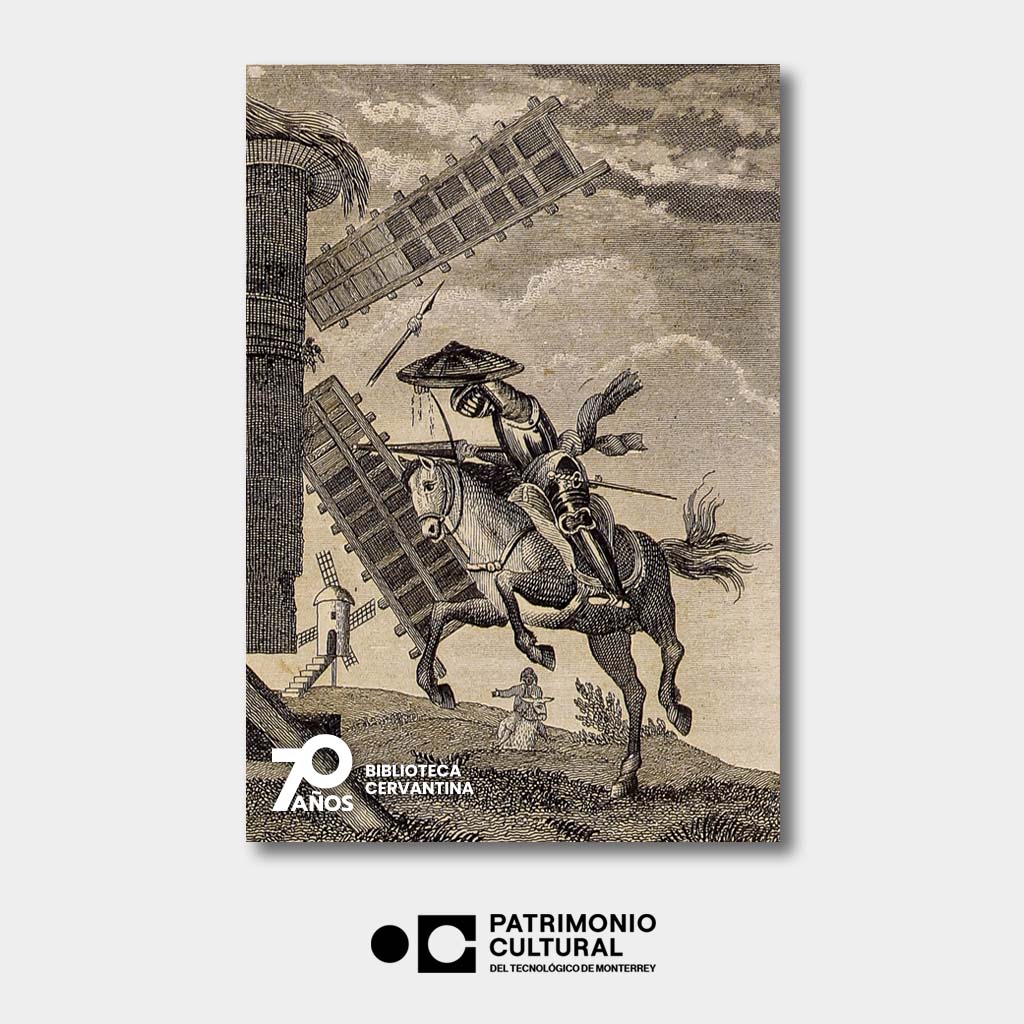
Miguel de Cervantes Saavedra (1547-1616), The Ingenious Hidalgo Don Quijote de la Manche, 1833. First mexican edition by Mariano Arévalo. Campus Monterrey. Carlos Prieto Fund, "Cervantina Collection". "Miguel de Cervantes Saavedra" Special Collections Library. Cultural Heritage of Tecnológico de Monterrey©.
The first Mexican edition of The Ingenious Hidalgo Don Quijote de la Manche was printed by Mariano Arévalo in 5 volumes in 1833. It contains several prints, based on drawings by Isidro and Antonio Carnicero, which ilustrate relevant episodes of the story and were made in drypoint on copper.
The engraving in the picture holds the title of "Don Quixote attacks windmills" and it ilustrates one of the most famous episodes of the Cervantine novel.
The first Mexican Quixote is a very rare book guarded by the Special Collections Library "Miguel de Cervantes Saavedra". This edition has been part of Tecológico de Monterrey since 1954. This year we celebrate its 70th anniversary.
Links of interest: Go to Cultural Heritage >